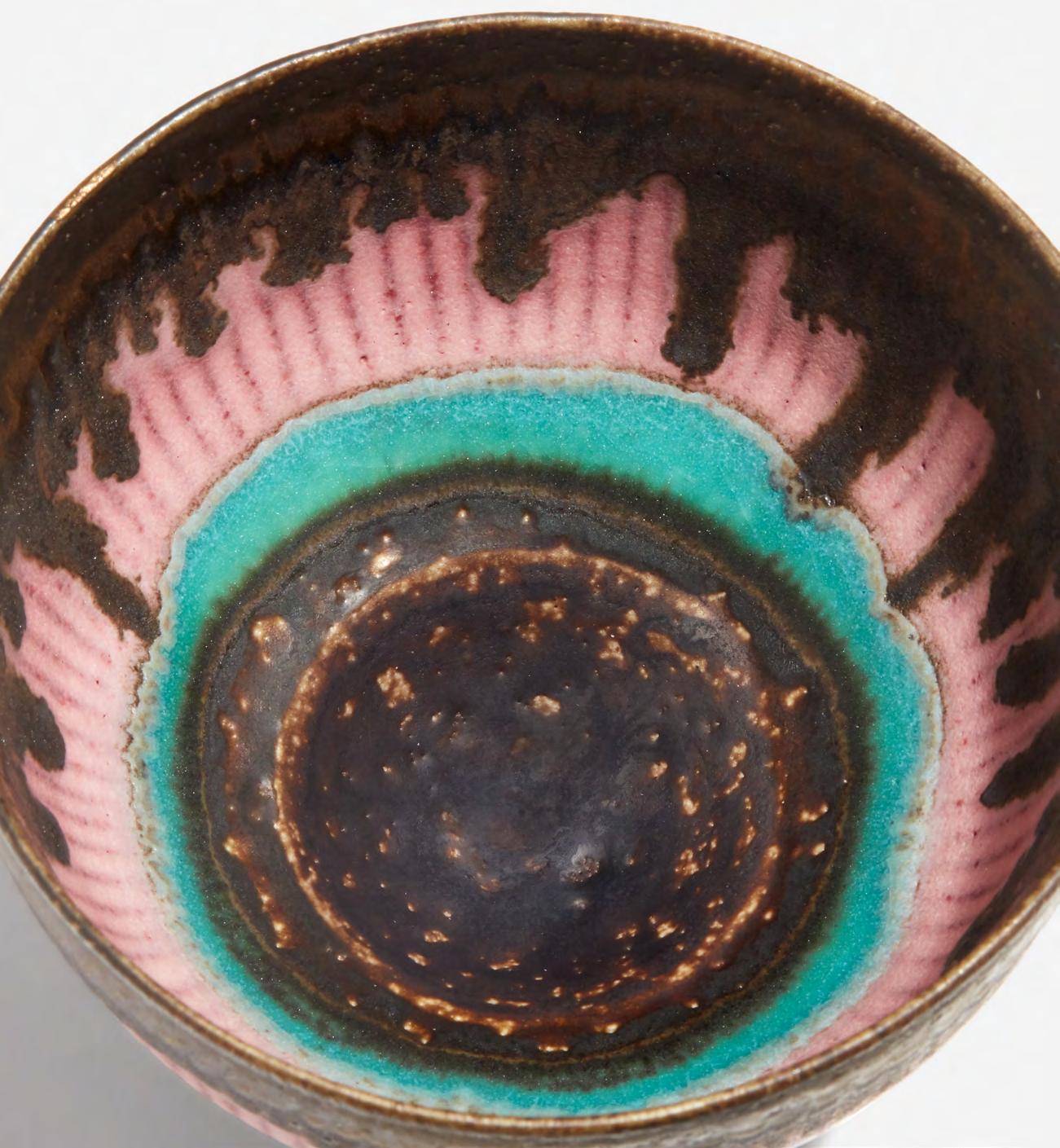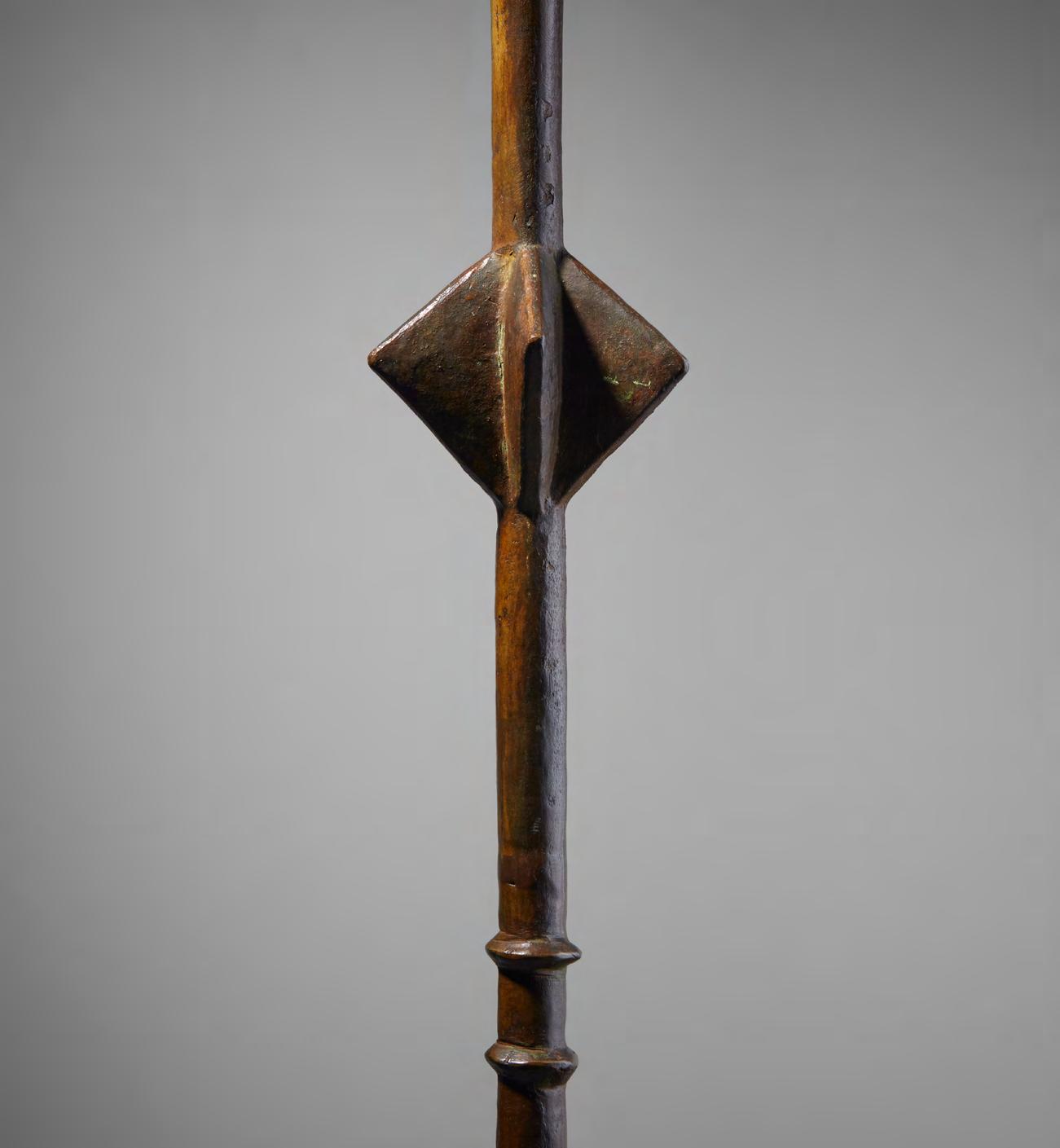New York / 7 December 2022







New York / 7 December 2022






New York / 7 December 2022
Auction & Viewing Location
432 Park Avenue, New York, NY 10022
Auction
Wednesday, 7 December at 2pm
Viewing 1–7 December 2022 Monday–Saturday 10am–6pm Sunday 12pm–6pm
When sending in written bids or making enquiries please refer to this sale as NY050522 or Design.
Absentee and Telephone Bids
Tel +1 212 940 1228 Fax +1 212 940 1749 bidsnewyork@phillips.com
Design Department
Head of Department, New York Cordelia Lembo clembo@phillips.com
Head of Design, West Coast, Senior International Specialist Meaghan Roddy mroddy@phillips.com
Senior International Specialist Beth Vilinsky bvilinsky@phillips.com
Specialist
Kimberly Sørensen ksorensen@phillips.com
Associate Specialist, Associate Head of Sale Benjamin Green bgreen@phillips.com
Administrator
Cecilia Moure cmoure@phillips.com

Cordelia Lembo

Head of Department +1 212 940 1265 clembo@phillips.com
London
Beth Vilinsky
Senior International Specialist, Americas +1 347 302 5255 bvilinsky@phillips.com
Kimberly Sørensen
Specialist
+1 212 940 1259 ksorensen@phillips.com
Benjamin Green
Associate Specialist, Associate Head of Sale +1 212 940 1267 bgreen@phillips.com
Meaghan
Head of Design, West Coast, Senior International Specialist, Americas +1 267 221 9152 mroddy@phillips.com
Domenico Raimondo

Head of Department, Europe & Senior International Specialist +44 20 7318 4016
draimondo@phillips.com
Antonia King
Head of Sale







+44 20 7901 7944 antonia.king@phillips.com
Sofia Sayn-Wittgenstein


Senior Specialist +44 20 7318 4023 ssayn-wittgenstein@phillips.com
Paris
Madalena Horta e Costa Specialist +44 20 7318 4019
mhortaecosta@phillips.com

Margherita Manca
Cataloguer +44 20 7901 7926 mmanca@phillips.com
Carlotta Pintucci
Assistant to Head of Design, Europe, Research Coordinator +44 20 7318 4096 cpintucci@phillips.com
Elie Massaoutis
Head of Design, France, Senior International Specialist +33 7 86 34 53 15 emassaoutis@phillips.com
Edward Dolman
Executive Chairman
+1 212 940 1241 edolman@phillips.com © Brigitte Lacombe
Cheyenne Westphal
Global Chairwoman
+44 20 7318 4044 cwestphal@phillips.com
Jonathan Crockett
Chairman, Asia, Head of 20th Century & Contemporary Art, Asia +852 2318 2023 jcrockett@phillips.com
Hugues Joffre
Senior Advisor to the CEO +44 207 901 7923 hjoffre@phillips.com
Jamie Niven
Senior Advisor to the CEO +1 917 880 2532 jniven@phillips.com



Stephen Brooks
Chief Executive Officer
+44 0 20 7318 4046 sbrooks@phillips.com
Jean-Paul Engelen





President, Americas, Worldwide Co-Head of 20th Century & Contemporary Art +1 212 940 1390 jpengelen@phillips.com
Arnold Lehman

Senior Advisor to the CEO +1 212 940 1385 alehman@phillips.com
Derek Collins
Senior Consultant to Chairman’s Office, Asia +852 2318 2000 derekcollins@phillips.com
Svetlana
Worldwide Deputy Chairman +44 20 7318 4010 smarich@phillips.com
Deputy Chairman, Worldwide Co-Head of 20th Century & Contemporary Art +1 212 940 1358 rmanley@phillips.com
Peter Sumner
Deputy Chairman, Europe, Senior International Specialist, 20th Century & Contemporary Art +44 20 7318 4063 psumner@phillips.com
Deputy Chairwoman, Head of Private Sales +44 20 7901 7943 mheiden@phillips.com
Vanessa Hallett
Deputy Chairwoman, Americas, Worldwide Head of Photographs +1 212 940 1243 vhallett@phillips.com
Vivian Pfeiffer


Deputy Chairman, Americas, Head of Business Development, Americas +1 212 940 1392 vpfeiffer@phillips.com


Marianne Hoet





Deputy Chairwoman, Europe, Head of Business Development, Europe +32 3257 3026 mhoet@phillips.com

Elizabeth Goldberg

Deputy Chairwoman, Americas, Senior International Specialist, American Art +1 212 940 1239 egoldberg@phillips.com


Jeremiah Evarts
Deputy Chairman, Americas, Senior International Specialist, 20th Century & Contemporary Art +1 917 304 4329 jevarts@phillips.com
Deputy Chairman, Americas, Worldwide Co-Head of Editions +1 212 940 1222 cleibowitz@phillips.com
Deputy Chairwoman, Americas, Worldwide Co-Head of Editions +1 212 940 1221 ktroester@phillips.com
Deputy Chairman, Americas, Senior International Specialist, 20th Century & Contemporary Art +1 212 940 1354 snussbaum@phillips.com
Kevie Yang
Deputy Chairwoman, Americas, Senior International Specialist, 20th Century & Contemporary Art +1 212 940 1254 kyang@phillips.com
Cary Leibowitz Scott NussbaumVivian Pfeiffer
Deputy Chairman, Americas, Head of Business Development, Americas +1 212 940 1392 vpfeiffer@phillips.com
Americas
Philae Knight
Client Advisory Director +1 212 940 1313 pknight@phillips.com
Europe
Giulia Campaner Mendes
Client Advisor +44 20 7318 4058 gcampaner@phillips.com
Laurent Taevernier
Client Liaison Coordinator +32 32 573026 ltaevernier@phillips.com
Asia
Iori Endo
Senior Client Advisor +44 20 7318 4039 iendo@phillips.com
Middle East & South Asia
Yassaman Ali
Client Advisory Director +44 20 7318 4056 yali@phillips.com
Americas
Jennifer Jones
Director of Trusts, Estates & Valuations +1 212 940 1272 jjones@phillips.com
Laura Wenger
Senior Account Manager +1 212 940 1302 lwenger@phillips.com
Diana Willkie
Account Manager & Business Development Associate +1 212 940 1276 dwillkie@phillips.com
Lauren Peterson
Director of Museum & Corporate Collections +1 310 922 2841 lauren.peterson@phillips.com
Our team is comprised of experts from auction houses, museums, galleries and other leading arts institutions. In addition to auctions in our New York, London, Hong Kong and Geneva salerooms, Phillips holds private sales and curated selling exhibitions across all of our categories around the world. Our range of services includes appraisals for private clients, advisors, attorneys and other key fiduciaries, and our dedicated Trusts, Estates & Valuations team provides complimentary reviews of collections.
Cândida Sodré
Regional Director, Consultant, Brazil +55 21 999 817 442 csodre@phillips.com
Sophia Kinell
Regional Representative, San Francisco +1 650 799 7931 sophia.kinell@phillips.com
Nathalie Zaquin-Boulakia
Regional Director, France, Senior International Specialist, 20th Century & Contemporary Art +44 7342 884 127 nzaquin-boulakia@phillips.com
Dr. Nathalie Monbaron
Regional Director, Geneva +41 22 317 81 83 nmonbaron@phillips.com
Jeannette van Campenhout
Senior International Consultant, Latin American Art +34 646 01 07 68 jvancampenhout@phillips.com
Carol Ehlers
Regional Director, Specialist, Photographs, Chicago +1 773 230 9192 cehlers@phillips.com
Silvia Coxe Waltner
Regional Director, Seattle +1 206 604 6695 scwaltner@phillips.com
Regional Director, Dallas +1 214 801 1788 jgoss@phillips.com
Blake Koh
Regional Director, Los Angeles +1 323 383 3266 bkoh@phillips.com
Cecilia Laffan
Regional Director, Consultant, Mexico +52 1 55 5413 9468 claffan@phillips.com
Vivian
Deputy Chairman, Americas, Head of Business Development, Americas, Miami +1 212 940 1392 vpfeiffer@phillips.com
Kyoko Hattori
Regional Director, Japan +81 3 6273 4818 khattori@phillips.com
Cindy Yen
General Manager, Taiwan +886 2 2758 5505 cyen@phillips.com
Rika Dila
Senior Consultant, Thailand +66 81 818 6878 rdila@phillips.com
Laurence Calmels
Regional Director, France +33 1 53 71 77 87 lcalmels@phillips.com
Dr. Alice Trier Specialist, 20th Century & Contemporary Art, Germany +49 173 25 111 69 atrier@phillips.com
Kalista Fenina
Specialist, 20th Century & Contemporary Art, Moscow +7 905 741 15 15 kfenina@phillips.com
Clara Rivollet
International Specialist, 20th Century & Contemporary Art, France +33 6 42 09 97 39 crivollet@phillips.com
Tobias Sirtl
Specialist, 20th Century & Contemporary Art, Germany +49 151 4192 6447 tsirtl@phillips.com
Kirsten MacDonald
Regional Director, Scandinavia +45 2010 2111 kmacdonald@phillips.com
Laurence Barret-Cavy
Specialist, 20th Century & Contemporary Art, France +33 153 71 77 89 lbarret-cavy@phillips.com
Carolina Lanfranchi
Regional Director, Senior International Specialist, 20th Century & Contemporary Art, Italy +39 338 924 1720 clanfranchi@phillips.com
Lori Spector
Regional Director, Senior International Specialist, 20th Century & Contemporary Art, Zurich +41 76 259 30 39 lspector@phillips.com
Elie Massaoutis
Head of Design, France, Senior International Specialist +33 7 86 34 53 15 emassaoutis@phillips.com
Margherita Solaini
Associate Specialist, 20th Century & Contemporary Art, Italy +39 340 369 5226 msolaini@phillips.com
Thibault Stockmann
International Specialist, 20th Century & Contemporary Art, France +33 601 888 749 tstockmann@phillips.com
Maura Marvão
International Specialist, Consultant, 20th Century & Contemporary Art, Portugal and Spain +351 917 564 427 mmarvao@phillips.com
Minhee Suh
Regional Director, Korea +82 2 797 8001 msuh@phillips.com
Senior International Specialist, Taiwan +886 908 876 669 mlee@phillips.com
Yeonah Lim
Associate Regional Representative, Korea +82 2 797 8001 ylim@phillips.com
Joyce Lin
Associate Representative, Taiwan +886 919 036 730 joycelin@phillips.com
Wenjia Zhang
Regional Director, China +86 139 1165 1725 wenjiazhang@phillips.com
Christine Fernando
Regional Representative, Singapore +65 9128 6277 christinefernando@phillips.com
Alicia Zhang
Associate Regional Representative, Shanghai +86 139 1828 6589 aliciazhang@phillips.com
Sandy Ma
International Specialist, South East Asia +852 2318 2000 sma@phillips.com
Yolanda Zeng
Associate Regional Representative, Shanghai +86 156 1886 4331 yolandazeng@phillips.com
Vivi Yip
Senior Consultant, Indonesia +62 8111 220 824 viviyip@phillips.com
Ceiling light circa 1953 Glass, brass. 13 in. (33 cm) drop, 30 in. (76.2 cm) diameter Manufactured by Fontana Arte, Milan, Italy.
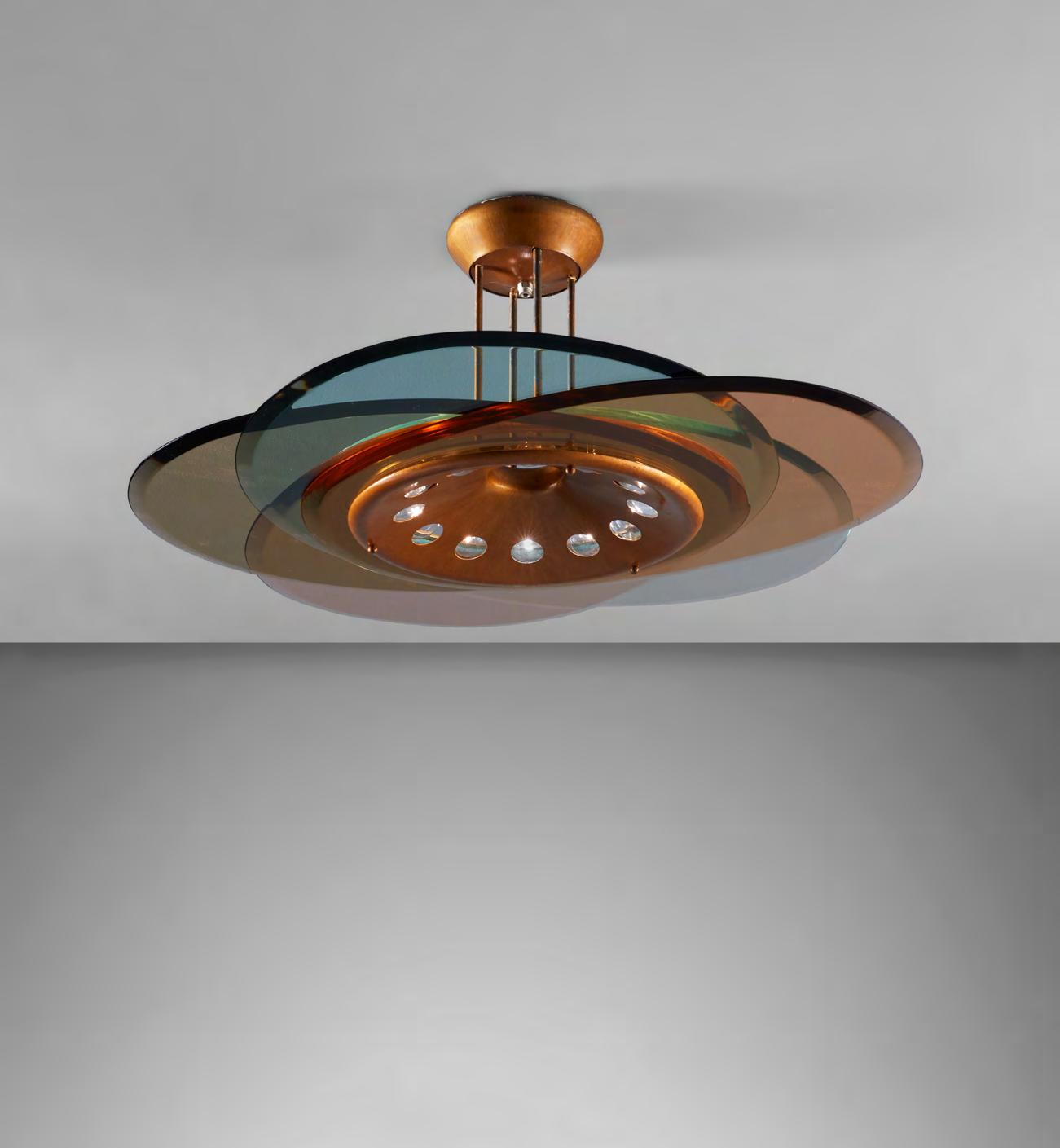
Estimate $15,000-20,000
Private collection, Plandome, New York Acquired from the above by the present owner, 2010
Roberto Aloi, Esempi di decorazione moderna di tutto il mondo: Illuminazione d’oggi, Milan, 1956, p. 151
Laura Falconi, Fontana Arte: Una Storia Trasparente, Milan, 1998, p. 96
Franco Deboni, Fontana Arte: Gio Ponti, Pietro Chiesa, Max Ingrand, Turin, 2012, fig. 328
Floor lamp, model no. 1034
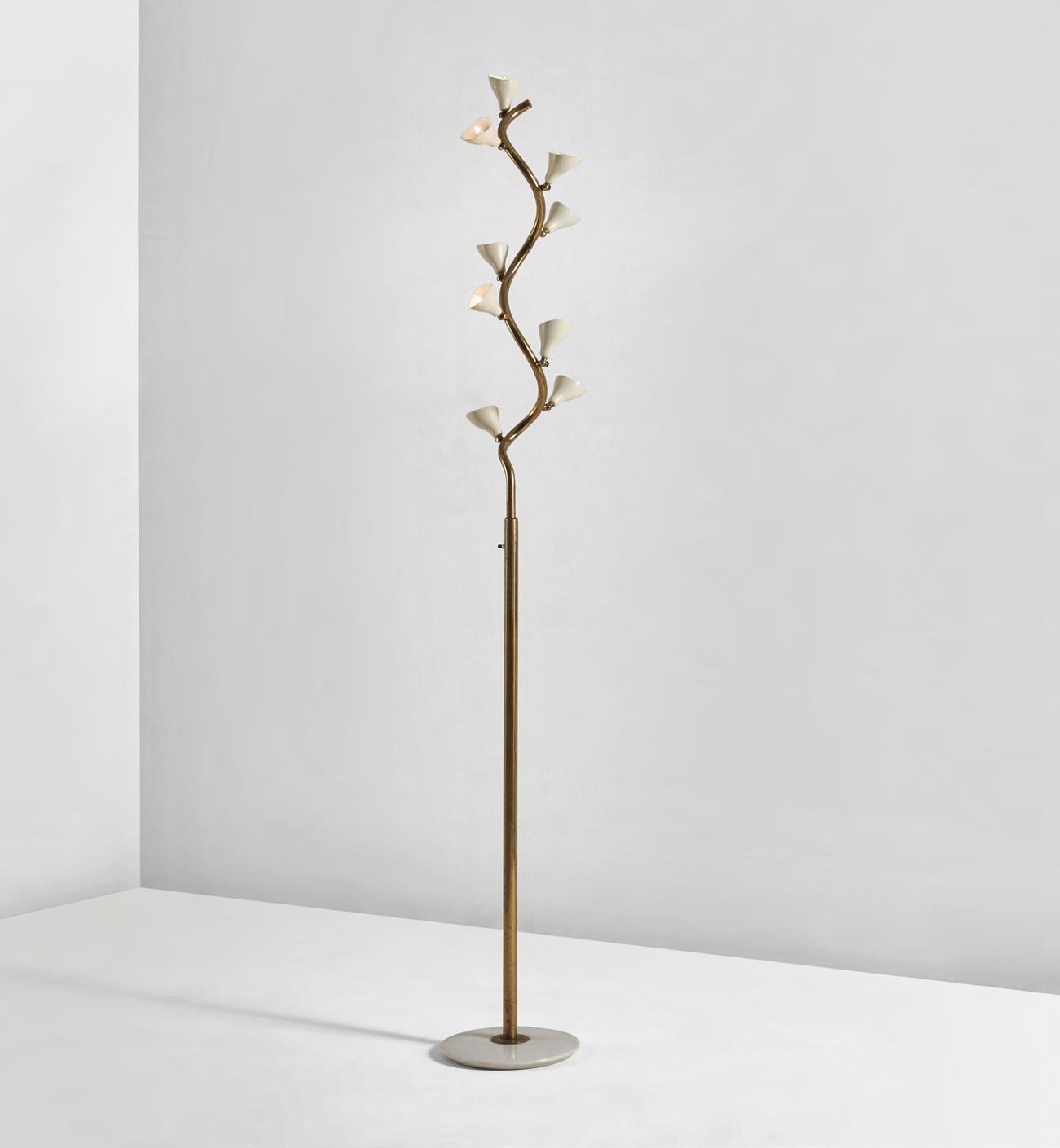
circa 1946
Brass, painted aluminum, marble. 81 3/4 in. (207.6 cm) high
Manufactured by Arteluce, Milan, Italy. Interior of one shade with manufacturer’s paper label printed AL/MILANO/ ARTELUCE
Estimate
$15,000-20,000
Private collection, Indianapolis Thence by descent
Acquired from the above by the present owner
Roberto Aloi, L’Arredamento moderno, quarta serie, Milan, 1949, fig. 200
Marco Romanelli and Sandra Severi, Gino Sarfatti: Selected Works 1938-1973, Milan, 2012, pp. 18, 446
“Boomerang” desk, designed for the Villa Bellevue, Meudon, France
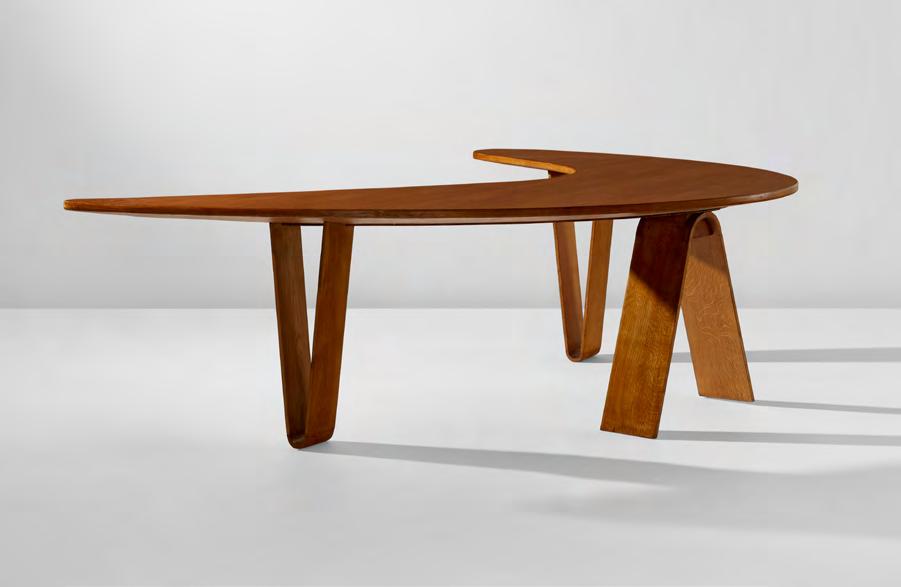
circa 1951
Oak, oak-veneered wood. 27 3/4 x 87 1/8 x 61 in. (70.5 x 221.3 x 154.9 cm)
Estimate $30,000-50,000
Private collection, France
Acquired from the above Phillips, London, “Design,” November 9, 2021, lot 202
Acquired from the above by the present owner
Gilles Quéant, “Tradition et Rupture,” Plaisir de France, June 1953, pp. 26-29 “Programmes Particuliers,” L’Architecture d’Aujourd’hui, October 1953, pp. 33, 36
Property from a Private Collection, New York City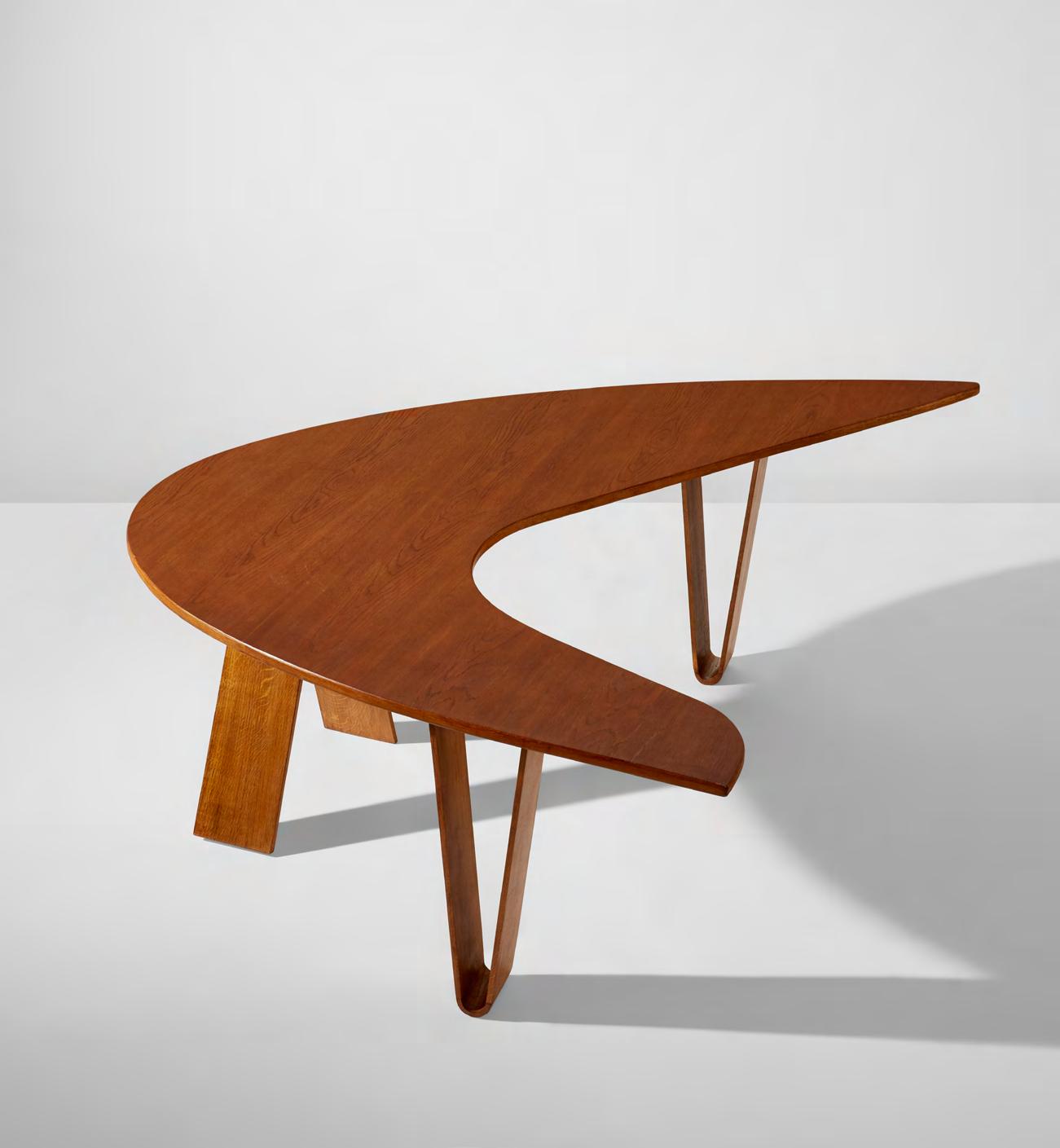
Pair of armchairs, model no. 1669

1940s
Birch, wool upholstery. Each: 30 x 31 3/4 x 31 3/4 in. (76.2 x 80.6 x 80.6 cm)
Estimate $10,000-15,000
Private collection, Copenhagen Acquired from the above by the present owner
Fritz Hansen, sales catalogue, Copenhagen, 1942, pp. 17, 19
Table

circa 1950 Marble, cherry, brass. 29 in. (73.7 cm) high, 46 1/4 in. (117.5 cm) diameter
Manufactured by Fratelli Rizzi, Capiago Intimiano, Italy.
Estimate $12,000-18,000
Provenance Private collection, Milan
Roberta Lietti, Ico Parisi Catalogue Raisonné, 1936-1960, Milan, 2017, p. 280
Phillips would like to thank Roberta Lietti of the Archivio del Design di Ico Parisi for her assistance cataloguing the present lot.
Mirror, model no. 74

circa 1939
Sommerso glass with gold leaf inclusions, mirrored glass, brass.
21 3/4 x 20 x 1 1/2 in. (55.2 x 50.8 x 3.8 cm)
Produced by Venini & C., Murano, Italy. Bracket on reverse impressed VENINI/ MURANO
Estimate $5,000-7,000
Private collection, Milan
Anna Venini Diaz de Santillana, Venini Catalogue Raisonné 1921-1986, Milan, 2000, p. 242
Franco Deboni, Venini Glass: Its history, artists and techniques, Volume 1, Turin, 2007, pl. 44D
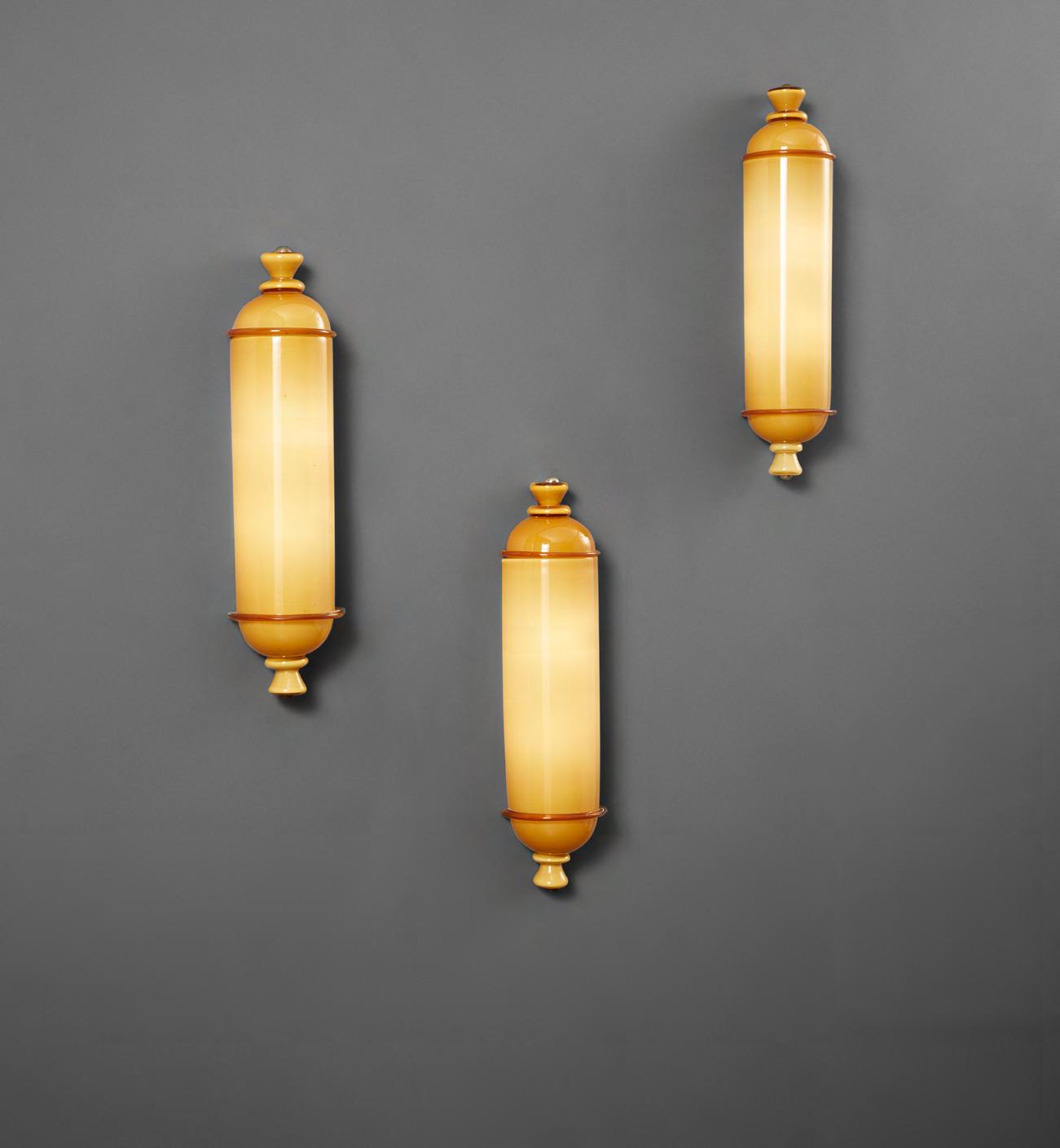
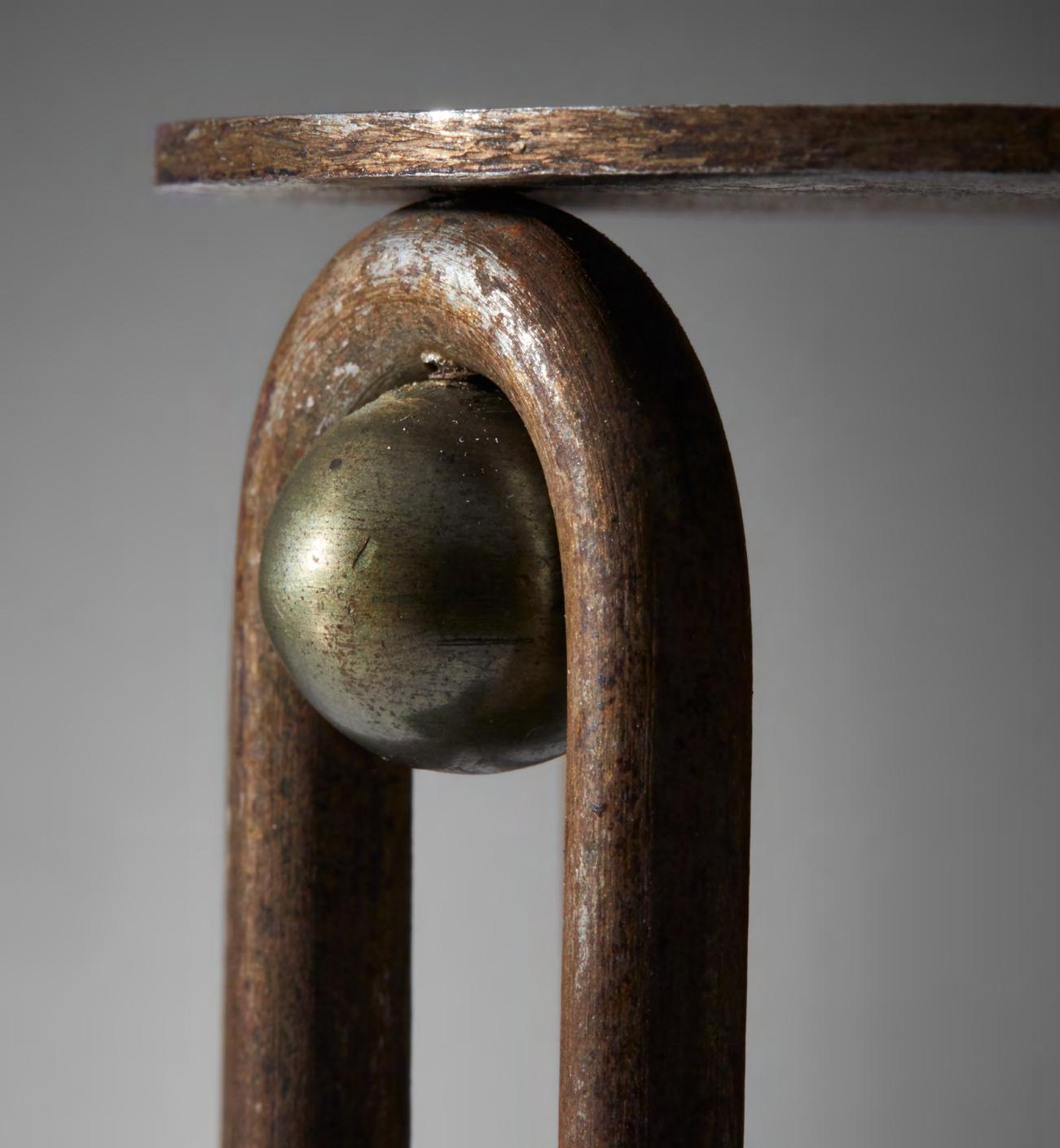
Property from a Notable New York Collection
“Ondulation” table lamp circa 1942

Patinated iron, Belgian black stone, paper shade. 16 1/4 in. (41.3 cm) high Estimate $30,000-50,000
Provenance
DeLorenzo 1950, New York Acquired from the above by the present owner, 1989
Literature
Gaston Poulain, “Le Salon d’Automne,” Mobilier et Décoration, October 1946, p. 31
Jean Royère, décorateur à Paris, exh. cat., Musée des Arts Décoratifs, Paris, 1999, p. 25
Galerie Jacques Lacoste and Galerie Patrick Seguin, Jean Royère, Volume 1, Paris, 2012, pp. 37, 142, 169, 241
Galerie Jacques Lacoste and Galerie Patrick Seguin, Jean Royère, Volume 2, Paris, 2012, pp. 39, 151
Pierre-Emmanuel Martin-Vivier, Jean Royère, Paris, 2017, pp. 110, 167
“Flaque” coffee table
circa 1948
Patinated steel, mirrored glass. 11 1/4 x 49 3/4 x 26 3/4 in. (28.6 x 126.4 x 67.9 cm)
Estimate
$200,000-300,000
Provenance
DeLorenzo 1950, New York Acquired from the above by the present owner, 1990
“Sous les tropiques,” Le Décor d’Aujourd’hui, October 1953, p. 124
Galerie Jacques Lacoste and Galerie Patrick Seguin, Jean Royère, Volume 1, Paris, 2012, pp. 240, 282, 299
Galerie Jacques Lacoste and Galerie Patrick Seguin, Jean Royère, Volume 2, Paris, 2012, pp. 6, 58
Pierre-Emmanuel Martin-Vivier, Jean Royère, Paris, 2017, p. 13
Property from a Notable New York Collection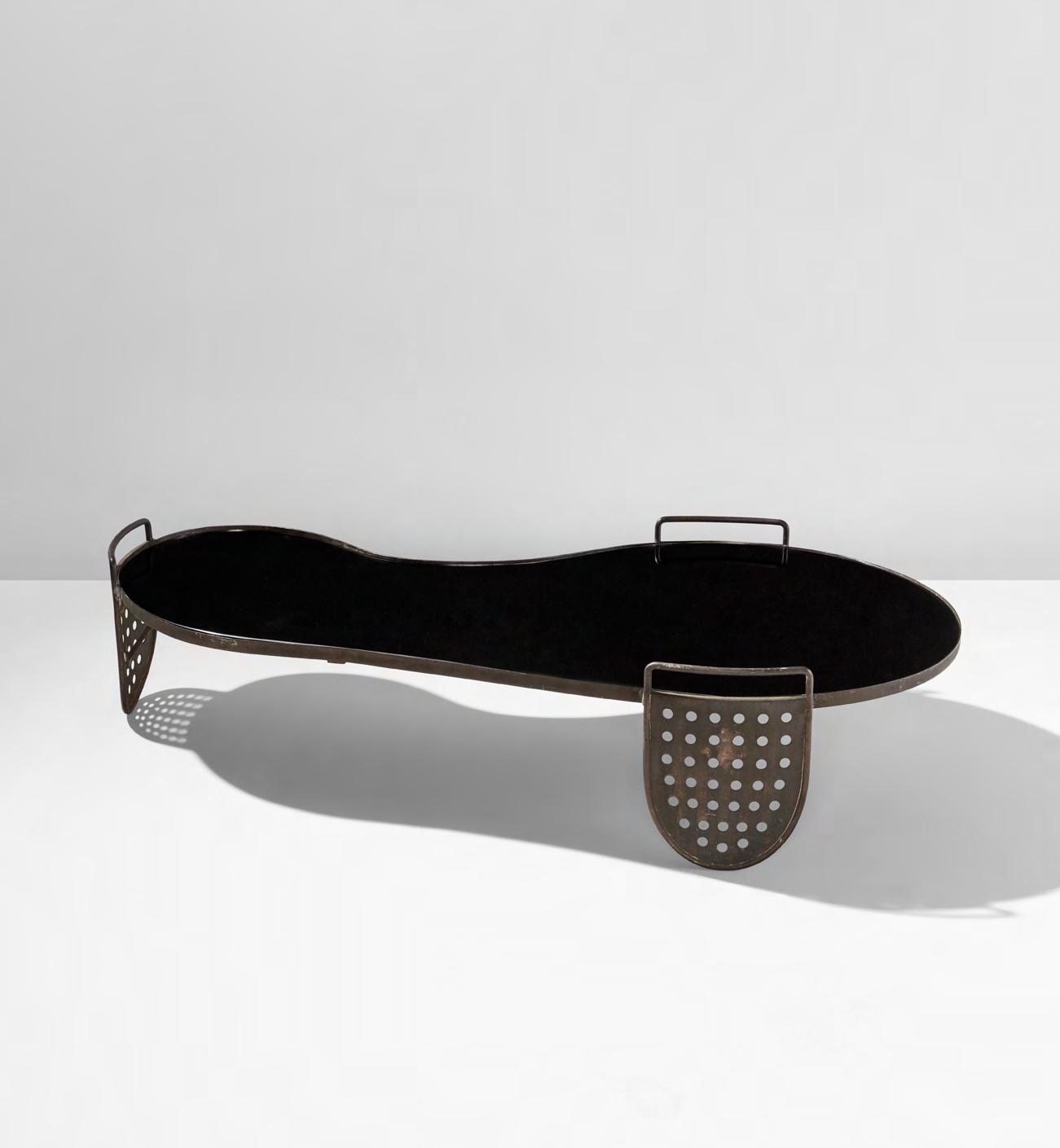
The freeform shape of the Flaque table—French for puddle— illustrates the influence of biomorphism introduced by artists such as Hans Arp and Alexander Calder and situates Jean Royère’s design within a larger international discourse. From the 1930s, designers including Frederick Kiesler, Eileen Gray, Charlotte Perriand, and Isamu Noguchi began exploring biomorphism in their work, departing from more traditional furniture forms. In the 1940s and 1950s, Royère would create several variations of the Flaque table, incorporating different materials and varied colors and ornamentation.
In 1947, for his own residence on the rue du Faubourg-Saint-Honoré in Paris, Royère designed his first pieces of biomorphic furniture, an Ours Polaire sofa and a Flaque low table similar to the present example. The latter featured an opaline glass top decorated with red stars and supported by three perforated sheet metal legs, positioned in the designer’s living room alongside a carpet whose fluid form echoed that of the low table. He even included the same model Ondulation

table lamp as offered in this sale (lot 8 in the present sale). A few years later, Royère presented a version of the table with a blue opaline glass top as part of his design for an office lounge at the 1949 Salon des artistes décorateurs. These versions of Royère’s Flaque table from the 1940s illustrate the connection to the biomorphic forms developed by designers during the 1930s, such as the series of coffee tables designed by Gray with irregularly shaped wooden or metal tops on tubular steel frames. During the 1950s Royère developed his repertoire of freeform designs, substituting the use of metal with straw marquetry, thus enabling him to introduce new ornamentation into these works, characterized by supple lines and delicate star motifs.
Such works, as demonstrated by the present lot, feature pareddown forms given expression and defined within space through their materials, reflecting Royère’s captivation with fluid forms and his enduring independent expression.
Jean Royère’s living room on the rue du Faubourg-Saint-Honoré in Paris, 1947. Artwork © 2022 Estate of Jean Royère/Artists Rights Society (ARS), New York/ ADAGP, Paris.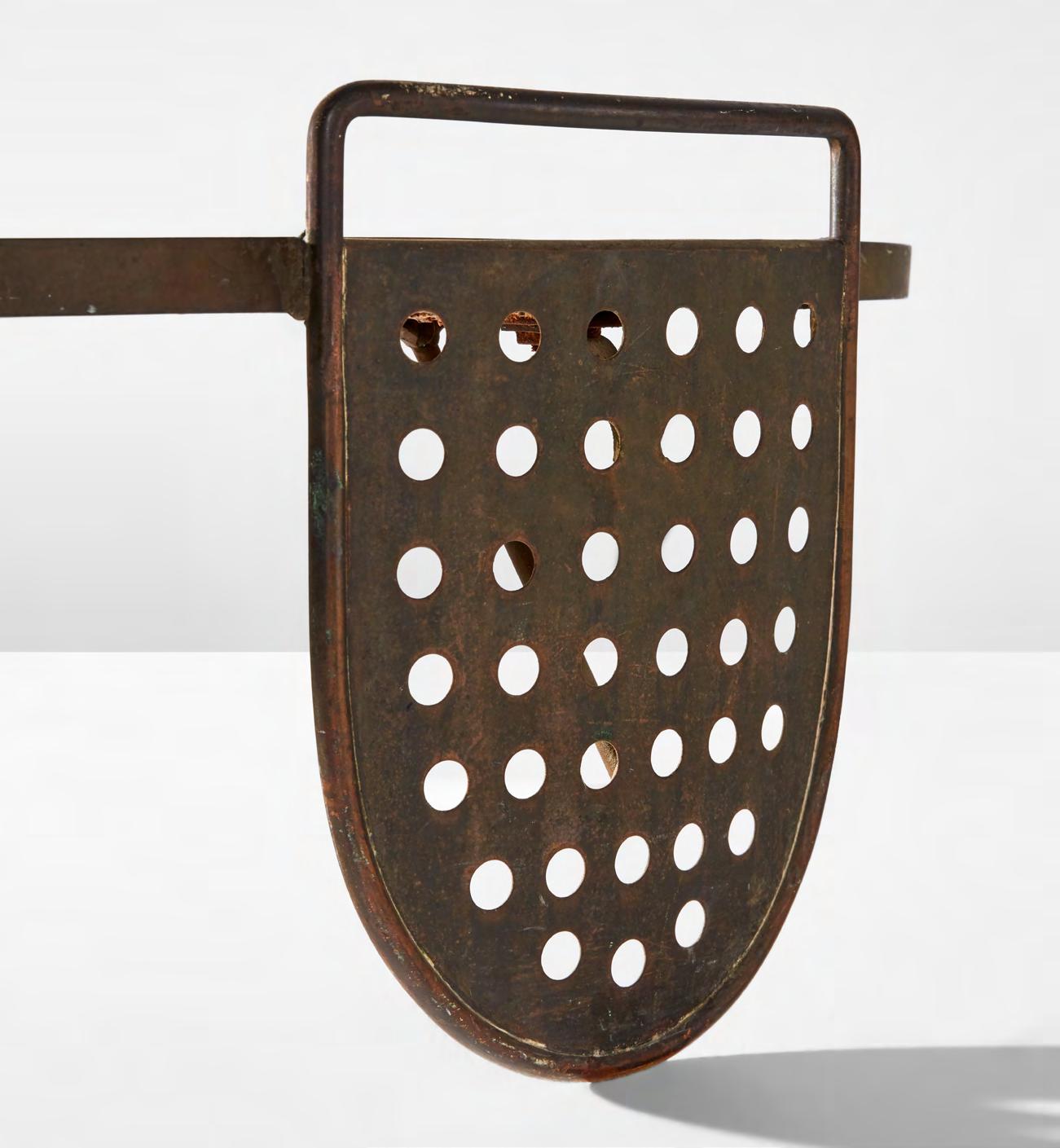
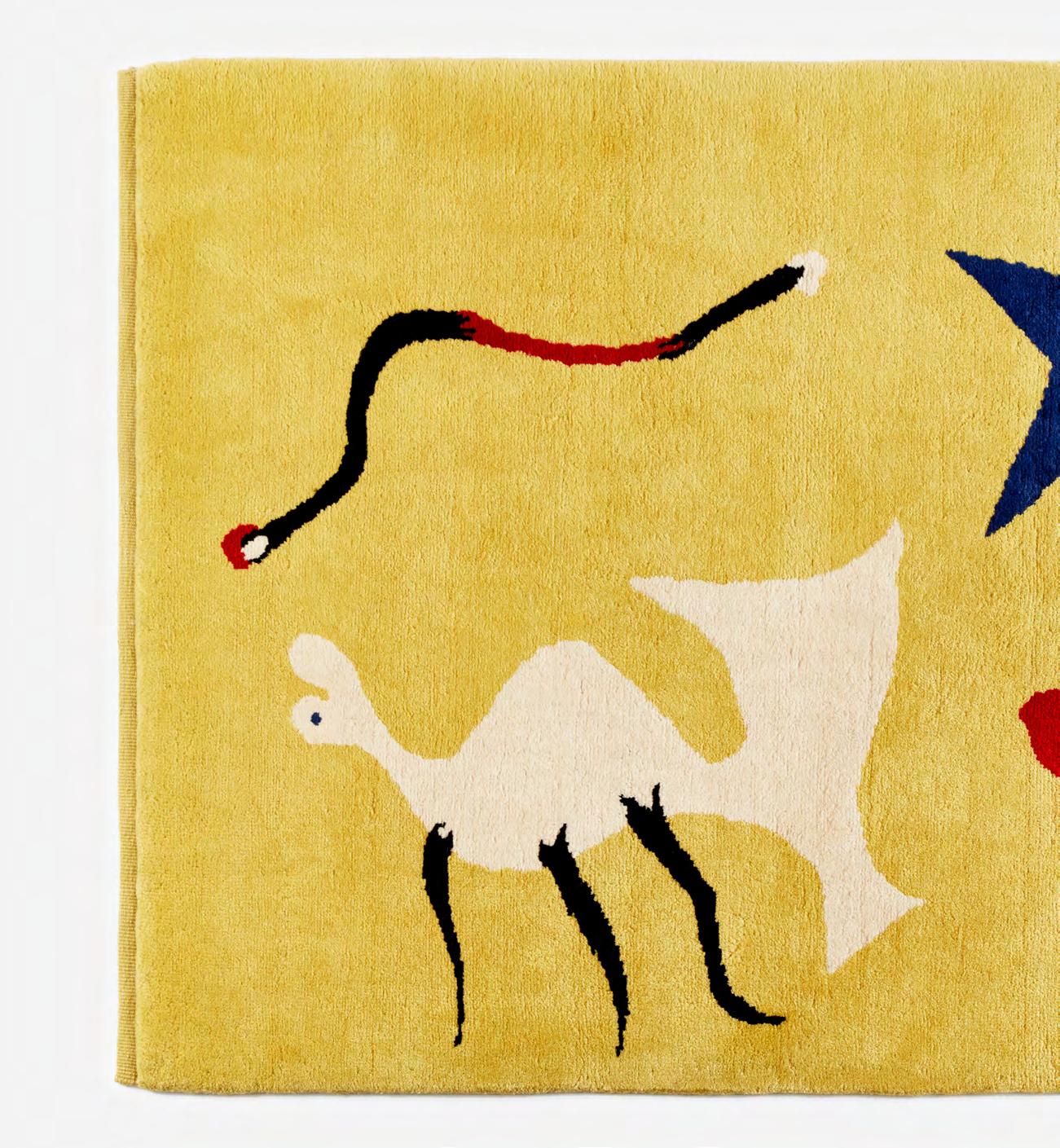
Hand-woven wool.
82 1/4 x 59 1/2 in. (208.9 x 151.1 cm) Produced by Galerie Lucie Weill & Seligmann, Paris, France. Border embroidered J. MIRO.
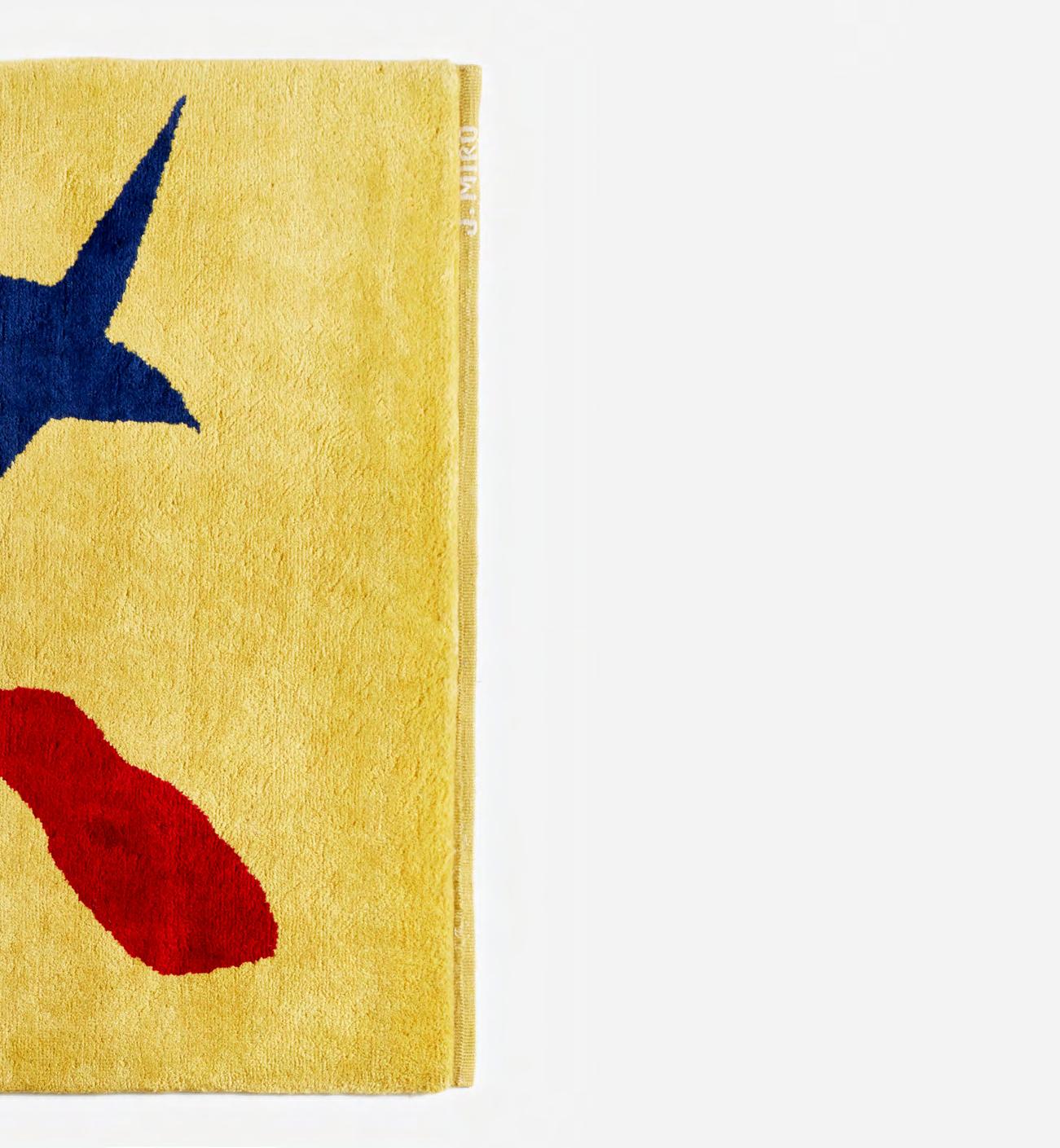
Estimate
$4,000-6,000
Mark Shilen Gallery, New York
Alberto Levi Gallery, Milan, acquired from the above
Acquired from the above by the present owner, 2020
teppiche: Arp, Klee, Laurens, Leger, Miró, Picasso, Basel, 1961, p. 5
Mildred Constantine, an exhibition of contemporary french tapestries, New York, 1965, p. 14
Jacques Dupin and Ariane LelongMainaud, Joan Miró, Catalogue Raisonné. Paintings, Volume I: 1908-1930, Paris, 1999, p. 232 for the oil on canvas
Property from the Collection of David Netto“Ondulation” ceiling light circa 1939
Painted metal, paper shades. 23 1/2 in. (59.7 cm) drop, 53 in. (134.6 cm) diameter Estimate $100,000-150,000
DeLorenzo 1950, New York Acquired from the above by the present owner, 2000
“Jean Royère ou bon sens et fantaisie,” Mobilier et Décoration, June 1949, p. 6 Galerie Jacques Lacoste and Galerie Patrick Seguin, Jean Royère, Volume 2, Paris, 2012, p. 38
 Property from a Notable New York Collection
The present model ceiling light in an interior designed by Jean Royère in Lebanon, circa 1949. Artwork © 2022 Estate of Jean Royère/Artists Rights Society (ARS), New York/ADAGP, Paris.
Property from a Notable New York Collection
The present model ceiling light in an interior designed by Jean Royère in Lebanon, circa 1949. Artwork © 2022 Estate of Jean Royère/Artists Rights Society (ARS), New York/ADAGP, Paris.

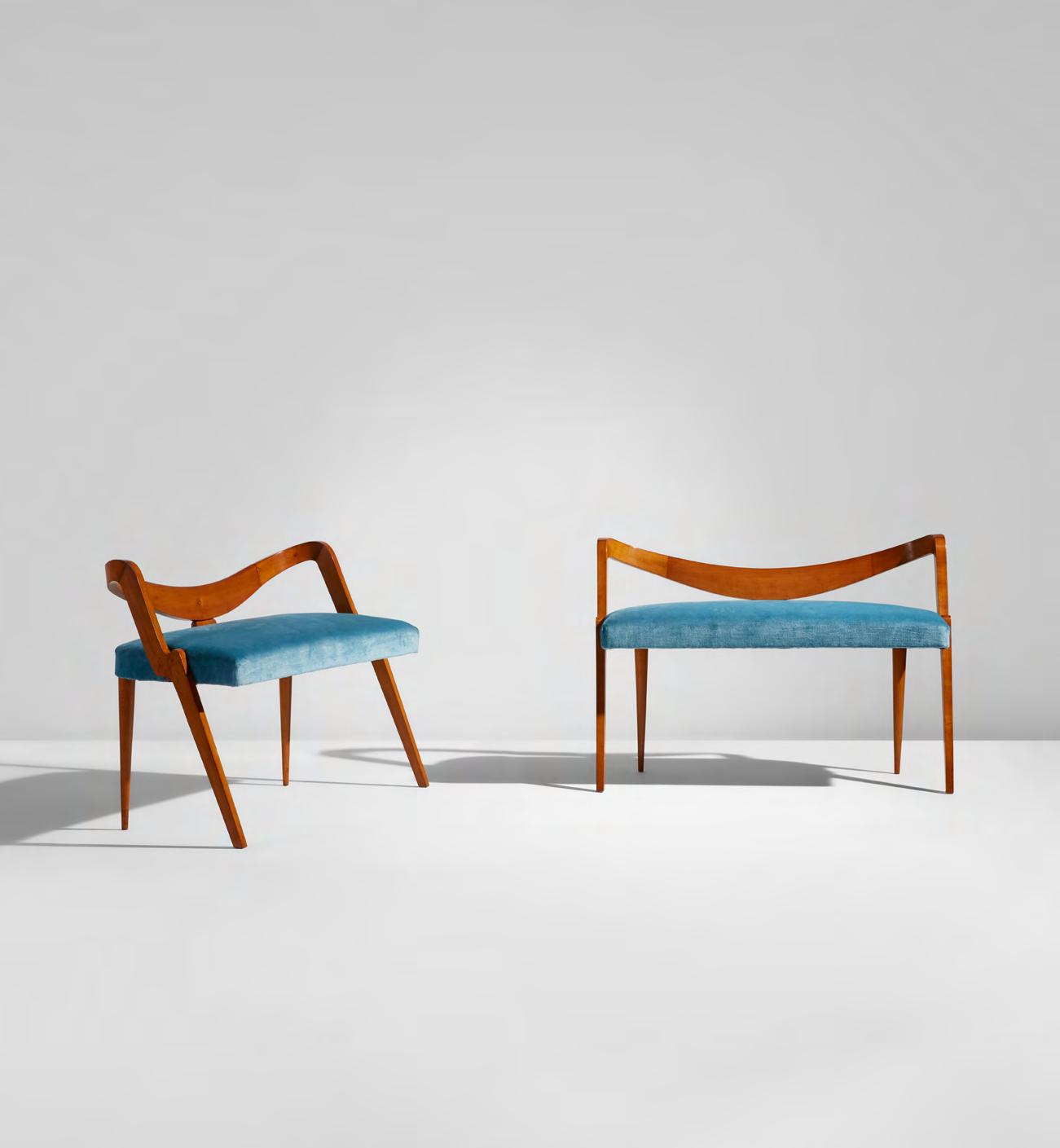
Rava 1903-1986
1950s
Maple, fabric upholstery. Each: 26 1/2 x 37 1/4 x 16 in. (67.3 x 94.6 x 40.6 cm)
Estimate $4,000-6,000
Private collection, Bellagio
Roberto Aloi, Esempi di Arredamento Moderno di Tutto il Mondo: Sedie, Poltrone, Divani, Milan, 1950, fig. 217 for a similar example
Pair of “Crococurules”
designed 1992, produced 2009 and 2012 Aluminum.
Each: 21 1/2 x 28 1/4 x 16 1/4 in. (54.6 x 71.8 x 41.3 cm)
Numbers 2A and 8B from the respective editions of 8 plus 4 artist’s proofs.
Edge of one seat impressed A/2 / 8/ CL LALANNE/2009 and edge of other seat impressed B/8 / 8/CL/CLAUDE LALANNE/2012
Estimate
$400,000-600,000
Ben Brown Fine Arts, London Acquired from the above by the present owner, 2018
Dung Ngo, ed., Claude & François-Xavier Lalanne, Art, Work, Life, New York, 2012, n.p.
Property of an International Collector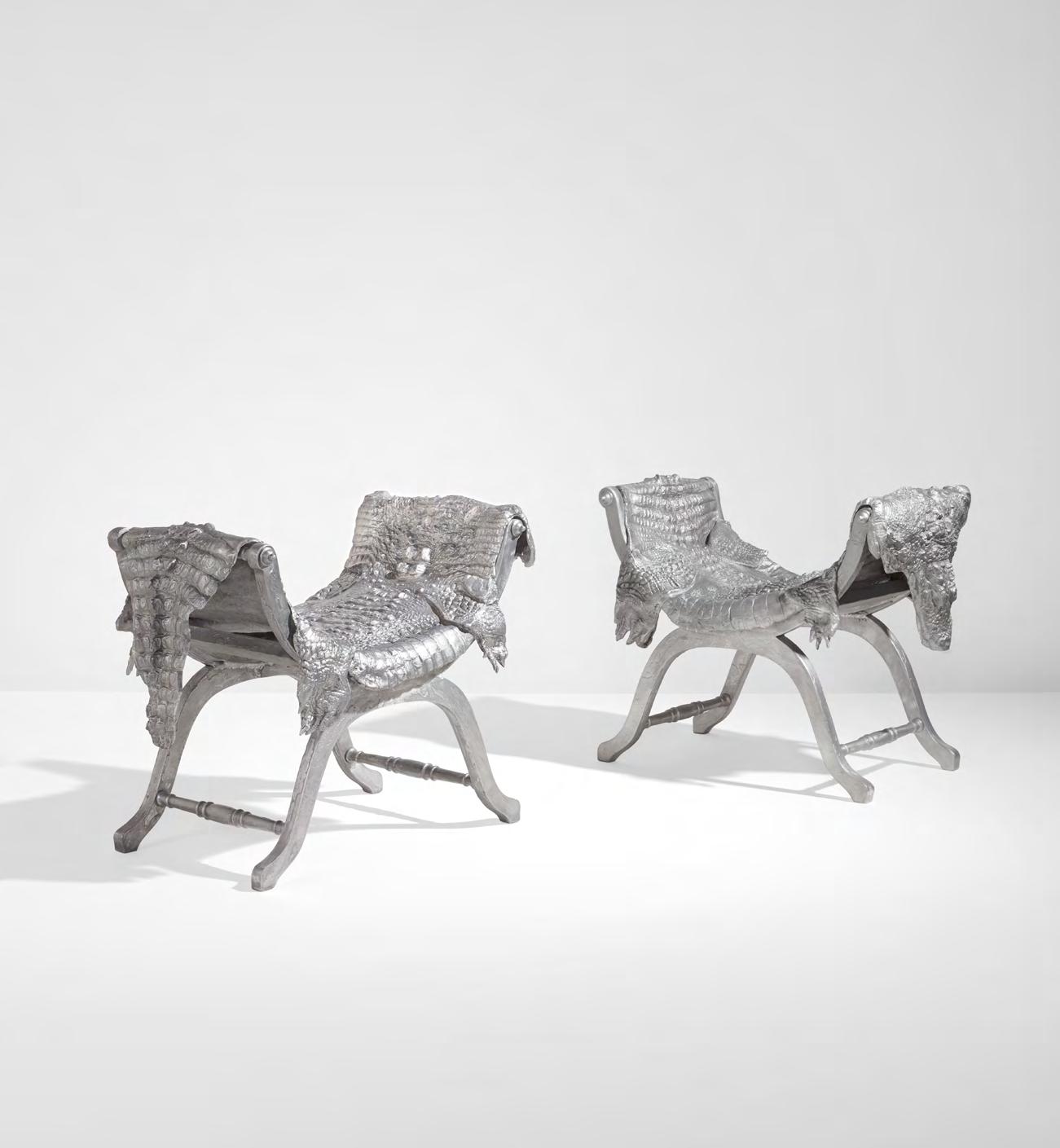
In the past fifteen years the work of Francois-Xavier and Claude Lalanne has gone from the private, cult domains of Yves Saint Laurent and the Agnellis to something akin to maximum exposure, showing up in Marc Jacobs’ apartment in the pages of Architectural Digest to Tom Ford’s boutiques. From major museum retrospectives to full-scale monographs, Les Lalanne are being introduced to a new and young audience, eager to absorb their idiosyncratic visual language. We are having, as they say, a peak Lalanne moment.
Yet, encounters with each Lalanne sculpture—whether it’s one of Francois-Xavier’s rhinoceros desks or Claude’s apples—cannot but bring a smile to one’s face. Their whimsical, surrealist tinged sculptures have both universal appeal and conceptual rigor. Despite the fame relatively late in their lives, the Lalannes continued to live modestly and worked continuously until their passing at their workshop/home/garden in Ury, a little more than an hour south of Paris. The few times I met Claude while working on their monograph, Francois-Xavier & Claude Lalanne: In the Domain of Dreams, she wore the traditional bleu de traivail jacket, even to her own openings.
Devoted followers of the Lalannes know that Francois-Xavier (1927–2008) worked exclusive with animal forms, while Claude (1925–2019) dealt with the flora world. This is mostly, but not entirely, true. Some of Claude’s most iconic works incorporated animal parts; her famous choupatte series, a cabbage that was originally cast from her own garden, sports a pair of chicken legs, while the aforementioned apple has a pair of human lips. Claude’s crocodile series is another body of work where she ventured into the animal kingdom.
Claude’s work are more realistic in appearance than FrancoisXavier’s, partly because many of her pieces are original cast from live specimens. Claude’s first crocodile sculpture was purportedly cast from a small crocodile from the Paris zoo, which was given to her by the zoo keeper after it died of natural causes. This pair of Crococurules by Claude is especially unusual in her oeuvre in that they incorporate a classical chair form, rather than imitation of branches or vines, as in her other furniture pieces. Roman in origin, the curule was a seat of honor reserved for magistrates and emperors. By replacing the typical fur with a cast of a crocodile skin, Claude rendered an honorific chair into pure sculpture, in the grandest Surrealist tradition.
“For us classification is of absolutely no interest but if forced to, we would say that, yes, we make sculpture.”
Claude Lalanne
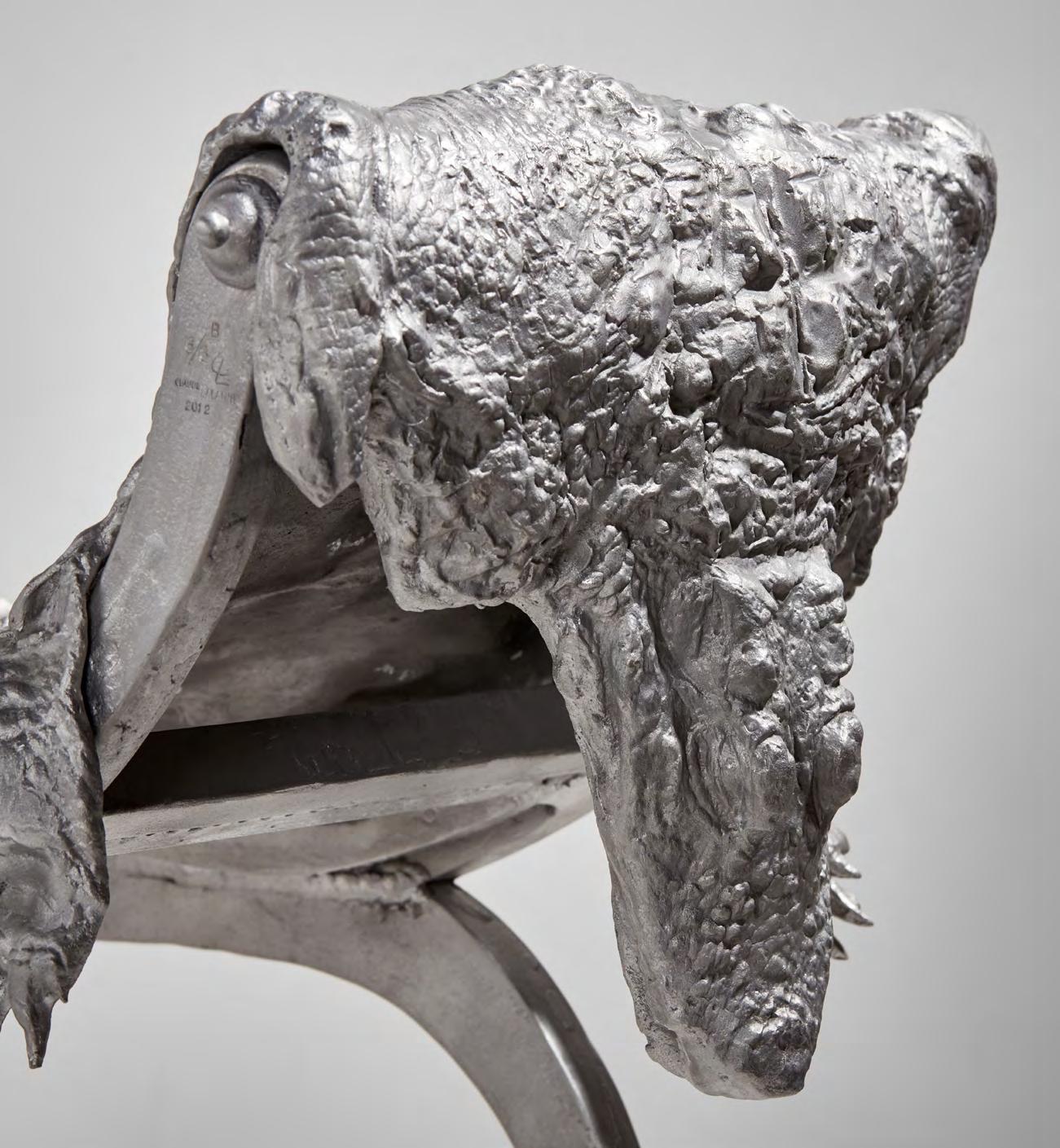
1927-2008 and 1930-2010
“Rhinoceros” five-panelled screen, from the “Ultramobile” series
circa 1976
Lacquered and serigraph-printed plywood, rubber.
Each panel: 86 1/2 x 17 3/4 x 3/4 in. (219.7 x 45.1 x 1.9 cm)
Produced by Gavina for Studio Simon, Bologna, Italy.
Estimate $30,000-40,000
Acquired in Milan circa 1982
Simon International, Ultramobile, sales catalogue, Italy, 1970s, p. 21
Fondazione Scientifica Querini Stampalia, ed., Dino Gavina: Collezioni Emblematiche del Moderno dal 1952 al 1992, Milan, 1992, p. 94
Property from a Private Southampton Collection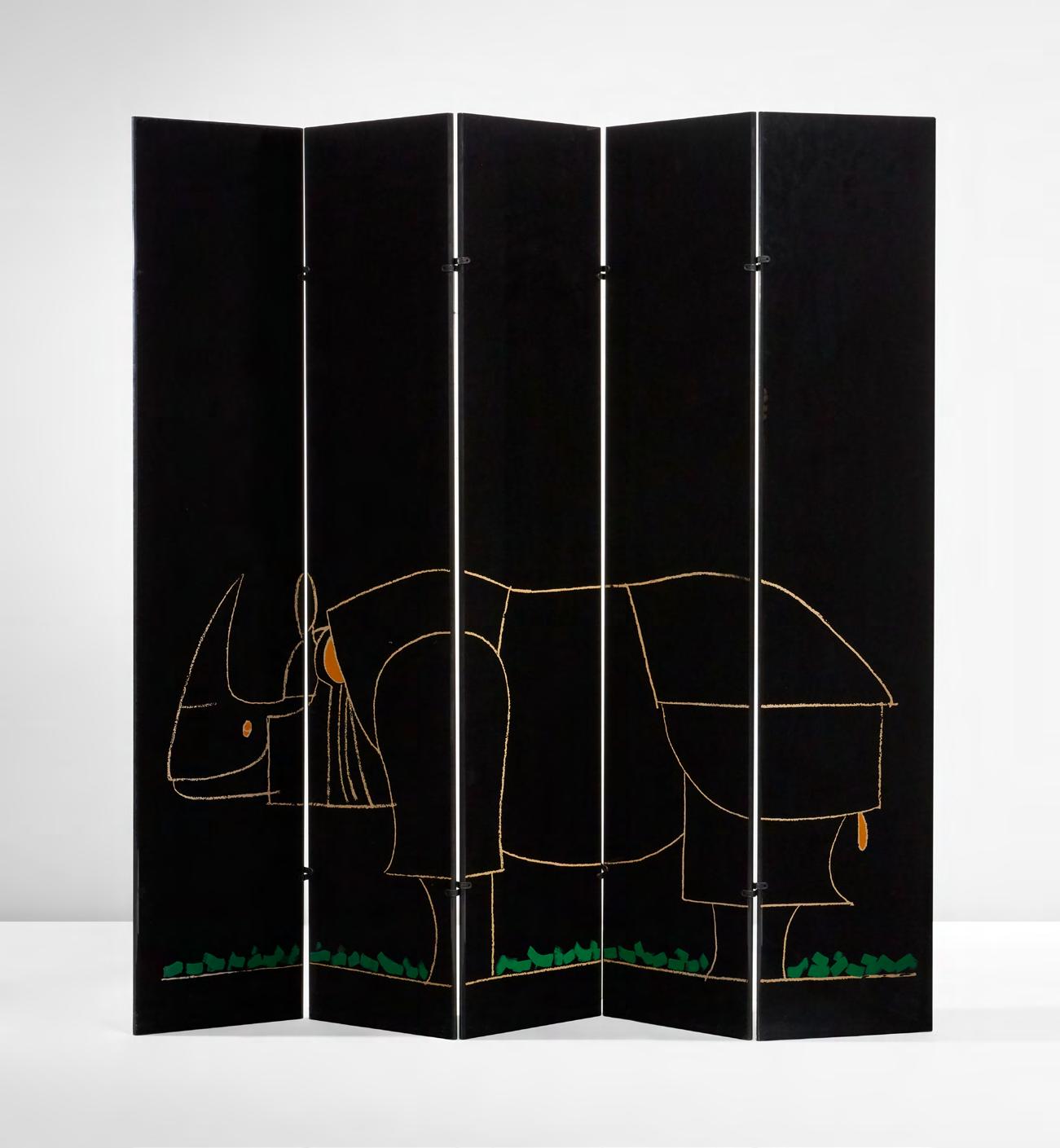
“Cactus” table
designed 1951, produced circa 1984 Crystal, glass, chromium-plated steel. 27 7/8 in. (70.8 cm) high, 59 3/4 in. (151.8 cm) diameter
Two glass elements incised Lalique France ®.
Estimate $20,000-30,000
Provenance Lalique, Paris
Acquired from the above by the present owners, circa 1984
Nicholas M. Dawes, Lalique Glass, New York, 1986, p. 131
Marie-Claude Lalique, Lalique, Geneva, 1988, pp. 182-83
Lalique: A Century of Glass for a Modern World, exh. cat., The Fashion Institute of Technology, New York, 1989, p. 75
Property from a Private New York Collection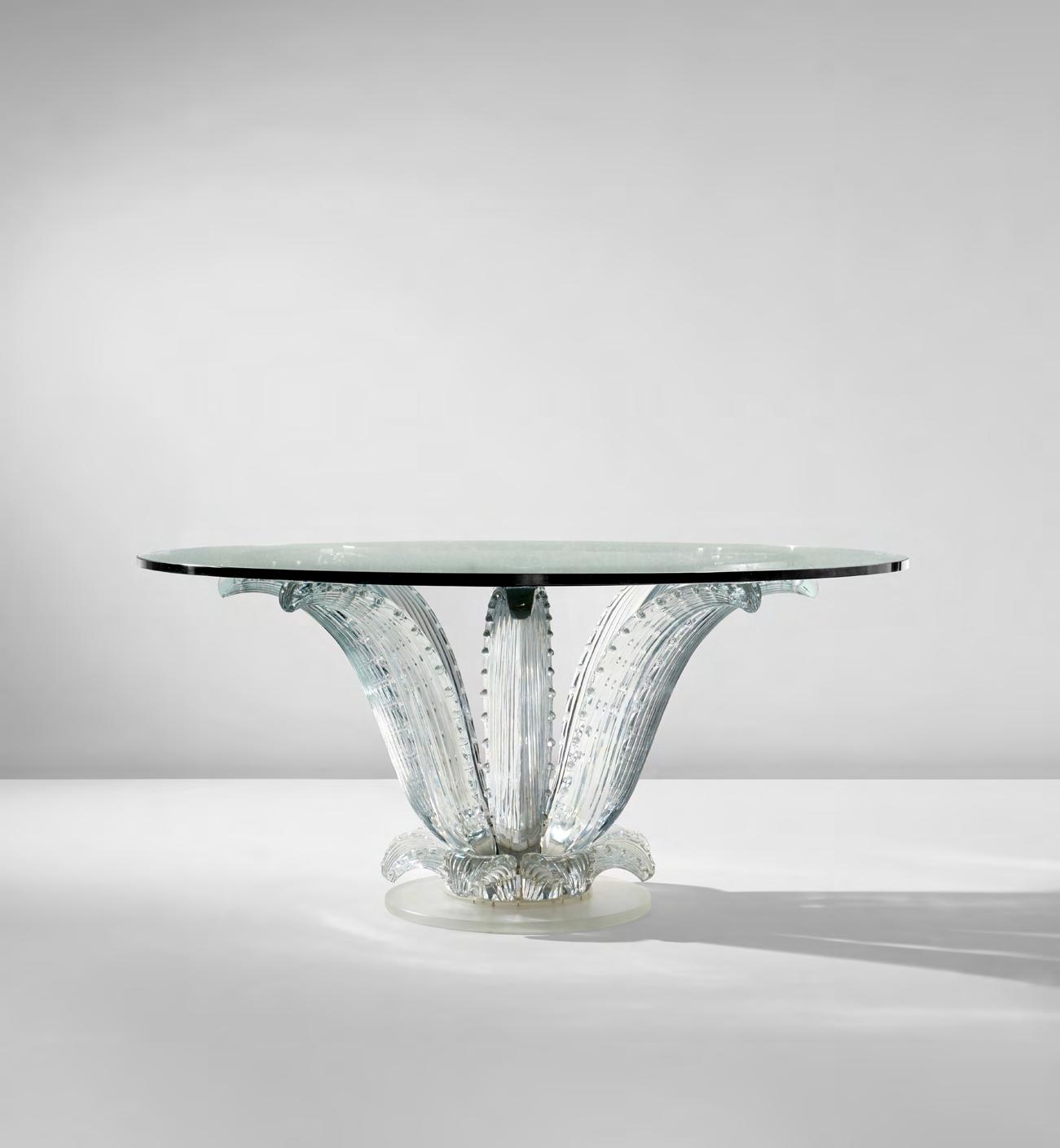
Flower-form vase
circa 1902
Favrile glass. 15 in. (38.1 cm) high Underside engraved L.C.T. and T5472
Estimate $40,000-60,000
Private collection, Tokyo Yaezaki Gallery, Tokyo Acquired from the above by the present owner, 2010
Robert Koch, Louis C. Tiffany: The Collected Works of Robert Koch, Atglen, 2001, pp. 172, 211 for a similar example on display at the Tiffany Furnaces in Corona, New York
Martin Eidelberg and Nancy A. McClelland, Behind the Scenes of Tiffany Glassmaking: The Nash Notebooks, New York, 2001, p. 82 for a similar example on display at the Tiffany Furnaces in Corona, New York
Property from a Private International Collection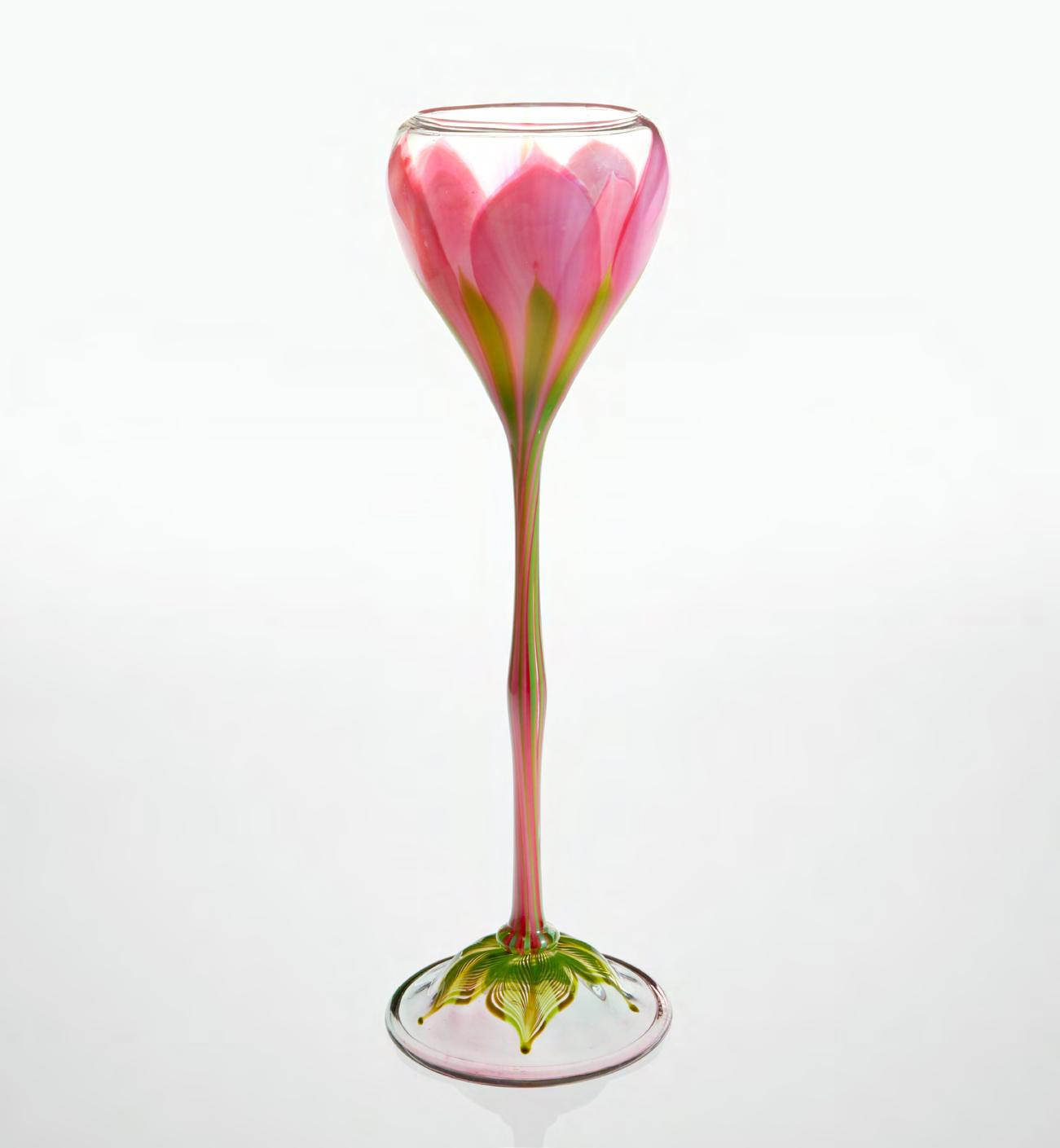
similar example Flower-form vase on display at the Tiffany Furnaces in Corona, New York.
Louis Comfort Tiffany excelled at everything he turned his hand to, whether windows, glass, metalwares, enamels, ceramics or jewelry. While his firm’s blown glass has long been overshadowed by its more renowned leaded glass lamps and windows, Louis Tiffany was probably most proud of, and best loved, the blown glass vases his glasshouse first produced in late 1893. When museums around the world wanted to acquire an example of the firm’s work made during Tiffany’s lifetime, they didn’t purchase a window or lamp, they invested in a vase. Tiffany’s authorized biography, published in 1914, does not have a single mention of leaded glass lamps. There is, however, an entire chapter devoted to his blown glass, and that chapter opens by essentially saying that Tiffany’s widest fame was achieved not through his acclaimed windows, but with his vases. Nothing remotely like Tiffany’s glass was being produced in the United States at the turn of the twentieth century. Louis was determined to explore the inherent qualities of glass, and once his firm was
making its own glass, he was free to experiment with color, form and technique. His pieces were true examples of art glass, meant to be appreciated for their profound aesthetics rather than function, and his extensive knowledge of botany inspired Tiffany to endow his firm’s works with a sense of nature’s all-encompassing beauty. Flower-form vases were amongst the earliest and most distinctive blown glass shapes produced by the house, and Louis’s passionate affinity for plant life is evident in the exquisite flower-form on offer. While flower-form vessels are all sculptural in design, they vary in shape, size, color, and decoration. The present example exhibits not only an impressive height and classic proportions, but it is further enhanced with an adventurous palette that evokes a highly painterly quality, as well as a splendidly rendered impressionistic interpretation of a lush flower with beautifully stylized overlapping petals, striated threads and radiating feathery leaves. The work marvelously reveals the supreme skill of Tiffany’s glassmakers and aptly demonstrates Tiffany’s unparalleled artistry in glass.
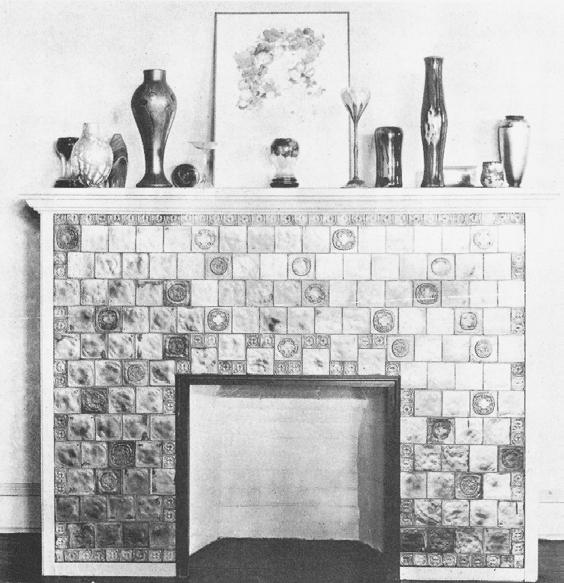 A
A
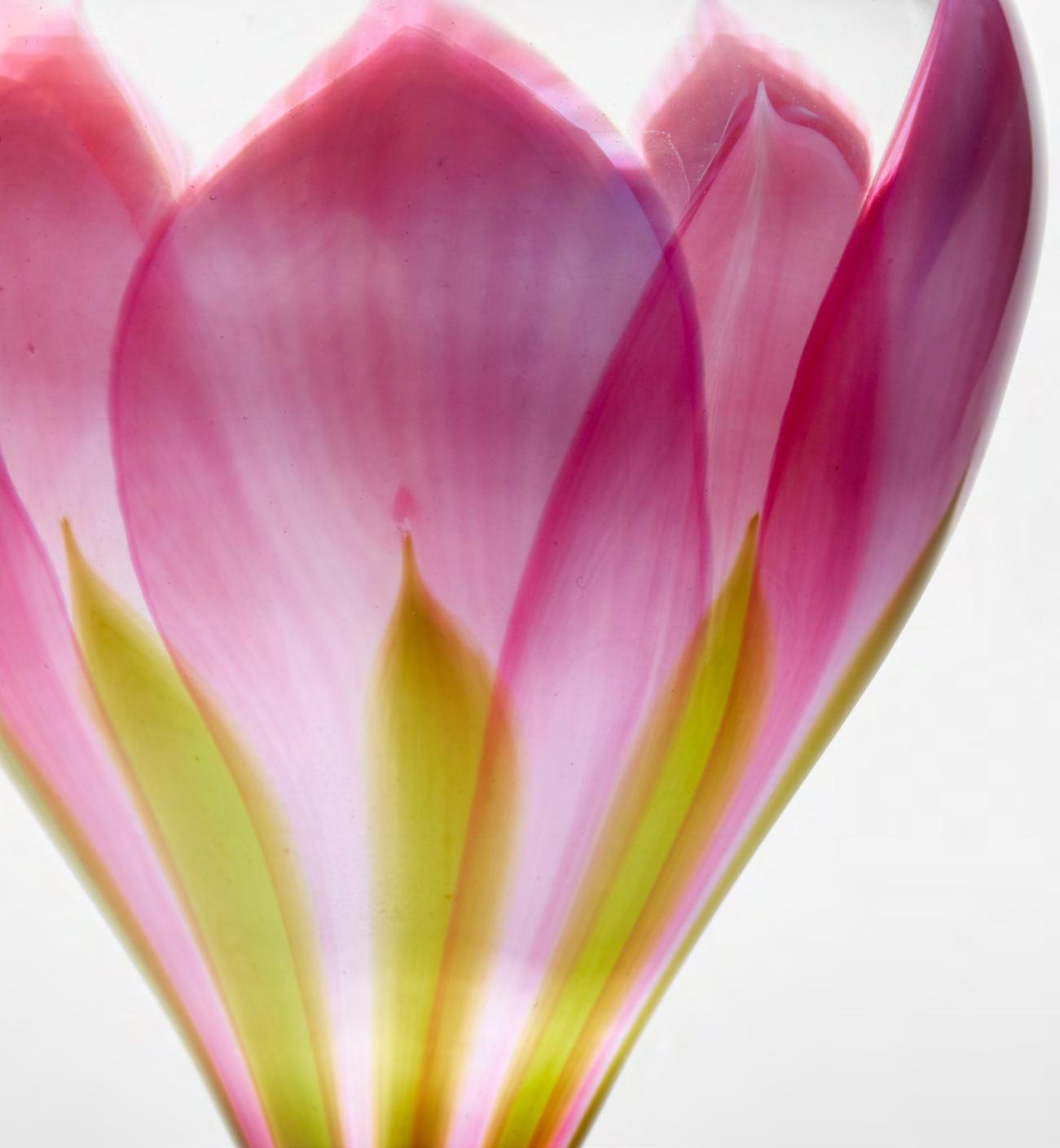
Property of a Lady
1879-1933
“Élégant” guéridon circa 1925
Macassar ebony, Macassar ebonyveneered wood.
25 1/2 in. (64.8 cm) high, 19 1/2 in. (49.5 cm) diameter

Underside branded Ruhlmann and with Atelier B medallion mark.
Estimate $20,000-30,000
Galerie Claude, Cologne
Private collection, Germany, acquired from the above, 1993 Christie’s, Paris, “Arts Décoratifs du XXe siècle et Design,” November 21, 2012, lot 10
Acquired from the above by the present owner
“Chambres à coucher et salles de bains,” Art et Industrie, November 1926, p. 43
Florence Camard, Ruhlmann, Paris, 1983, pp. 90, 253, 268
Emmanuel Bréon, Jacques-Émile Ruhlmann, Interior Design, Paris, 2004, p. 7
Florence Camard, Jacques-Émile Ruhlmann, New York, 2011, p. 115
The present model table is recorded as reference numbers AR 1015 and NR 1161 in the Ruhlmann Archives at the Musée des Années Trente, Boulogne Billancourt, Paris.
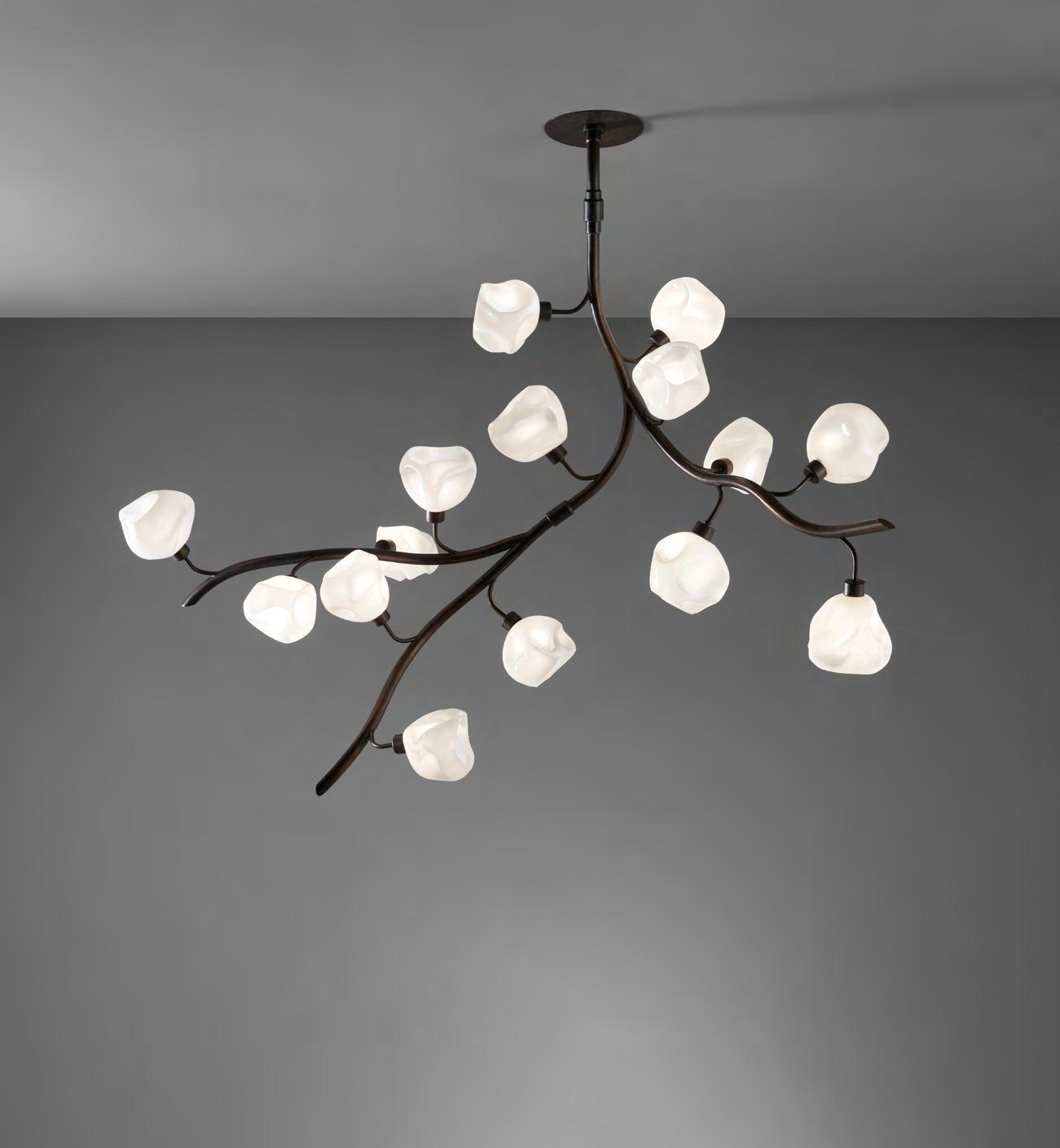
Cabinet
1940s
Oak, oak-veneered wood.
37 5/8 x 60 1/2 x 20 in. (95.6 x 153.7 x 50.8 cm)
Estimate $5,000-7,000
Maison Gerard, New York
Acquired from the above by the present owner, 2005
Louis Cheronnet, “Jacques Adnet,” Mobilier et Décoration, February 1946, p. 16 for a similar example
Louis Cheronnet, Jacques Adnet, Paris, 1948, pl. 22 for a similar example
Alain-René Hardy and Gaëlle Millet, Jacques Adnet, Paris, 2014, pp. 99, 208 for similar examples
Property from a Private South Carolina Collection

Two tall lidded jars
circa 2011
Porcelain, celadon glaze.
Taller: 18 in. (45.7 cm) high Shorter: 16 3/4 in. (42.5 cm) high Sides of each impressed with inventory mark under the glaze.
Estimate $20,000-30,000
Edmund de Waal, Edmund de Waal, London, 2014, pp. 30, 65 for similar examples
Property from a Private Collection, Brooklyn
Lidded jar

circa 2001
Porcelain, celadon glaze. 12 1/2 in. (31.8 cm) high Side impressed with inventory mark under the glaze.
Estimate $6,000-8,000
Provenance
Garth Clark Gallery, New York Acquired from the above by the present owner, 2001
Edmund de Waal, Edmund de Waal, London, 2014, pp. 30, 106 for similar examples
Property from a Private Collection, Brooklyn
Σ
Set of six “China” armchairs, model no. 4283 designed 1944, executed 1969-1970 Brazilian rosewood, vinyl upholstery. Each: 32 1/2 x 22 1/4 x 21 1/2 in. (82.6 x 56.5 x 54.6 cm) Manufactured by Fritz Hansen, Copenhagen, Denmark. Underside of each with manufacturer’s paper label printed FH/MADE IN DENMARK/BY FRITZHANSEN/FURNITUREMAKERS/DANISH/ CONTROL and with four-digit date codes.
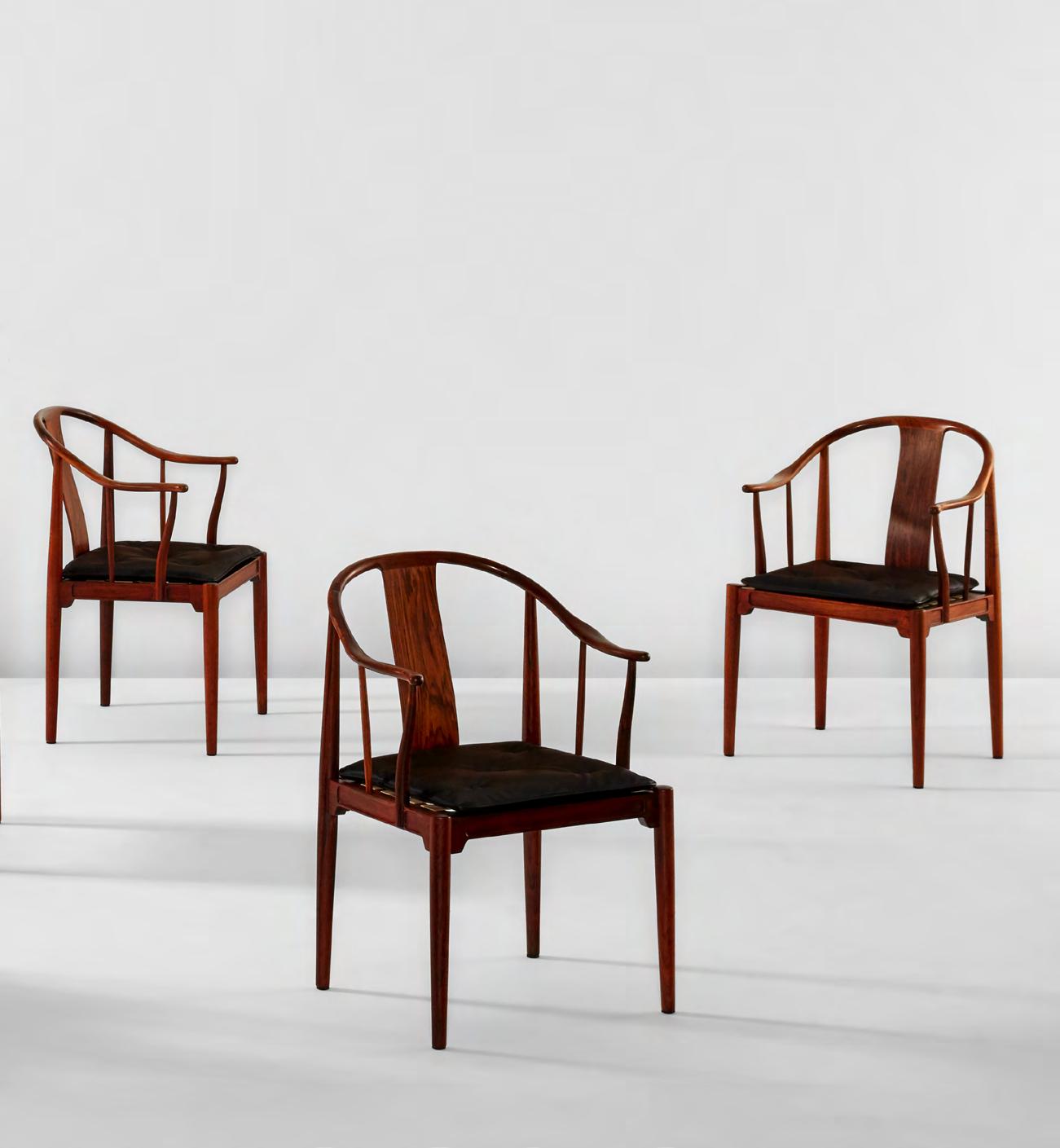
Estimate $20,000-30,000
Private collection, New York, circa 1969 Thence by descent to the present owner
Af Jørn Rubow, “Udstillingen i Kunstindustrimuseet,” Nyt Tidsskrift For Kunstindustri, no. 6, June 1944, p. 90
Ingvar Bergström, “Danskt i Röhsska Konstslöjdmuseet,” Nyt Tidsskrift For Kunstindustri, no. 10, October 1945, p. 119
Christian Holmsted Olesen, Wegner: just one good chair, exh. cat., Design Museum Denmark, Copenhagen, 2014, pp. 114, 121
circa 1936
Patinated bronze, fabric shade.
Height of cast: 57 1/4 in. (145.4 cm)
One leg incised A. Giacometti and impressed 049. Together with a certificate of authenticity from the Comité Giacometti.
Estimate $150,000-250,000
L’Arc en Seine/Rainbow Fine Art, New York
Acquired from the above by the present owner, 2006
Michel Butor, Diego Giacometti, Paris, 1985, p. 142
Françoise Francisci, Diego Giacometti: Catalogue de l’oeuvre, Vol. 1, Paris, 1986, p. 31
François Baudot, Diego Giacometti, Paris, 1998, p. 42
Christian Boutonnet and Rafael Ortiz, Diego Giacometti, Paris, 2003, p. 38
Daniel Marchesseau, Diego Giacometti: sculpteur de meubles, Paris, 2018, p. 30
The present lot is registered by the Fondation Alberto and Annette Giacometti in the online Alberto Giacometti Database (AGD) under the number AGD 4452.
Property from the Collection of David Netto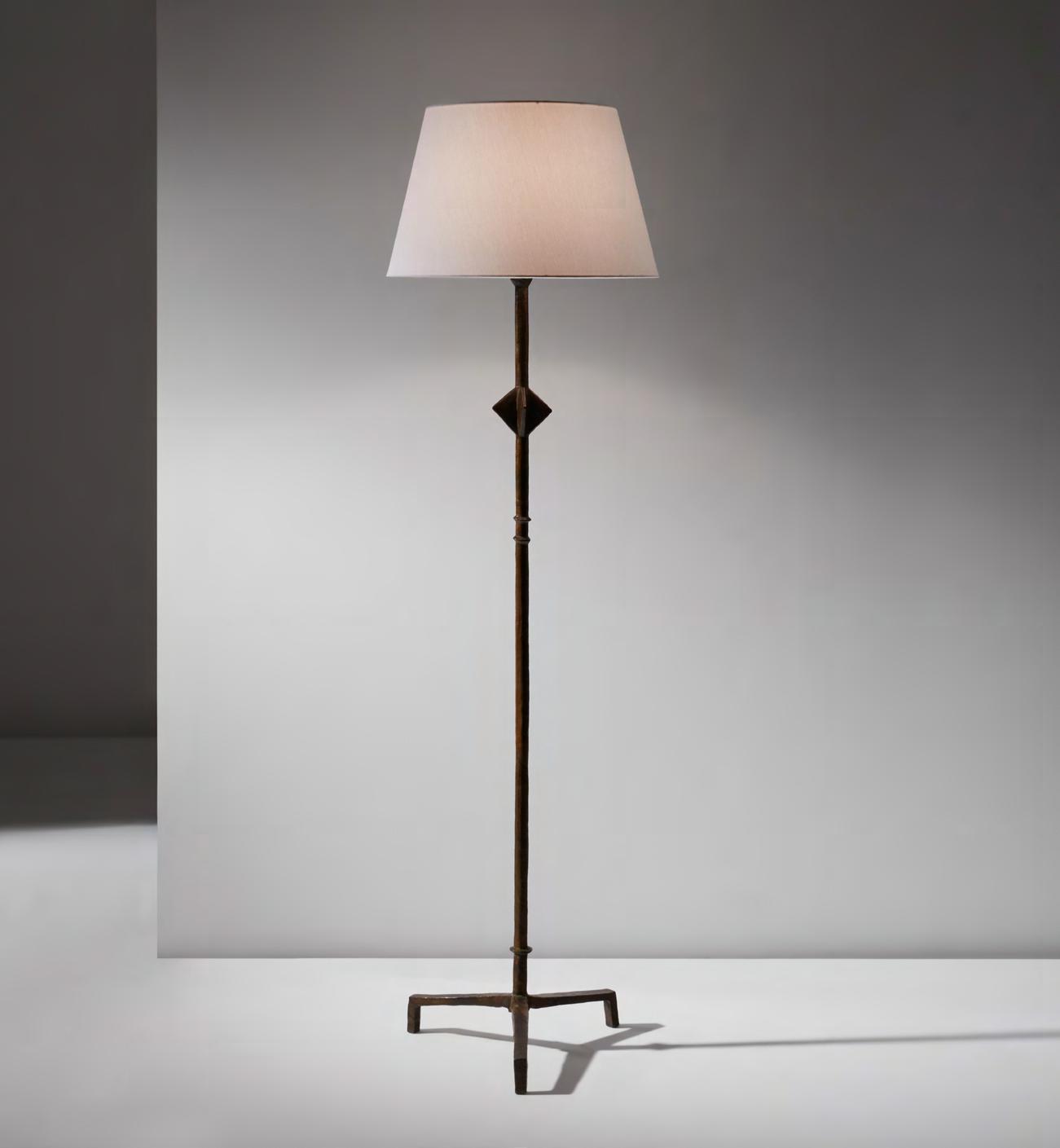
Large tray
circa 1915
Patinated nickel silver.
1 1/4 x 24 5/8 x 24 1/2 in. (3.2 x 62.5 x 62.2 cm) Underside impressed with artist’s seal.
Estimate $5,000-7,000
Literature
Félix Marcilhac, Jean Dunand: His Life and Works, New York, 1991, p. 269 for a similar example
Amélie and Félix Marcilhac, Jean Dunand, Paris, 2020, p. 323 for a similar example
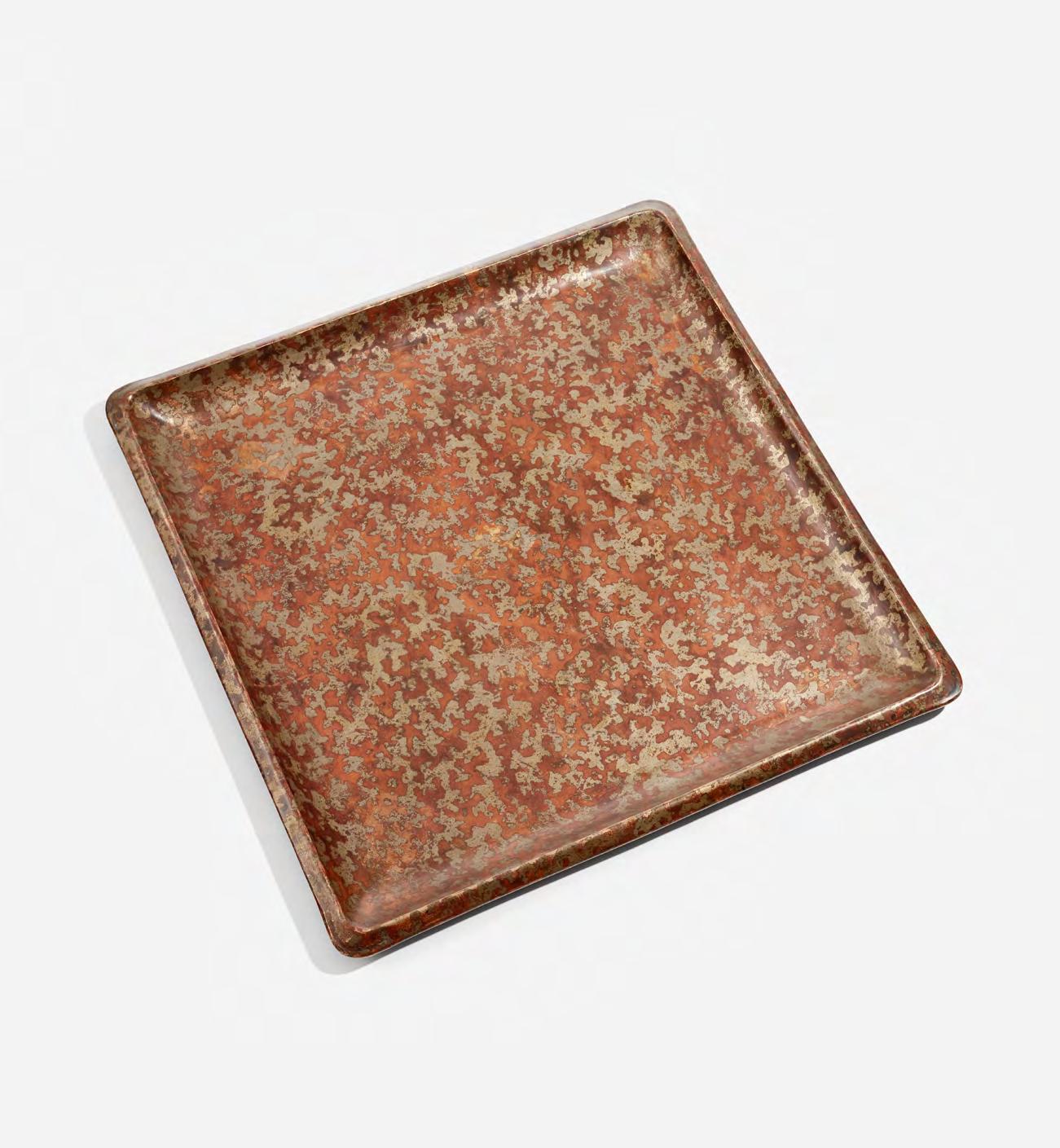
Footed bowl
circa 1980
Porcelain, inlaid pink radiating lines, turquoise and manganese bands. 2 7/8 in. (7.3 cm) high, 3 7/8 in. (9.8 cm) diameter
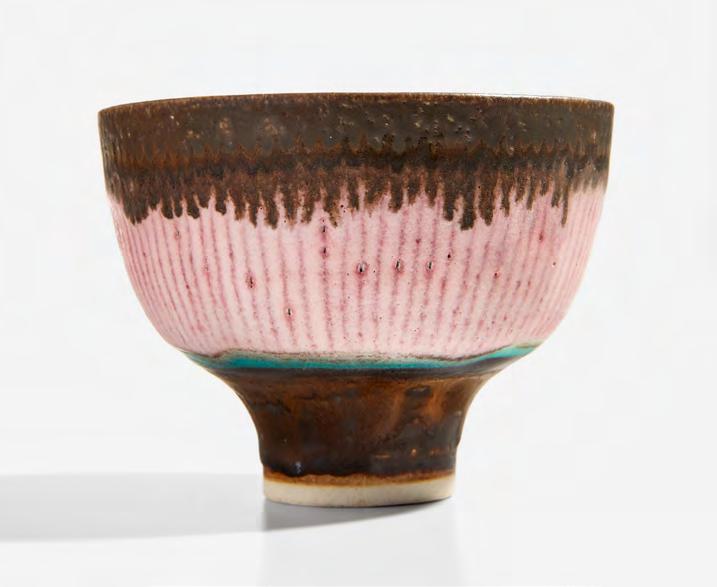
Underside impressed with artist’s seal.
Estimate $20,000-30,000
Gifted to Hans, Hedi and John Rie by the artist
Tony Birks, Lucie Rie, Catrine, 2006, p. 161 for a similar example
Property from the Collection of John Rie, Connecticut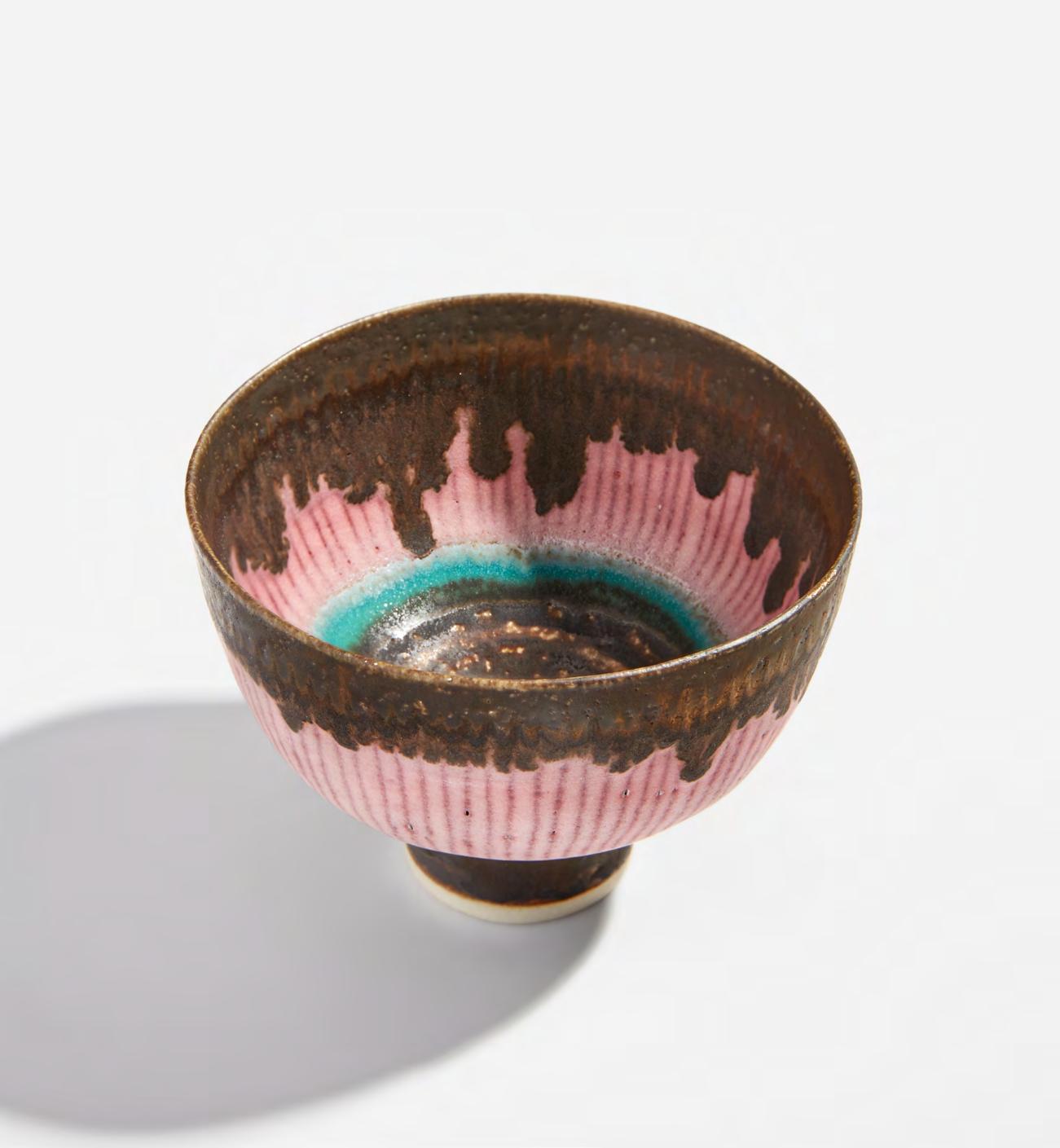
Property from a Private South Carolina Collection
“Bureau

2002
Patinated bronze, parchment. 32 1/8 x 61 x 31 1/4 in. (81.6 x 154.9 x 79.4 cm)
Cast by Blanchet-Landowski Foundry, Bagnolet, France. Number 6 from the edition of 8 plus 4 artist’s proofs. One leg impressed with artist’s cipher and 6 / 8/ Landowski/Fondeur/2002
Estimate
$20,000-30,000
Barry Friedman Ltd., New York
Acquired from the above by the present owner, circa 2004
Property from a Private South Carolina Collection
“Branches” mirror, model no. 210
designed 2003, produced 2006
Patinated bronze, mirrored glass. 54 1/2 x 51 1/2 x 6 in. (138.4 x 130.8 x 15.2 cm) Reverse with metal plaque impressed with artist’s monogram.
Estimate
$10,000-15,000
Maison Gerard, New York
Acquired from the above by the present owner, 2007
“Master of the Marais,” Architectural Digest, April 2005, p. 206
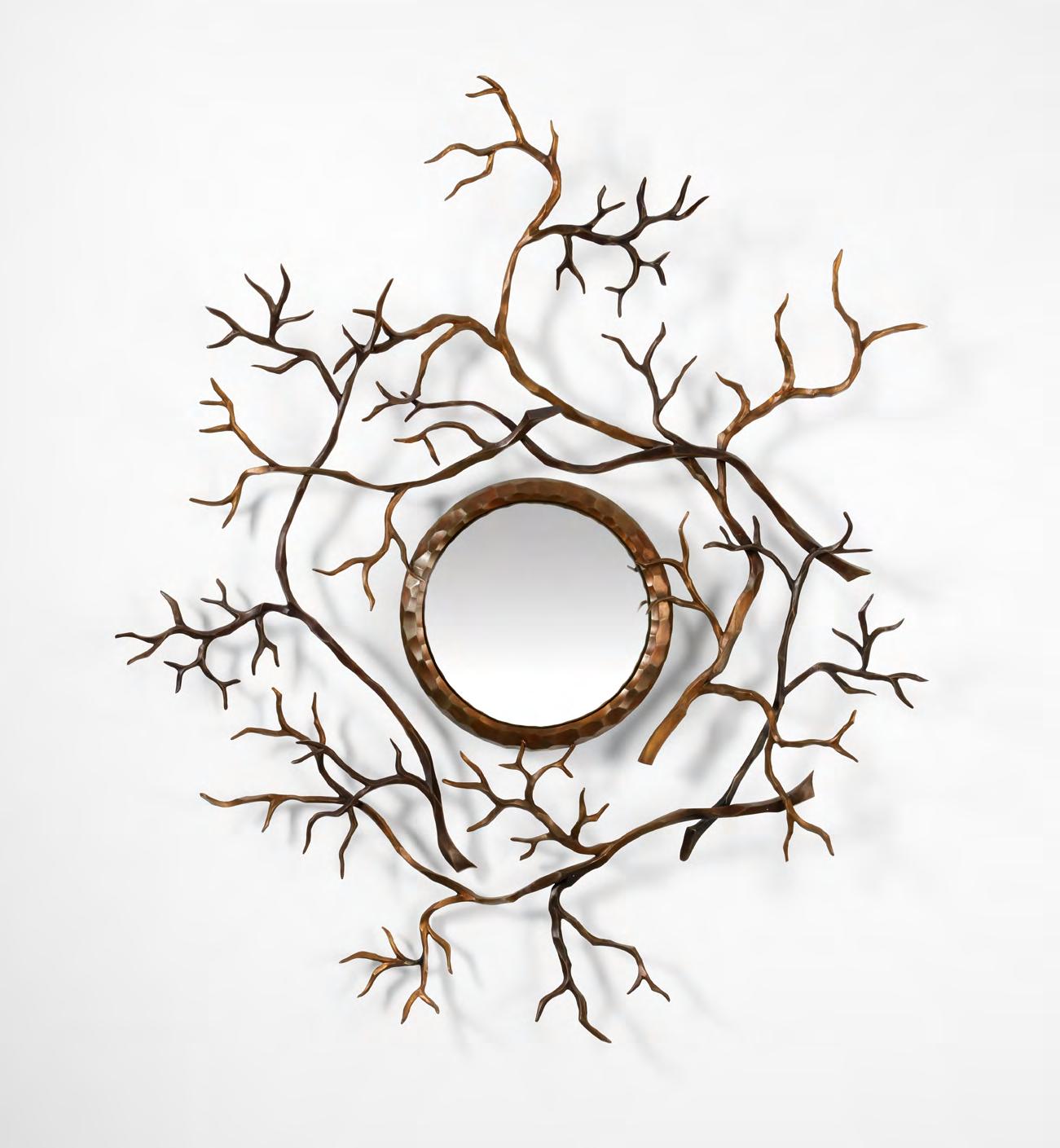
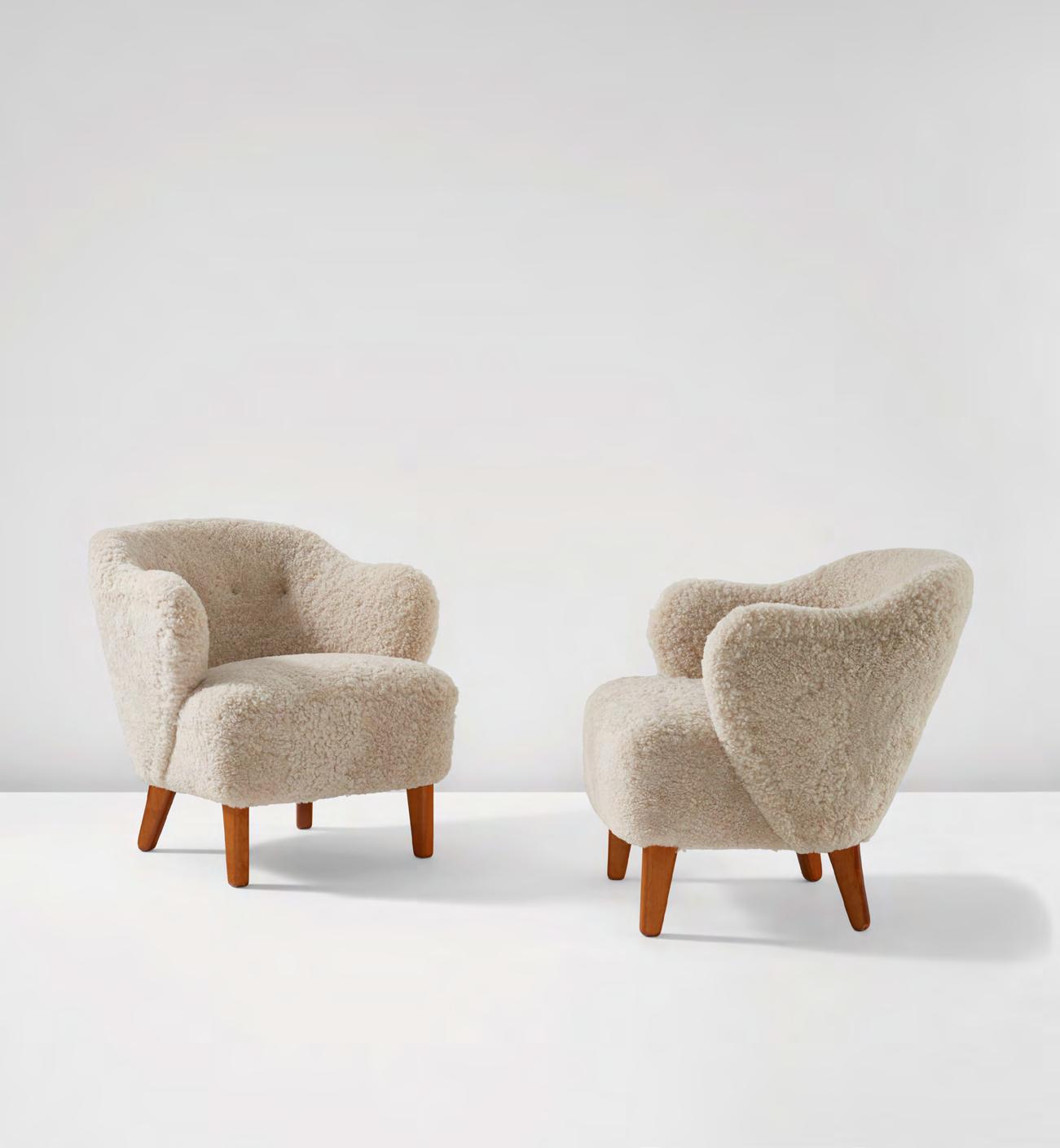
circa 1940
Birch, wool upholstery.
Each: 30 x 30 1/2 x 31 1/2 in. (76.2 x 77.5 x 80 cm)
Estimate $18,000-24,000
Private collection, Denmark, 1960s Anders Larsen, Copenhagen Acquired from the above by the present owner, 2020
Hans Christian Hansen, “Snedkerlaugets 14. Møbeludstilling,” Nyt Tidsskrift For Kunstindustri, no. 11, November 1940, p. 171
Grete Jalk, ed., Dansk Møbelkunst gennem 40 aar, Volume 2: 1937-1946, Copenhagen, 1987, p. 116
Sofa
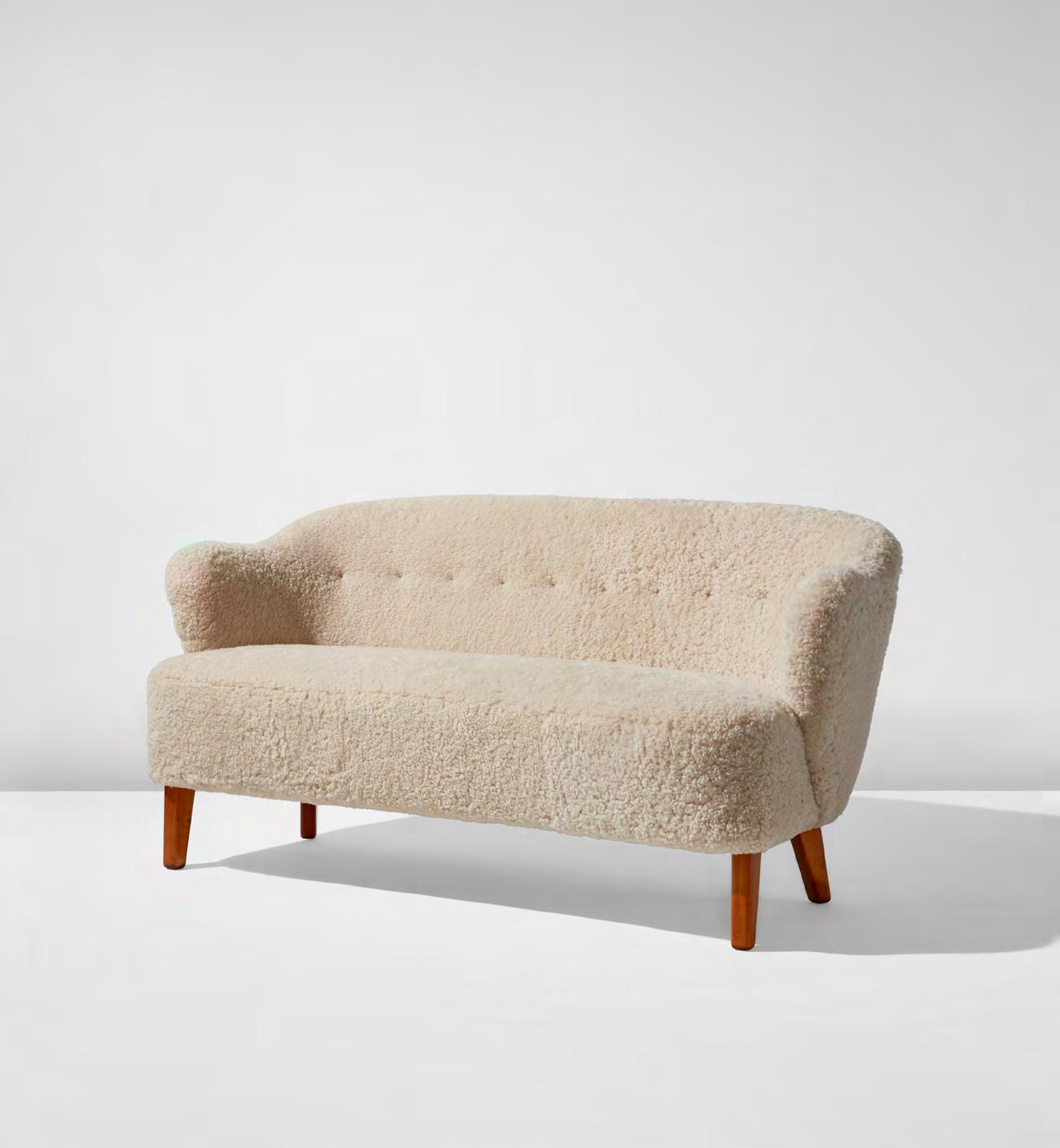
circa 1940 Birch, wool upholstery. 30 x 62 x 31 in. (76.2 x 157.5 x 78.7 cm)
Estimate $12,000-18,000
Private collection, Denmark, 1960s Anders Larsen, Copenhagen Acquired from the above by the present owner, 2020
Hans Christian Hansen, “Snedkerlaugets 14. Møbeludstilling,” Nyt Tidsskrift For Kunstindustri, no. 11, November 1940, p. 171 for the armchair version of the model Grete Jalk, ed., Dansk Møbelkunst gennem 40 aar, Volume 2: 1937-1946, Copenhagen, 1987, p. 116 for the armchair version of the model
“The Core of Power” (“Kraftens Kern”) sculpture
designed circa 1956, produced 1969-1974 Stoneware with Sung glazes. 21 in. (53.3 cm) high Produced by Royal Copenhagen, Denmark. Underside stamped ROYAL/ COPENHAGEN/DENMARK, incised SALTO and painted 21375 and blue wave mark.
Estimate $50,000-70,000
Antik, New York Acquired from the above by the present owner, 1998
Literature
Det Braendende Nu - Axel Salto, exh. cat., Kunstindustrimuseet, Copenhagen, 1989, p. 79
Axel Salto: Forces of Nature, Ceramics and Drawings, New York, 1999, p. 7
 Property of a Private Collector
Property of a Private Collector
Chaise longue with integrated swivel tray
circa 1953
Teak, beech, leather, brass. 36 x 27 x 57 3/4 in. (91.4 x 68.6 x 146.7 cm) Manufactured by Bovirke, Copenhagen, Denmark.
Estimate $15,000-20,000
Cynthia Kellogg, “Chair Designs Star in Furniture Show,” The New York Times, July 16, 1953, p. 16
Lois Wagner, “Scandinavian Signature: Tanier’s Nordic Luminaries,” Interiors, October 1953, p. 100 for the version without an armrest
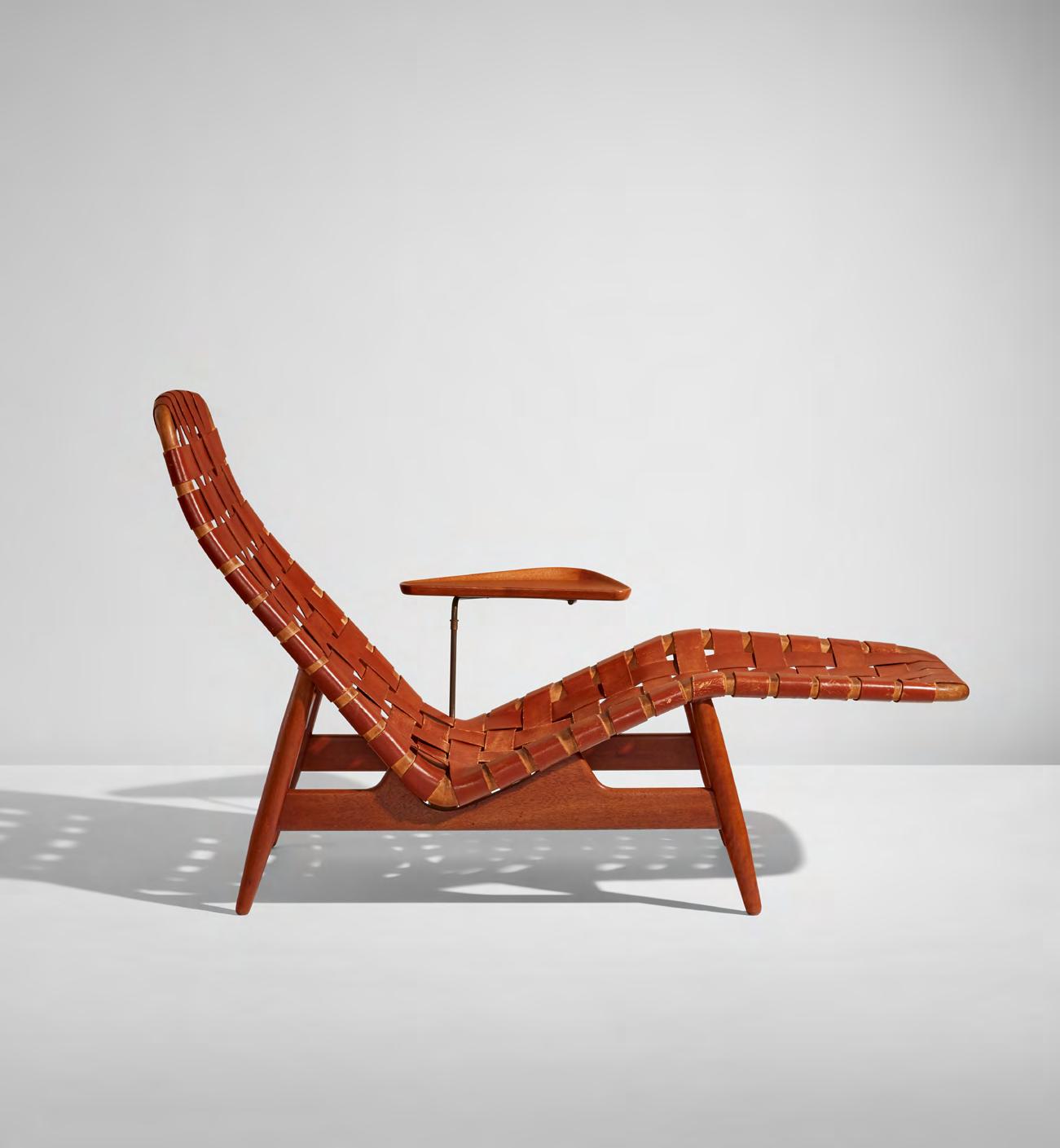
1961-2022, b. 1953
Unique “Esmeralda” ceiling light 2010 Wicker, glass, rope. 104 in. (264.2 cm) drop Glass produced by Venini, Murano, Italy. Estimate $15,000-20,000 Provenance Venini, Murano Acquired from the above
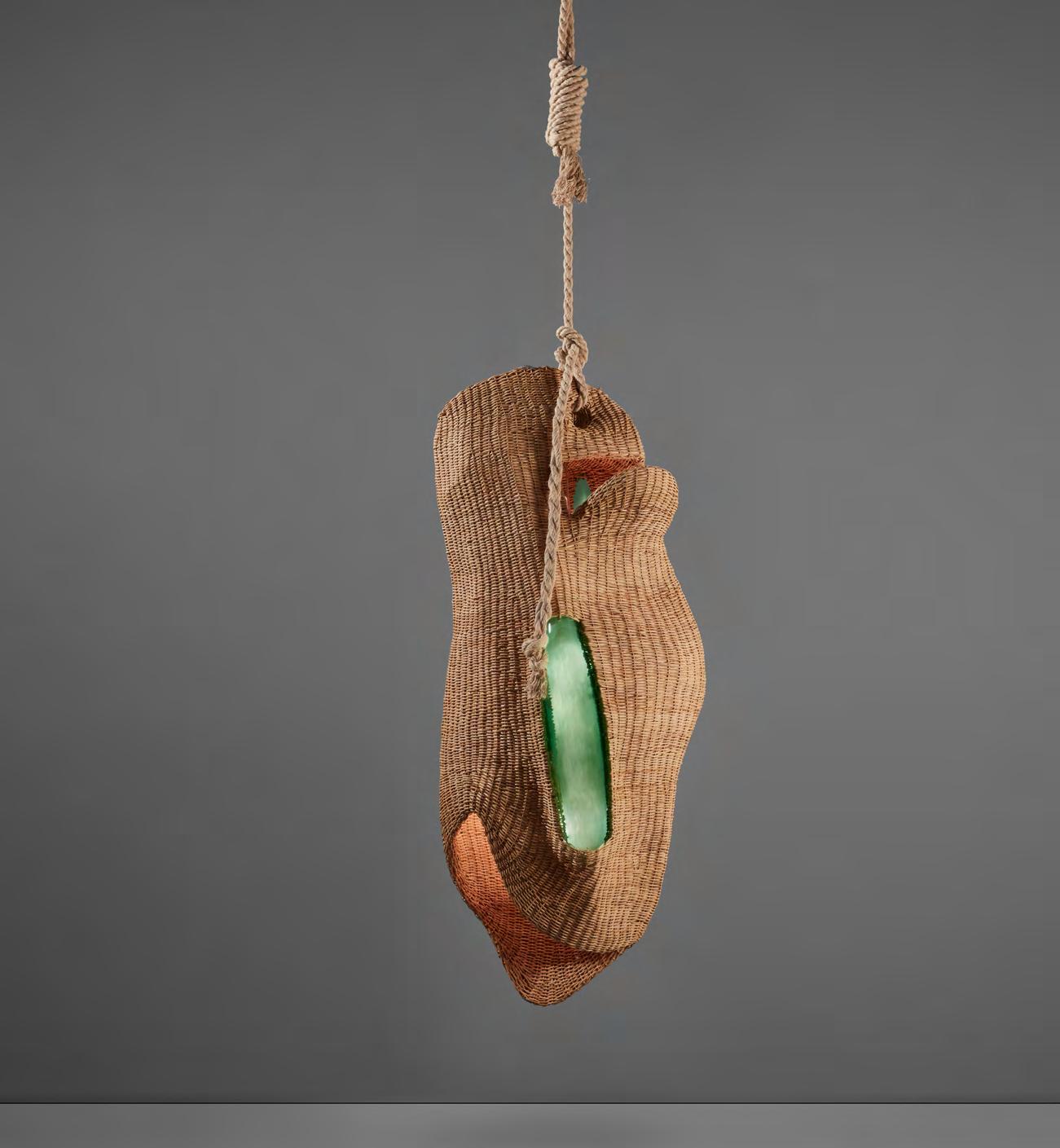
Literature Campana Brothers, Complete Works (So Far), New York, 2010, pp. 212-40 for other works cased in wicker
Phillips would like to thank Daniel Kini of Estudio Campana for his assistance cataloguing the present lot.
b. 1978
Pair of “Vazada” chairs 2014
Reclaimed Ipe. Each: 27 3/4 x 22 3/4 x 28 1/2 in. (70.5 x 57.8 x 72.4 cm)
Numbers 1 and 2 from the edition of 2. Edge of each chair impressed 2014/zanini and, respectively, 1 / 2 and 2 / 2
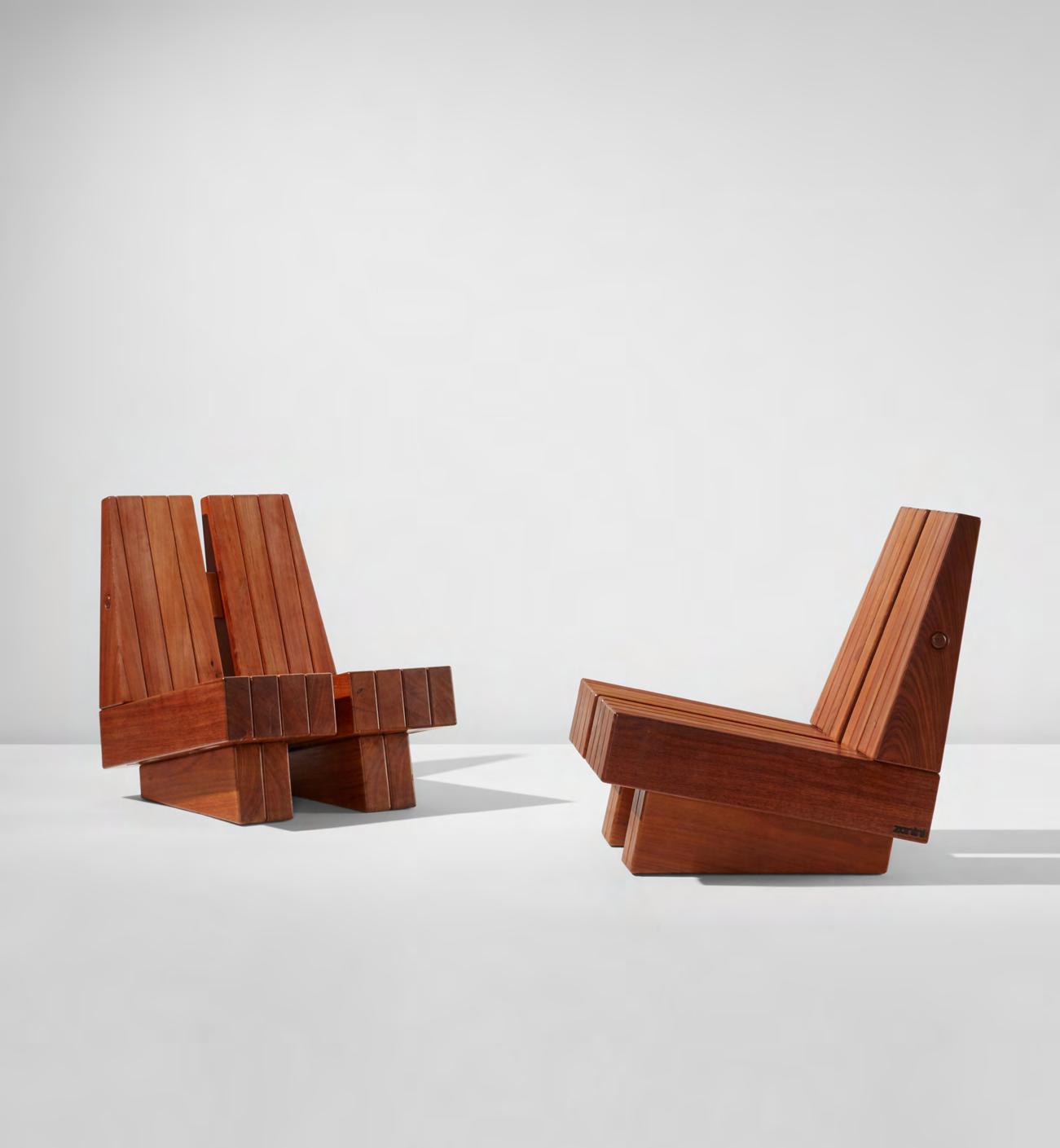
Estimate $6,000-8,000
Maria Cecília Loschiavo dos Santos, Zanini de Zanine: limited editions, São Paulo, 2015, pp. 48-49
Property from a Private West Coast Collection“Blue Grady,” from the “Thin Fin” series 2001
Earthenware, underglaze, glaze, overglaze, epoxy resin.
4 x 5 5/8 x 2 5/8 in. (10.2 x 14.3 x 6.7 cm)
Estimate $8,000-12,000
Garth Clark Gallery, New York Acquired from the above by the present owner, circa 2001
Property from a Private Collection, Philadelphia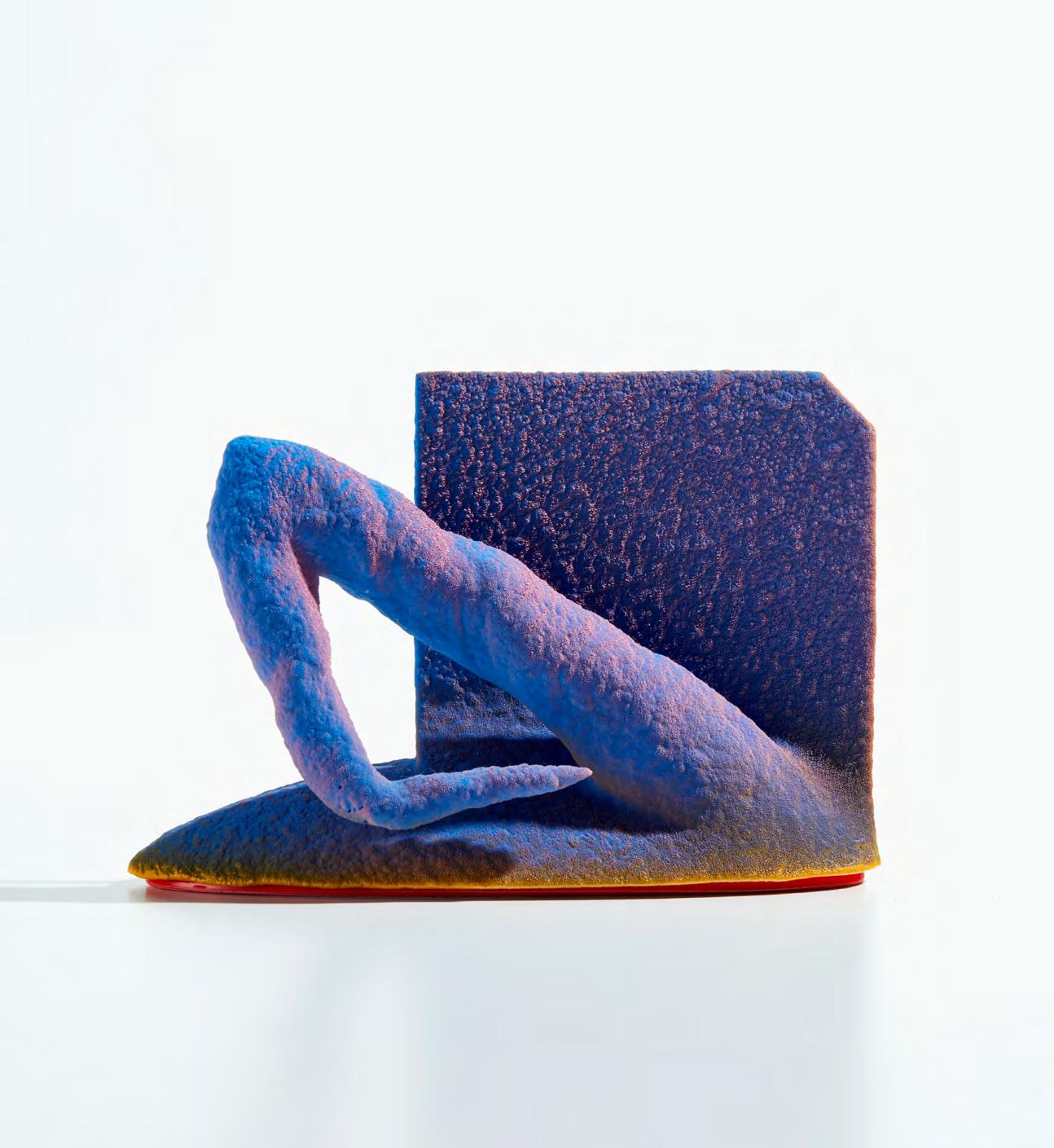
“Blue Fun One”
2004
Earthenware, underglaze, glaze, overglaze, epoxy resin. 2 1/2 in. (6.4 cm) high
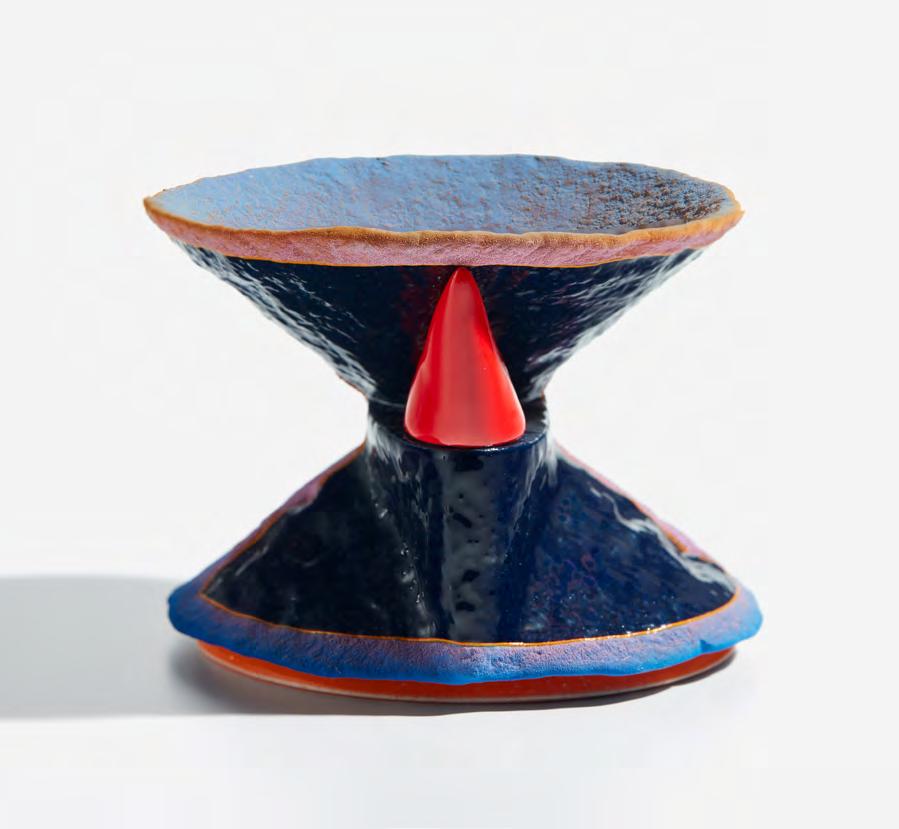
Estimate $6,000-8,000
Garth Clark Gallery, New York
Acquired from the above by the present owner, 2004
Property from a Private Collection, PhiladelphiaProperty from a Private Collection, Philadelphia
“Muy Shibui,” from the “Thin Fin” series 2001
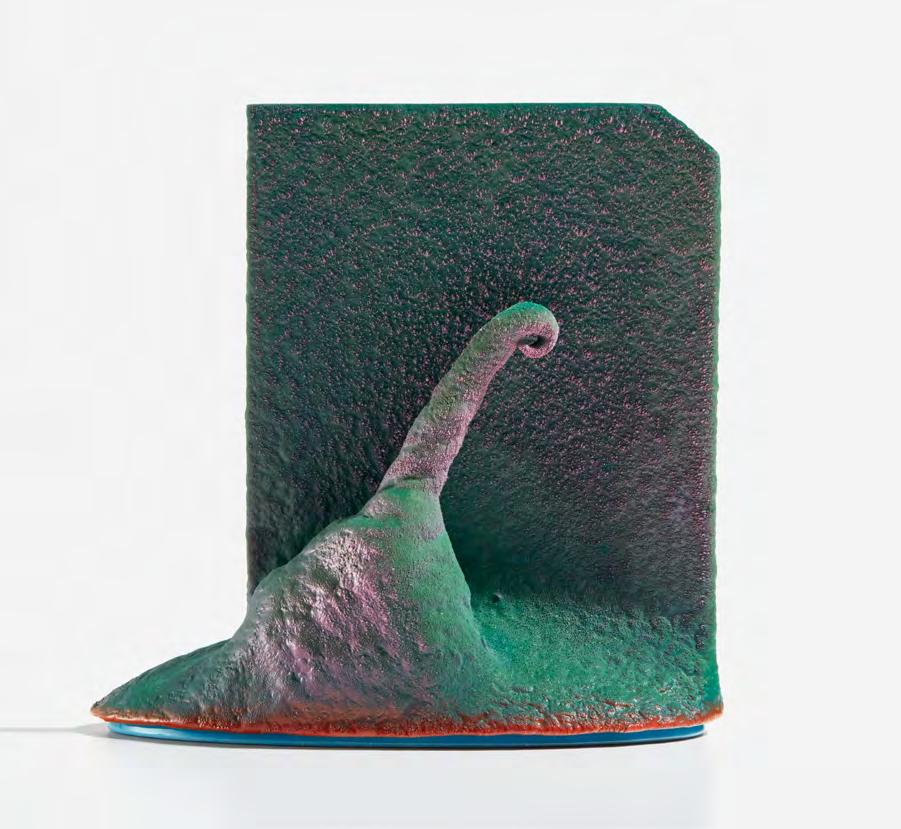
Earthenware, underglaze, glaze, overglaze, epoxy resin.
4 7/8 x 4 7/8 x 2 1/2 in. (12.4 x 12.4 x 6.4 cm)
Estimate $6,000-8,000
Garth Clark Gallery, New York
Acquired from the above by the present owner, 2002
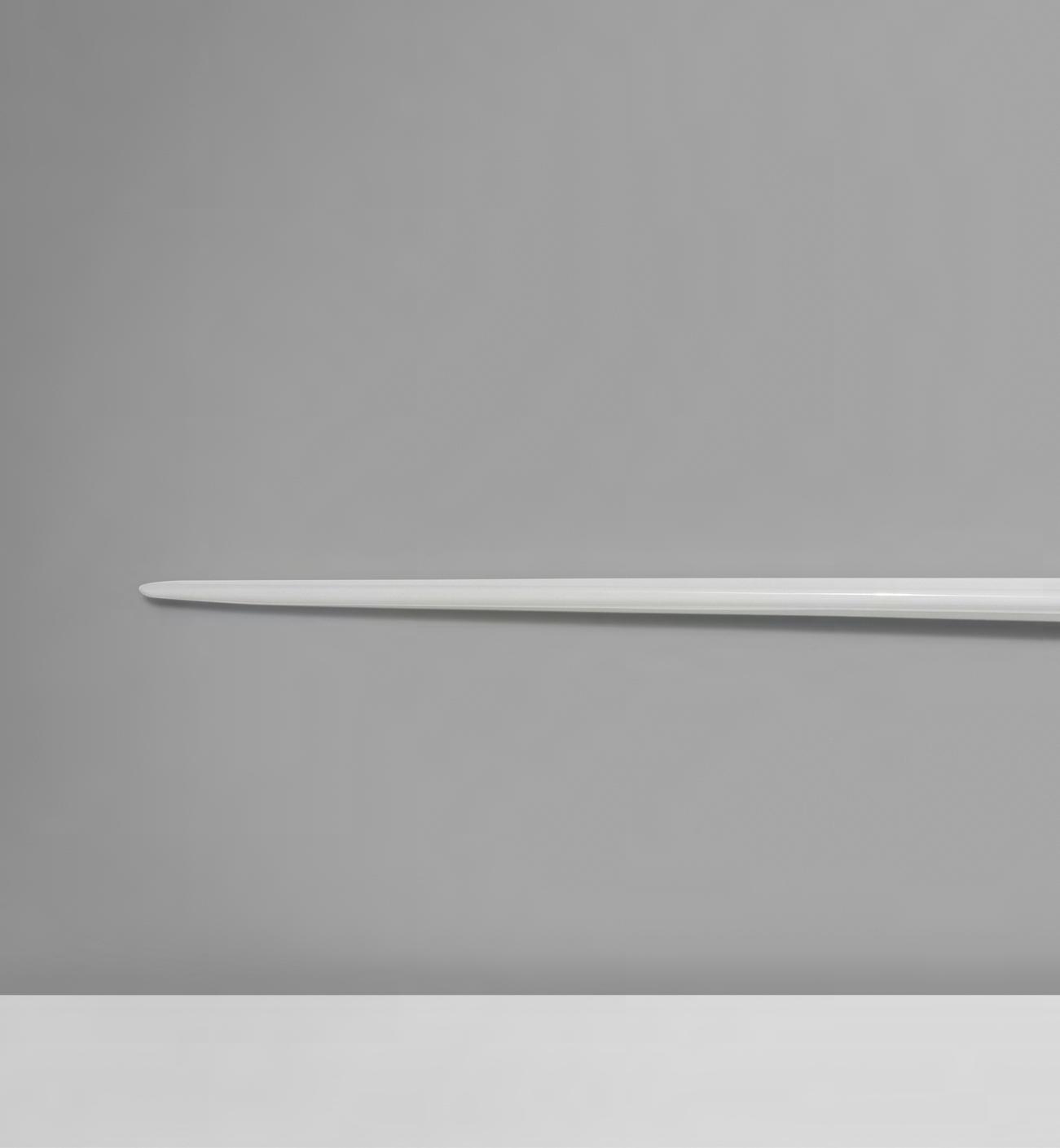
“Serif 4” wall-mounted shelf, from the “Seamless” collection 2006

Polyester resin. 15 x 150 x 16 1/4 in. (38.1 x 381 x 41.3 cm) Produced by Established & Sons, UK. Number 3 from the edition of 12. Back inset with two brass roundels impressed Designed by/Zaha Hadid/ Seamless / 2006/Serif 4 3 / 12 and Established/&SONS/British Made
Estimate $10,000-15,000
Private collection, New York Phillips, London, “The Architect, Created by Lee F. Mindel, FAIA,” April 29, 2014, lot 398 Acquired from the above by the present owner
Zaha Hadid: Seamless, exh. cat., Phillips de Pury & Company, New York, 2006, n.p.

Property from a Private Collection, Philadelphia
“Siren”
1984
Glazed and painted ceramic. 3 3/4 x 6 x 3 1/4 in. (9.5 x 15.2 x 8.3 cm)
Estimate $50,000-70,000
Provenance
Franklin Parrasch Gallery, New York
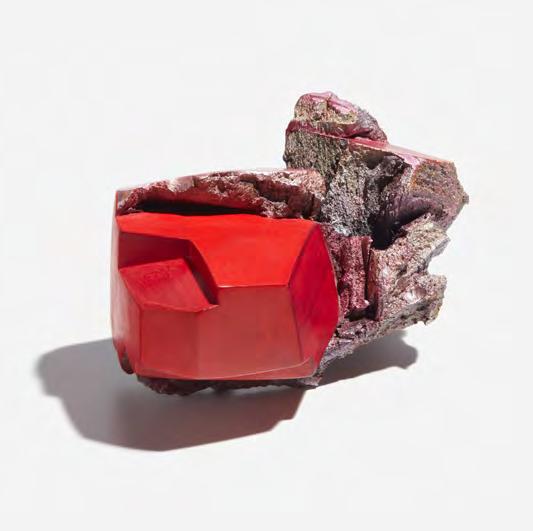
Acquired from the above by the present owner, 2002

“Murmansk” fruit bowl
circa 1982
Sterling silver. 11 1/2 in. (29.2 cm) high, 14 1/8 in. (35.9 cm) diameter
Produced by Rossi & Arcandi, Monticello Conte Otto, Italy for Memphis, Milan, Italy. Top impressed MEMPHIS/MILANO and with hallmark and 925
Estimate $10,000-15,000
Icon 20, New York, “Important Postwar and Contemporary Design,” June 6, 2000, lot 164
Acquired from the above by the present owner
Memphis Furniture Milano, sales catalogue, Milan, 1984, n.p.
Property from a Private New York Collection
“Untitled” 1991
Glazed earthenware. 44 x 23 x 15 1/2 in. (111.8 x 58.4 x 39.4 cm)
Estimate $20,000-30,000
Nancy Hoffman Gallery, New York
Acquired from the above by the present owner, 1992
Literature
Rena Bransten Gallery, Viola Frey, San Francisco, 1994, p. 12 for a similar example
Ceramic artist Viola Frey was born on a grape farm in Lodi, California during the Great Depression. Though she moved across the United States during her early adult life—from Oakland to New Orleans to New York and back to Oakland—her childhood surroundings left an indelible mark on her work. Describing her initial artistic influences, she said, “I had to make my own culture.” Frey’s work often takes from the everyday; as a figurative artist, her character representations range from figurines found at flea markets to the archetypes of men and women that she encountered in day-to-day life.
Frey initially trained as a painter under Richard Diebenkorn at the California College of Arts and was influenced by the Bay Area Figurative Movement artists such as Diebenkorn and Elmer Bischoff. Throughout her career she created works in clay, paintings, and drawings. The visual iconography of her work is largely the same across her mediums, but it is her ceramic pieces which remain her most important artistic contributions. Similar to many of her contemporaries in California during the 1960s and 1970s, she resisted the dichotomy between art and craft and saw herself as an artist who worked with clay.
Explaining her early interest in ceramics, she said, “[Ceramics] had people of all ages in it. It seemed more like the real world. It was a community.” Her works in clay are hand-built and often monumental in scale and applied with bright, expressive glazes in a painterly fashion. She used the clay surface as a canvas, saying, “[I applied color] as a painter would. Never as decoration. And that had its own interesting story, when you talk about surface not as decoration but as painting.”
The present work, though more intimate in scale than many of her works, is an archetypal example of the types of tableaux that she created. A man and woman stand side-by-side—both in suits, which Frey considered to be a symbol of power—and appear in shock or fear. There is a vulnerability to the suited figures that contrasts the powerful and dominant expressions of men that characterized her earlier works. In front of the two primary figures sits what appears to be the three Graces from ancient Greek mythology as well as a monkey and dog. On the reverse of the sculpture sits a small faceless figure with its arms crossed and hand to its head. Glazed in an expressionist fashion, Untitled resists any explicit storyline and instead explores the Everyman and Everywoman as well as the material and aesthetic possibilities of the clay medium.
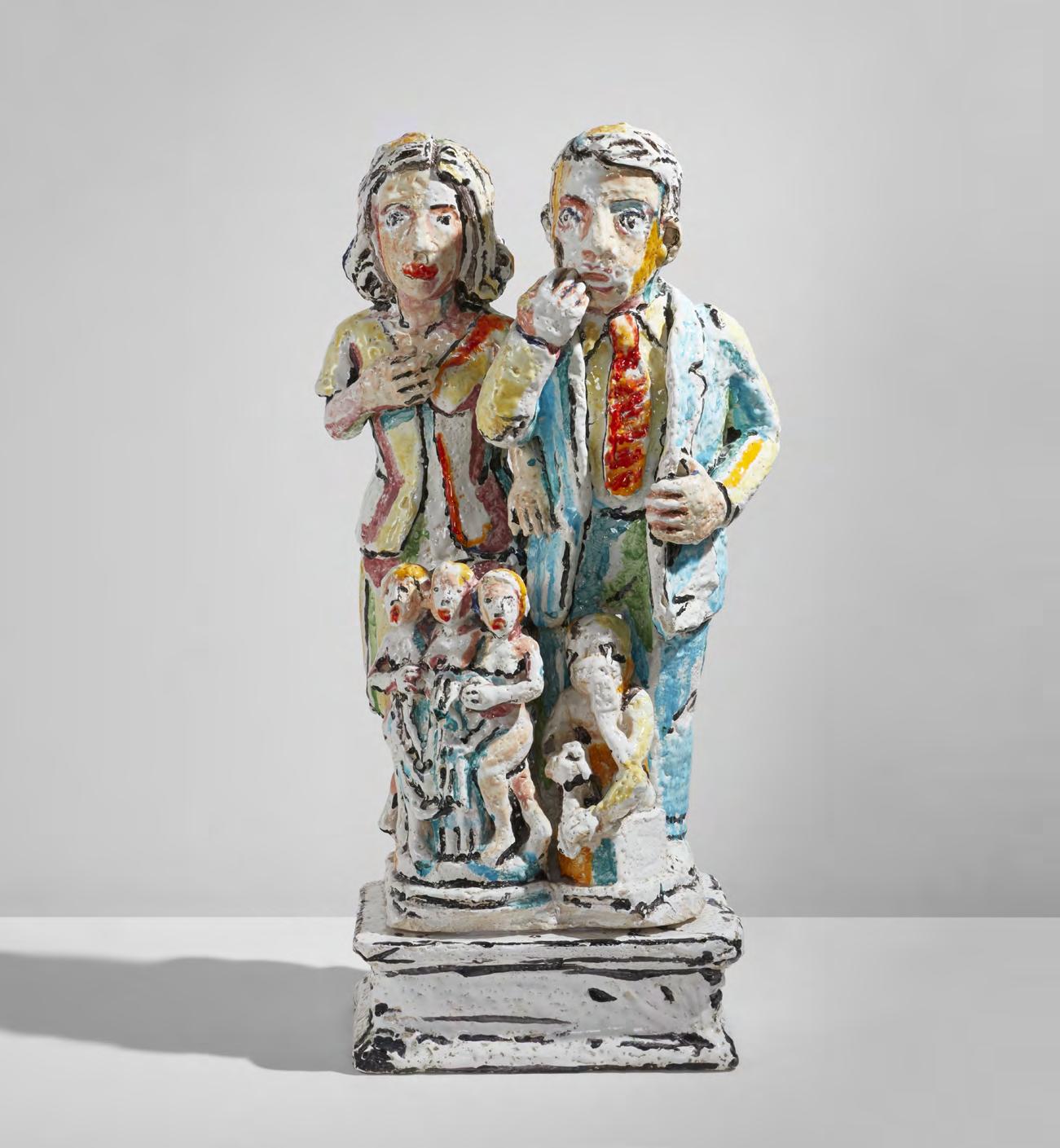
“Unicorn” side table
circa 1957
Walnut-veneered wood, walnut, brass. 24 1/4 x 31 1/4 x 22 1/8 in. (61.6 x 79.4 x 56.2 cm)

Manufactured by Kagan-Dreyfuss, Inc., New York.
Estimate $12,000-18,000
Sollo Rago, Lambertville, New Jersey, “20th Century Modern Weekend,” April 21, 2007, lot 464
Acquired from the above by the present owner
Vladimir Kagan, Vladimir Kagan: A Lifetime of Avant-Garde Design, New York, 2015, pp. 13, 122
Property from a Private Manhattan Collection“Contour” armchair
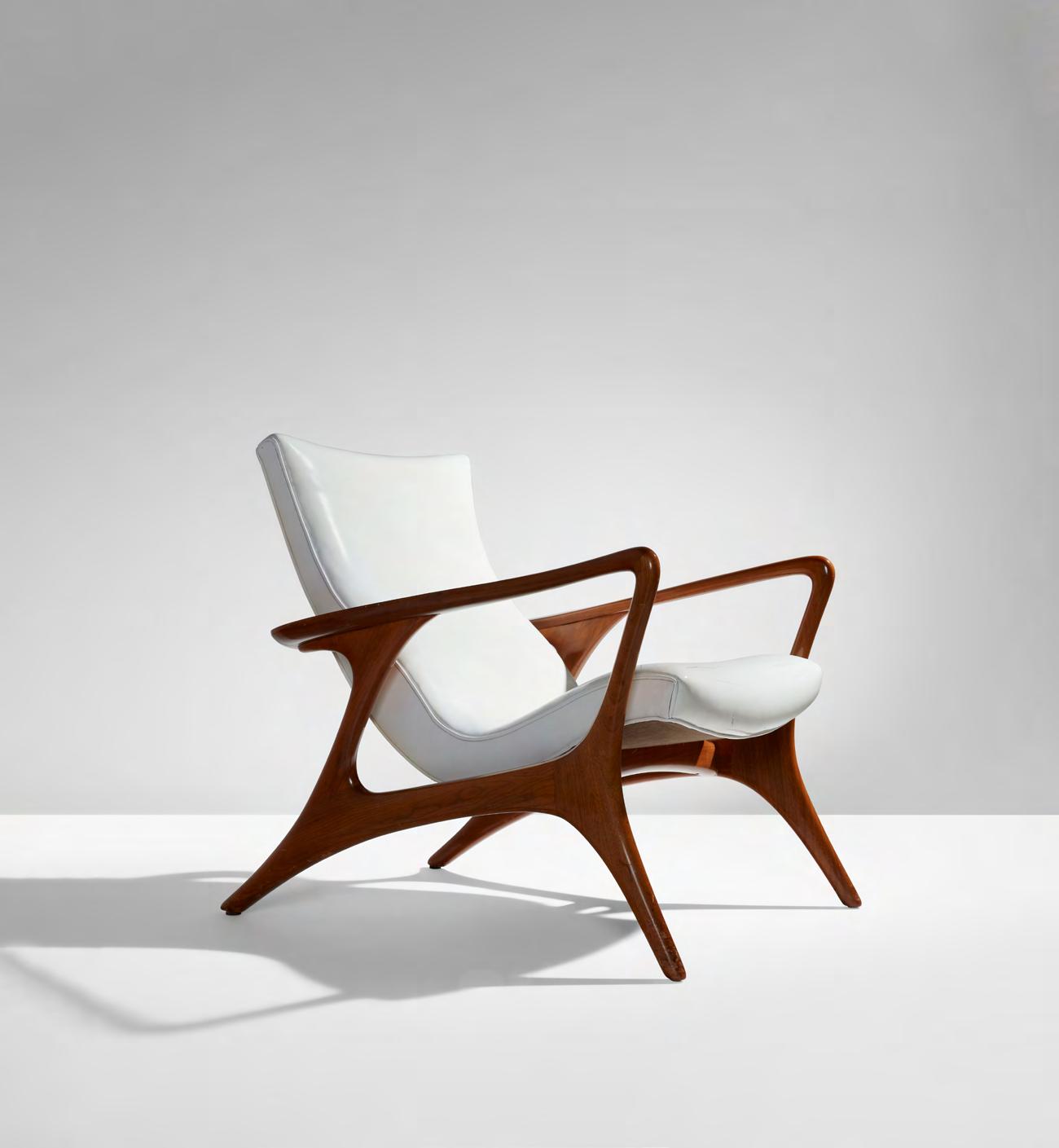
circa 1953
Walnut, leather upholstery. 31 1/2 x 28 3/4 x 35 in. (80 x 73 x 88.9 cm) Manufactured by Kagan-Dreyfuss, Inc., New York. Underside of backrest branded KAGAN-DREYFUSS New York/A VLADIMIR KAGAN DESIGN
Estimate $7,000-9,000
Sollo Rago, Lambertville, New Jersey, “20th Century Modern Weekend,” April 21, 2007, lot 468 Acquired from the above by the present owner
Vladimir Kagan, Vladimir Kagan: A Lifetime of Avant-Garde Design, New York, 2015, pp. 58, 99, 103-05, 131, 174, 224-25
Property from a Private Manhattan Collection1982
Painted wood.
53 x 57 x 43 1/2 in. (134.6 x 144.8 x 110.5 cm)
Number 1 from the edition of 2.
Estimate
$15,000-20,000
Daniel Weinberg Gallery, Los Angeles, acquired directly from the artist Thence by descent to the present owners
Brenda Richardson, Scott Burton, exh. cat., Baltimore Museum of Art, 1986, illustrated p. 58
Jiri Svestka, ed., Scott Burton: Sculptures, 1980-89, Düsseldorf, 1989, p. 50
Property from a Private American Collection
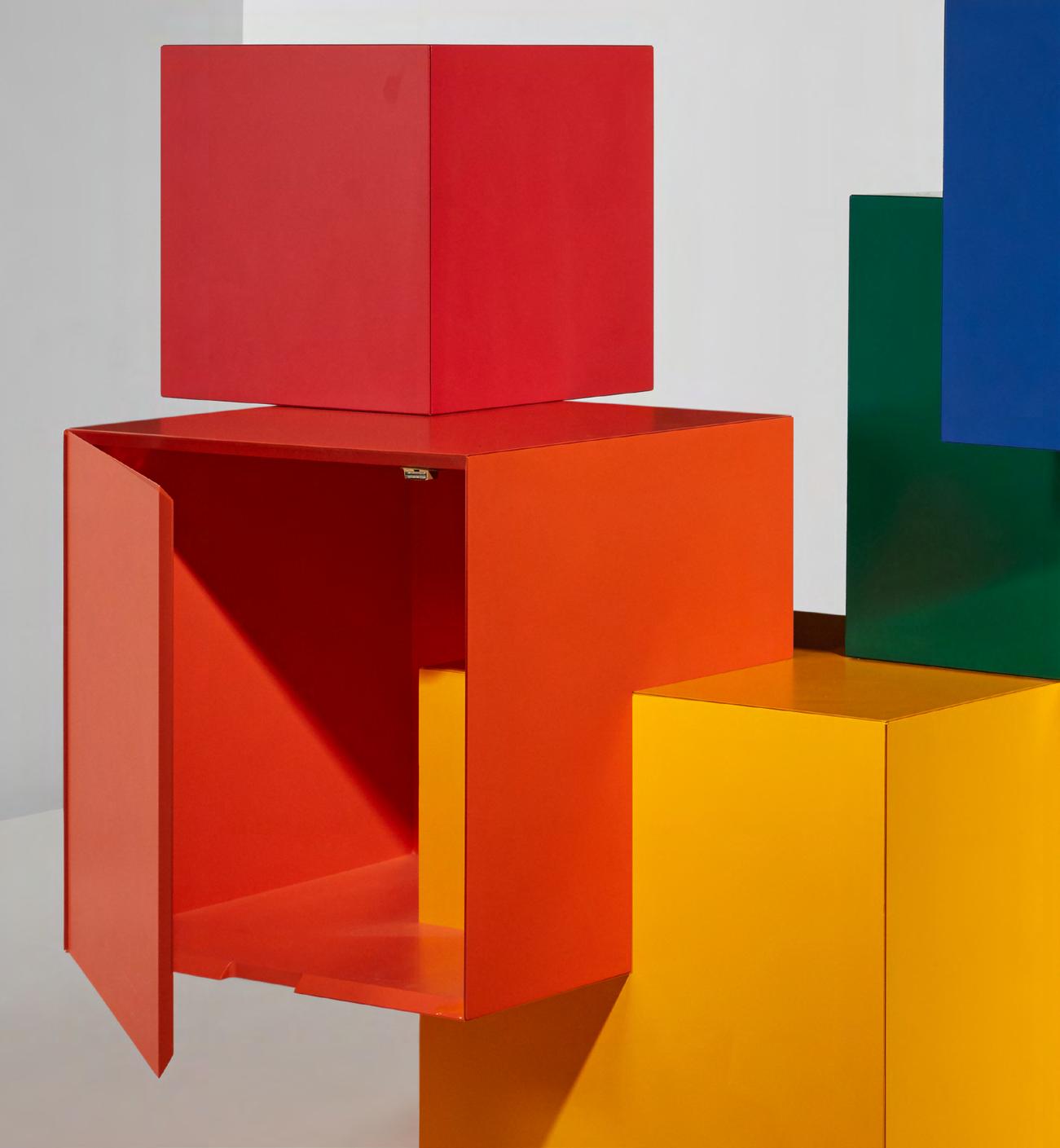
Scott Burton took an unconventional path to his career in furniture design. First working as a critic for Art News and Art in America, in the early 1970s he began making performance art that incorporated found objects before finally creating stand-alone furniture in rigorous geometric forms that dissolved the boundaries between art and design. While his contemporary Donald Judd created minimalist furniture outside his sculptural practice, for Burton furniture-making was his sculptural practice.
The present lot, Five-Part Storage Cubes, is a departure from Burton’s body of work in a number of ways. Whereas the majority of his designs take their color and pattern from the inherent qualities of the material at hand, such as sparkly grey granite, green marble, or striated plywood, Burton crafted Five-Part Storage Cubes from painted wood in bold, saturated colors. Burton also primarily focused on table and seating forms, whereas the present work is a storage piece, meant for an interior space as opposed to the public outdoor spaces that informed many of his commissions.
On the other hand, Burton’s fundamental interest in the interaction of art and people—a through-line from his earlier forays in performance art—remains at play with the present work. Burton believed that art should “place itself not in front of, but around, behind, underneath (literally) the audience.” Standing nearly five feet tall and finished on all sides with cabinets facing in all directions, Five-Part Storage Cubes takes up space, inviting the viewer to explore it from all sides. Despite its mass and stature, it also exhibits movement and dynamism, with the cubes seemingly floating upwards.
As an avid student of design history, Burton took inspiration from Constructivism, the Bauhaus, and the De Stijl movement—most notably the furniture of Gerrit Rietveld, whose interest in intersecting rectilinear planes clearly informed the composition of Five-Part Storage Cubes
1967 Stack-laminated oak. Each: 31 1/2 x 19 1/2 x 23 in. (80 x 49.5 x 58.4 cm) Underside of each incised W.C. 67.
Estimate $50,000-70,000
Phurniture, Inc., New York Acquired from the above by the present owner, 2004
Eleanor Dienstag, “Happy birthday, Shop One,” Democrat and Chronicle, Rochester, September 24, 1972, one chair illustrated p. 20
Emily Evans Eerdmans, Wendell Castle, A Catalogue Raisonné 1958-2012, New York, 2014, one chair illustrated p. 97
Property from an Important American Collection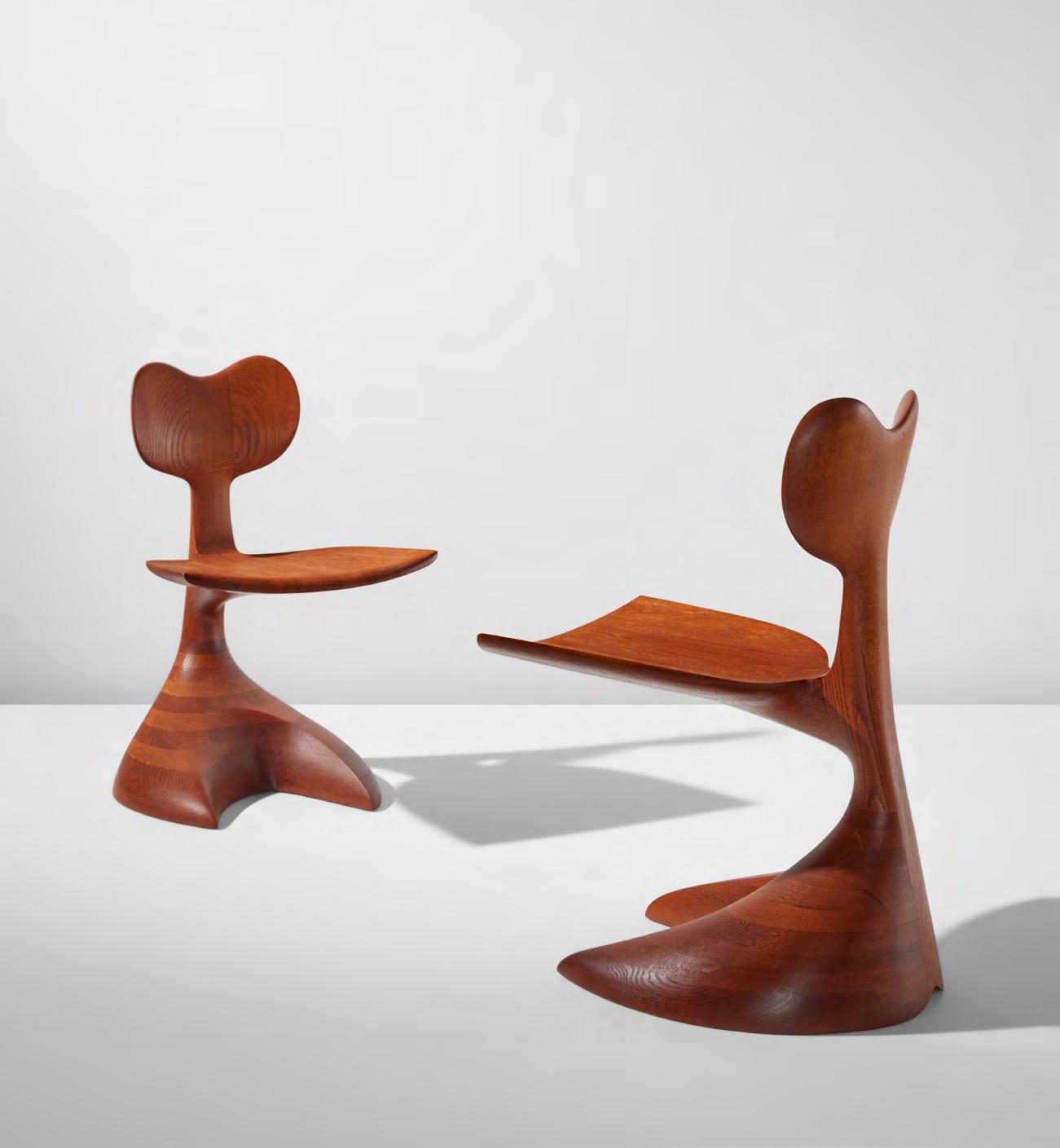
“Oh Void 2”
2004 Corian.
28 1/2 x 23 5/8 x 46 1/2 in. (72.4 x 60 x 118.1 cm)
Number 3 from the edition of 6 plus 3 artist’s proofs. Edge incised Ron Arad 3 / 6
Estimate $40,000-60,000
Acquired directly from the artist by the present owner
Barry Friedman Ltd., Ron Arad: A Retrospective Exhibition, 1981-2004, New York, 2005, pp. 43, 100
Ron Arad: No Discipline, exh. cat., Centre Pompidou, Paris, 2008, pp. 122-23
Paola Antonelli et al., Ron Arad: No Discipline, exh. cat., The Museum of Modern Art, New York, 2009, p. 110
Ron Arad’s Oh Void 2 belongs to a family of seating in which the London-based, Tel Aviv-born designer explored the design potential of high-tech and unconventional materials. The dimensions and proportions of each version from the group vary but all adhere to the same basic form: that of a rocking chaise longue composed of two joined ellipses. For the first version, created in 2003 as part of the “Paperwork” collection, Arad used carbon fiber.
A year later, Arad experimented with Corian, a hard-wearing plastic more often associated with kitchen countertops than high-design furniture. Dupont, the manufacturer of Corian, created the material in 1967 by combining fine minerals (aluminum hydroxide) with plastic (acrylmethly methacrylate), which was intended for bathroom and kitchen interior surfaces. Later, anxious to explore the material
possibilities of their material, Dupont contacted Arad to create a number of works in Corian, including the present model chaise. Due to the nature of the material, Arad was able to work with Corian almost as if it were hardwood, carving out a sculptural piece of functional design. Though Dupont marketed the fact that Corian could be invisibly bonded to itself, Arad playful layered the material with an adhesive tinted in a contrasting color, which, when carved into the chaise form achieved an undulating wood grain pattern not unlike Japanese mokume
Later versions of Arad’s Void chairs were made using alternating layers of clear and opaque acrylic as well as rotational-molded polyethlene, creating fascinating patterns of light and color. Another example from the present edition belongs to the Stedelijk Museum, Amsterdam.
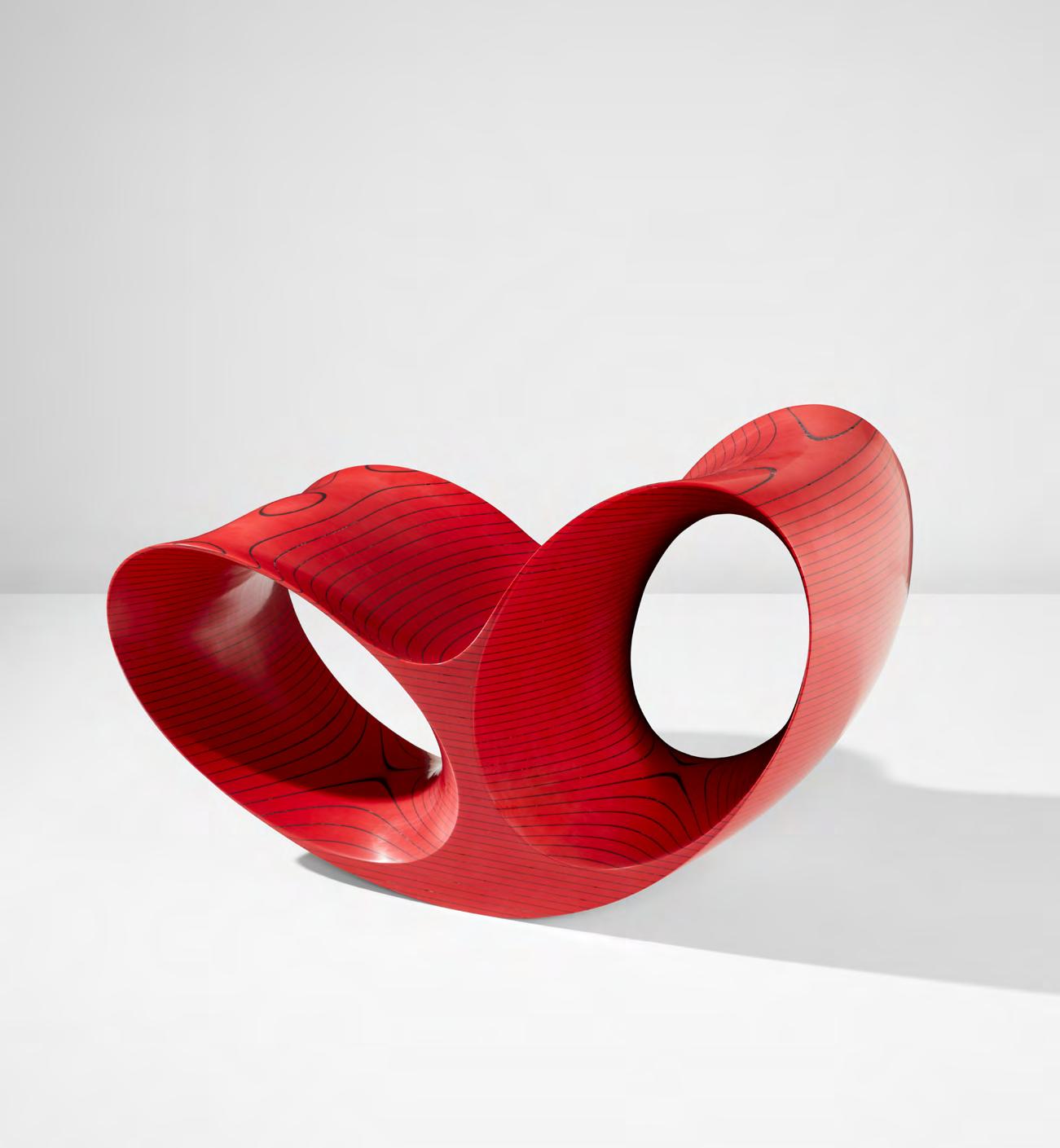
The success of Marcel Breuer’s first experiments with tubular steel furniture in 1925-1926 inspired various architect-designers to have a go at this alluring new material. Until then, Rietveld had worked almost exclusively with wood. Presumably his first attempt to develop a metal chair was an armchair for Dr. A.M. Hartog which can be dated before 1927 and which shows Rietveld’s inexperience with the new material, using gaspipes and T-fttings which mimicked the straight posts and rails and traditional joints found in his wooden chairs. In 1927, Rietveld developed the Beugel chair (Beugel meaning bracket), composed of two bracket-shaped tubular steel frames that supported a fibreboard seating shell. In June of the same year, both Mart Stam and Ludwig Mies van der Rohe showed their first cantilever tubular steel chairs at the now legendary Weissenhof exhibition. It is not known whether Rietveld developed the Beugel chair before or after that date, but it is clear that his chair did not exploit the flexible characteristics of tubular steel which made the chair of Mies van der Rohe such an instant success. In October 1927, the Beugel chair was exhibited in Rotterdam alongside Mies’ chair and a tubular steel armchair by Dutch designer and entrepreneur W.H. Gispen.
The real innovation in Rietveld’s Beugel chair however was not found in the frame but in the undulating seat and backrest. Arguably, Rietveld was the first modern designer to develop a one-piece seating shell, predating Alvar Aalto’s experiments. For the initial prototypes of the Beugel chair, Rietveld used solid steel rod for the frame and seat sections out of Vulkanfber: an industrial fibreboard that could be shaped after being soaked in water and (more or less) kept its form when dried. Given his interest for unconventional materials in cabinet making, Rietveld immediately saw the potential of this fibre composite that was mainly used for the production of cheap imitation-leather suitcases. In 1928, the Beugel chair made its international debut in Stuttgart at the ‘Der Stuhl’ exhibition where it was picked up quickly by the international press, which commented on the groundbreaking seating shells. But it was not until 1930-1931 that the Beugel chair was taken into production by the avant-garde department store Metz & Co, in a version with tubular steel frames and plywood seat sections such as the present lot.
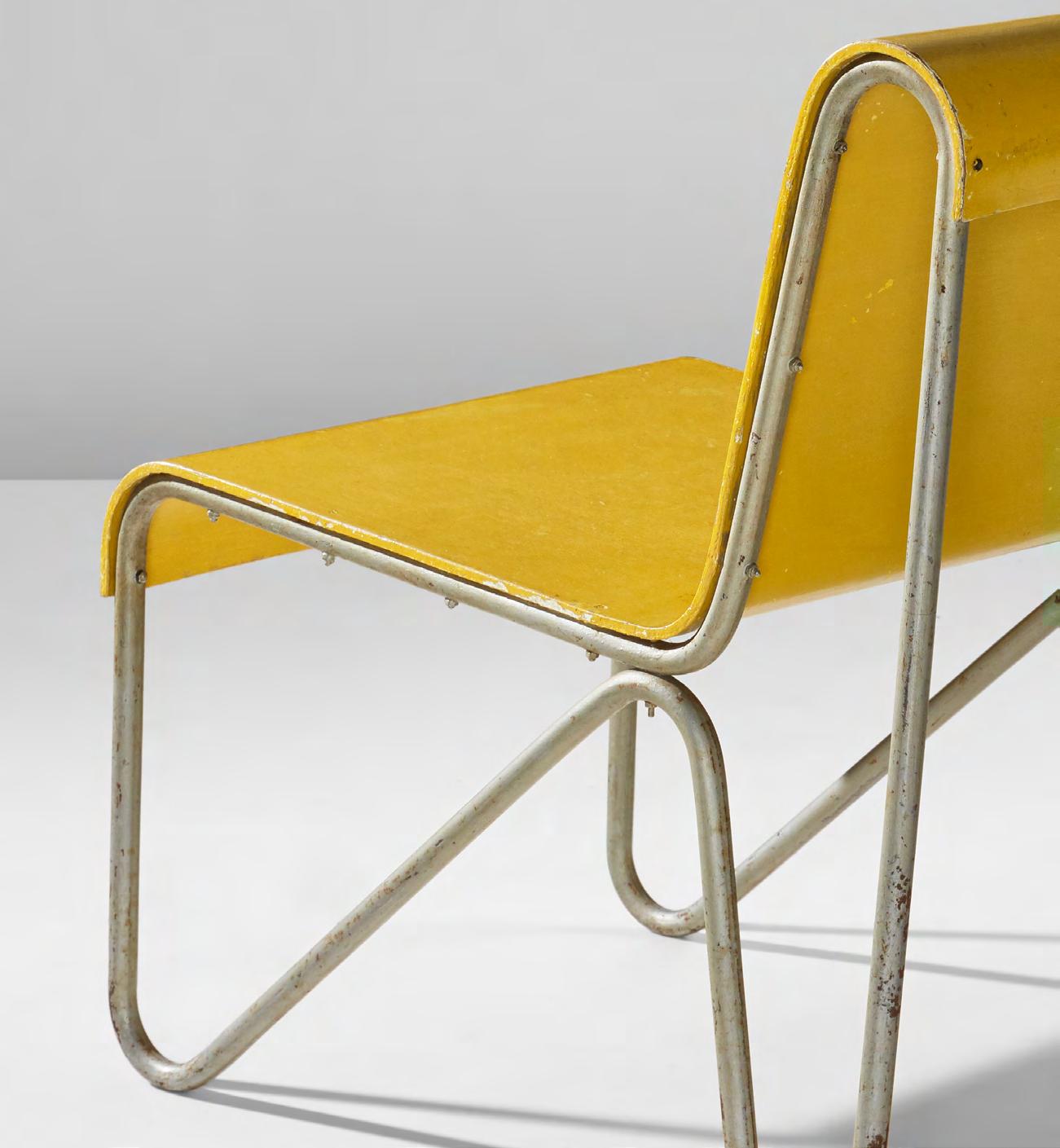
1888-1964
“Beugelstoel”
designed 1927, produced 1930-1931
Tubular steel with original aluminumpaint, birch plywood with original yellow paint.

23 1/2 x 15 5/8 x 24 1/4 in. (59.7 x 39.7 x 61.6 cm)
Produced by Metz & Co, Amsterdam, the Netherlands.
Estimate $25,000-35,000
Willem and Anna Kaas-Buijs, acquired from Metz & Co., The Hague, circa 1930
Thence by descent to Dr. Andries J.W. Kaas, the Netherlands
Thence by descent to Marianne Kaas, the Netherlands
Daniele Baroni, The Furniture of Gerrit Rietveld, Woodbury, 1978, pp. 116-19
Peter Vöge, The Complete Rietveld Furniture, Rotterdam, 1993, pp. 74-75
Ida van Zijl, Gerrit Rietveld, London, 2012, pp. 85, 92, 99
Property from a Private Collection, the Netherlands
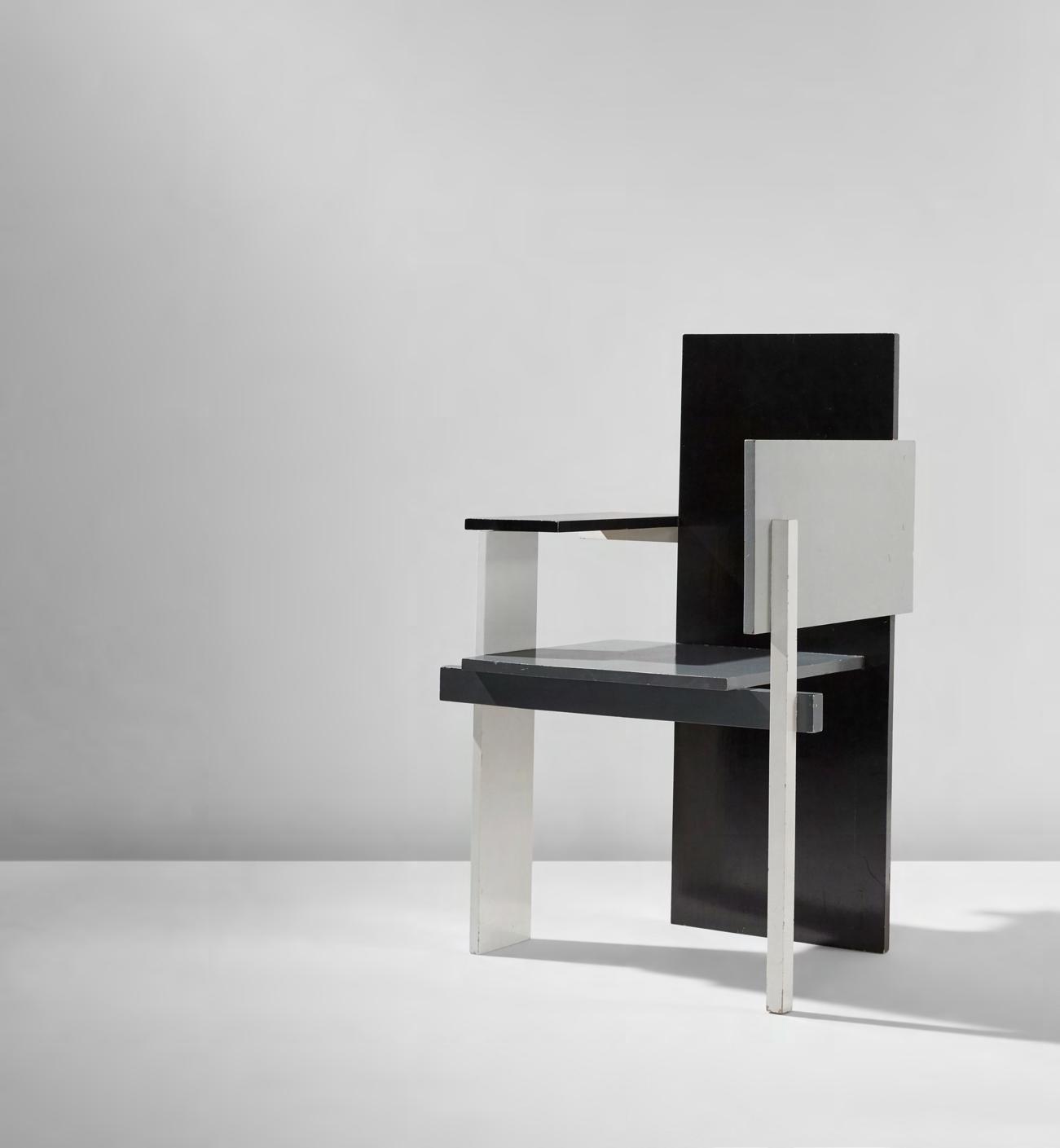
1888-1964
“Berlin” armchair designed 1923, executed circa 1957 Painted elm, painted beechwood. 42 x 29 x 21 1/2 in. (106.7 x 73.7 x 54.6 cm) Executed by Gerard van de Groenekan, De Bilt, the Netherlands. Underside with paper label printed G. A. v. d. GROENEKAN/Utrechtseweg 315, DE BILT and inscribed in pen NEDERLAND
Estimate $18,000-24,000
Provenance
Wright, Chicago, “Important 20th Century Design,” May 21, 2006, lot 212
Private collection, United States Phillips, London, “The Architect,” April 29, 2014, lot 325
Private collection, New York, acquired from the above Phillips, New York, “Design,” June 6, 2018, lot 115
Acquired from the above by the present owner
Peter Vöge, The Complete Rietveld Furniture, Rotterdam, 1993, p. 61 Ida van Zijl, Gerrit Rietveld, London, 2010, pp. 36, 51, 64, 162
Pair of windows, from the second Francis W. Little House, “Northome,” Wayzata, Minnesota
1912-1914 Glass, copper-plated zinc came, painted wood. Each: 58 1/2 x 9 x 1 7/8 in. (148.6 x 22.9 x 4.8 cm) Executed by the Temple Art Glass Company, Chicago, Illinois.

Estimate $12,000-18,000
Francis W. Little, Wayzata, Minnesota Christie’s, New York, “Important 20th Century Design,” June 7, 1996, lots 182-83 Acquired from the above by the present owner
Deborah S. Haight and Peter F. Blume, Frank Lloyd Wright: The Library from the Francis W. Little House, exh. cat., Allentown Art Museum, Allentown, Pennsylvania, 1978, cover Julie L. Sloan, Light Screens: The Complete Leaded-Glass Windows of Frank Lloyd Wright, New York, 2001, pp. 220-24 for other windows from the same commission
Phillips would like to thank Julie L. Sloan for her assistance cataloguing the present lot.
Property from the Estate of William Murphy, ArchitectProperty from the Estate of William Murphy, Architect
Pair of chairs, from the C. Leigh Stevens House, “Auldbrass” Plantation, Yemassee, South Carolina 1940s

Cypress, fabric upholstery. Each: 28 1/2 x 24 1/2 x 25 1/2 in. (72.4 x 62.2 x 64.8 cm)
Estimate $10,000-15,000
C. Leigh Stevens, Yemassee, South Carolina
Sotheby’s, New York, “American Arts and Crafts,” November 19, 1981, lot 275 Acquired from the above by the present owner
Janet Kardon, ed., Craft in the Machine Age: The History of Twentieth-Century American Craft, exh. cat., American Craft Museum, New York, 1995, p. 212
“Mobile Chandelier 1”
designed 2008, produced 2015 Satin brass, painted brass, glass, metal wire. 65 x 63 x 6 in. (165.1 x 160 x 15.2 cm)
Estimate $7,000-9,000
Ralph Pucci, Los Angeles Acquired from the above by the present owner, 2015
Jonathan Shia, “Turn Around Bright Eyes,” Interview, April 2011, p. 50
The present model ceiling light is typically finished in black patinated brass. The present example, however, was produced with a satin brass finish as a special request.
Property from a Private West Coast Collection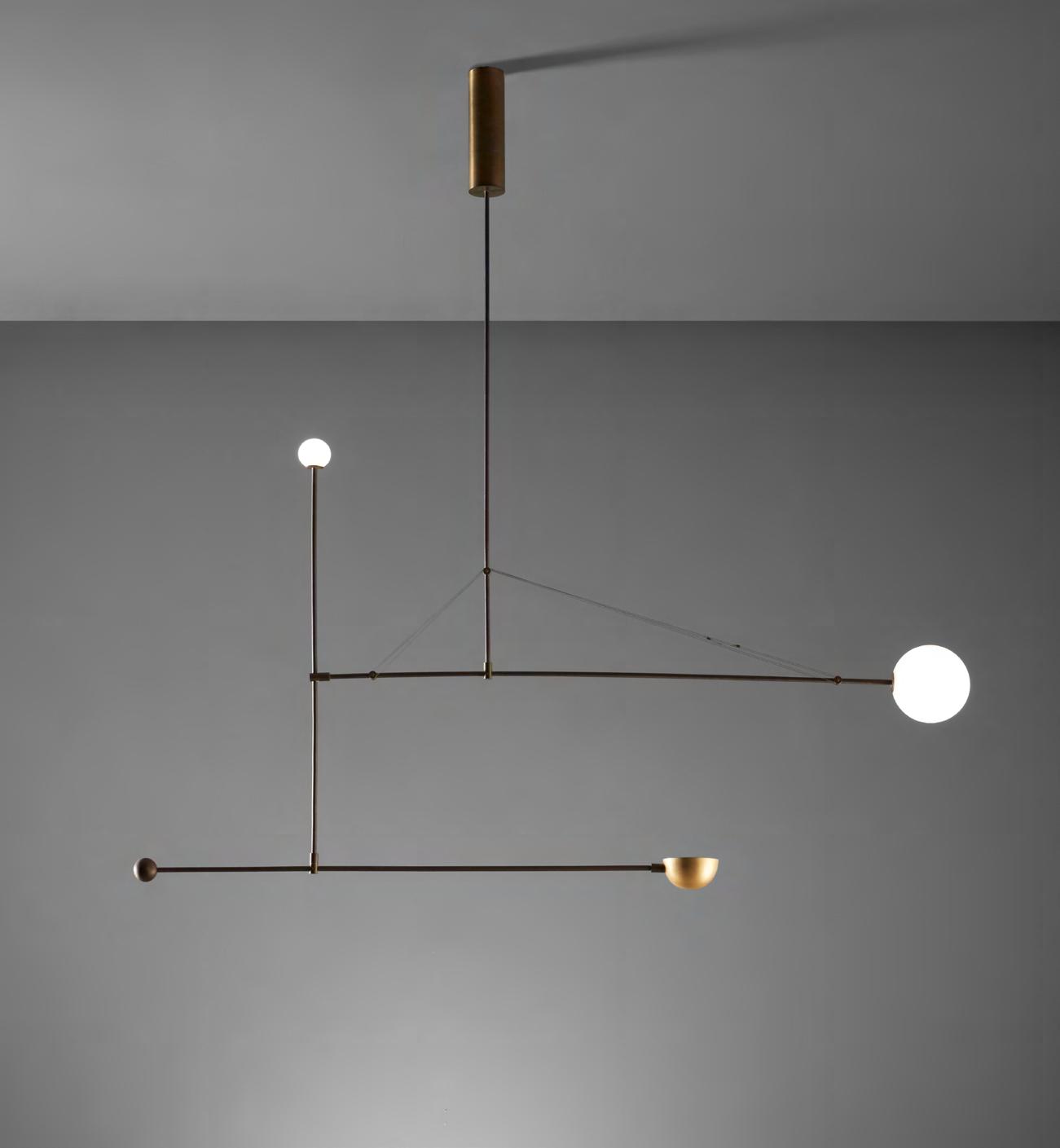
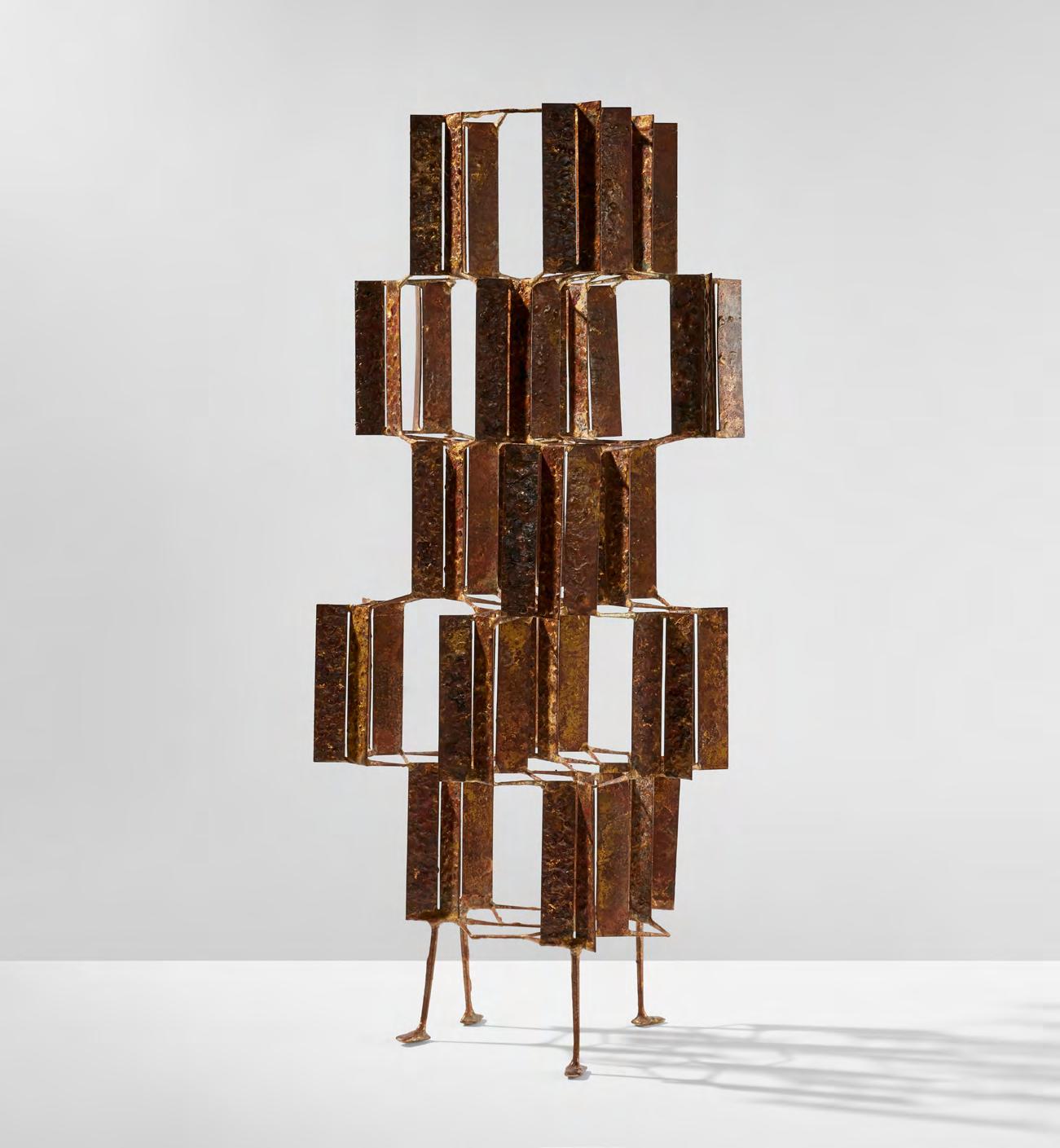
Property from a Private South American Collection
Untitled (multi-plane construction) circa 1958
Copper and brass melt-coated steel. 43 5/8 x 18 1/2 x 21 1/2 in. (110.8 x 47 x 54.6 cm) Together with a certificate of authenticity from the Harry Bertoia Foundation.
Estimate $70,000-100,000
Don Hatch Galleria, Caracas, acquired directly from the artist, 1958 Estudio Actual, Caracas Acquired from the above by the present owner, 1980s
Nancy N. Schiffer and Val O. Bertoia, The World of Bertoia, Atglen, 2003, pp. 60, 63, 65-66, 80 for similar examples
Celia Bertoia, The Life and Work of Harry Bertoia: The Man, the Artist, the Visionary, Atglen, 2015, p. 78 for a similar example
Beverly H. Twitchell, Bertoia: The Metalworker, London, 2019, pp. 152-55 for similar examples

A 1952 promotional image for Knoll International, Inc. illustrates one of Harry Bertoia’s wire chairs sitting next to a multi-plane construction similar to the present lot. The photo, taken during a period of immense production and possibility for Bertoia, captures the worlds that Bertoia simultaneously occupied at this time: the functional and the sculptural; the commercial and the artistic; the rigid and the organic. Throughout the 1950s, Bertoia gained international attention and began to create more purely sculptural and architectonic sculptures such as the present work.
In 1958, the same year that Bertoia created the present multiplane sculpture, architect Don Hatch commissioned him to create a monumental screen for the United States Embassy in Caracas, Venezuela. In the late 1940s, Hatch moved to Venezuela to preside as the Chief Architect of International Basic Economy Corporation, a company founded by Nelson Rockefeller with the mission of strengthening the nation’s economy. Such initiatives, paired with the nation’s booming oil economy as well as nationwide modernization projects, allowed the country to be a hotbed for international modern designers such as Hatch and Bertoia. The following decade was not only a fruitful one for Bertoia but also for modern design and architecture in Venezuela. (Only two years before the execution of the present lot had modernist architect Gio Ponti designed Villa Planchart, a masterpiece of modern architecture in Caracas, which interestingly included sculptures by Bertoia in its interior.)
Hatch also owned a gallery-cum-showroom in Caracas called Galeria Don Hatch which displayed a variety of craft and fine art, ranging from Scandinavian ceramics and glass to Mexican tapestries and Surrealist art. The present sculpture was sold to Don Hatch in 1958—the same year that the gallery mounted a one-man show for Bertoia—and was later acquired by the notable Caracas-based gallery Estudio Actual before being sold in the 1980s to private collectors in South America where it has remained since. The sculpture is not only a representative example of the material and sculptural explorations that Bertoia undertook at the time but it also symbolizes the cusp of Bertoia’s burgeoning career. Using a torch, Bertoia melted copper and brass onto the steel skeleton in a way that was not altogether dissimilar from contemporary Abstract Expressionist artists such as Arshile Gorky and Willem de Kooning’s use of paint on canvas.
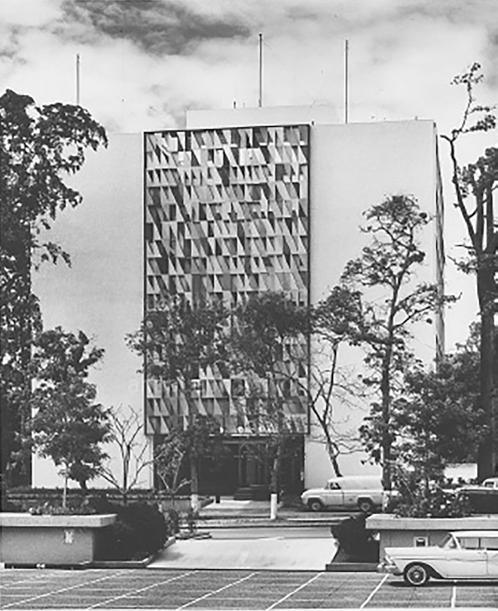 The U.S. Embassy in Caracas, designed by Don Hatch with a monumental screen on the façade designed by Harry Bertoia, 1958. Artwork © 2022 Estate of Harry Bertoia/Artists Rights Society (ARS), New York.
The U.S. Embassy in Caracas, designed by Don Hatch with a monumental screen on the façade designed by Harry Bertoia, 1958. Artwork © 2022 Estate of Harry Bertoia/Artists Rights Society (ARS), New York.
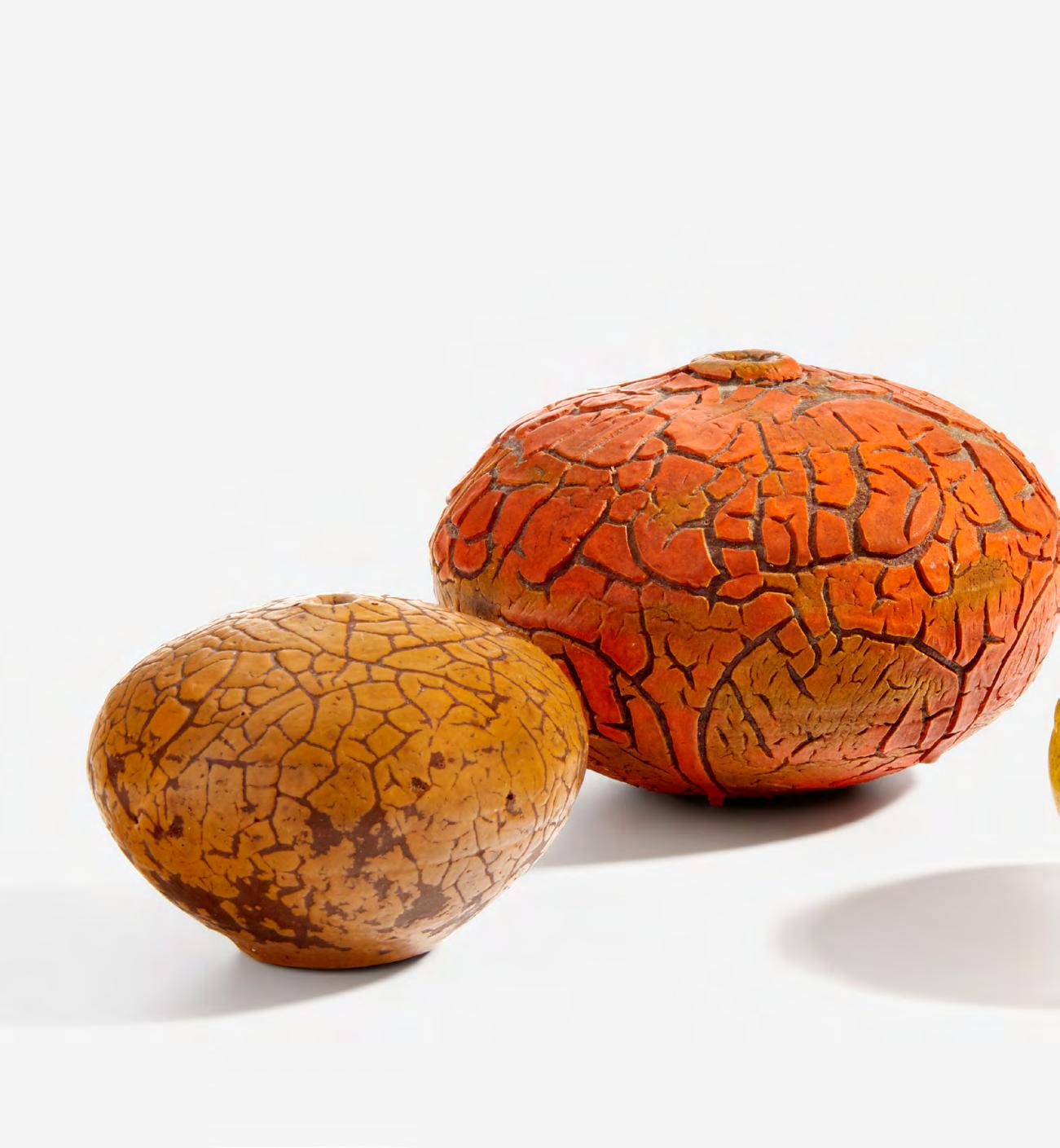
Property from a Private Collection, California
Weed pot
circa 1970
Glazed earthenware.
1 3/4 in. (4.4 cm) high Underside incised LANE
Estimate $3,000-5,000
Provenance
Private collection, California Acquired from the above, 2019
Literature
Ricky Swallow and Gerard O’Brien, Doyle Lane, Los Angeles, 2014, p. 6 for similar examples
Property from a Private Collection, California
Weed pot
circa 1970
Glazed earthenware.
1 3/4 in. (4.4 cm) high Underside incised LANE
Estimate $3,000-5,000
Provenance
Reform Gallery, Los Angeles Acquired from the above by the present owner, 2016
Literature
Ricky Swallow and Gerard O’Brien, Doyle Lane, Los Angeles, 2014, p. 6 for similar examples
54.
Property from a Private Collection, California
Weed pot
circa 1970
Glazed earthenware.
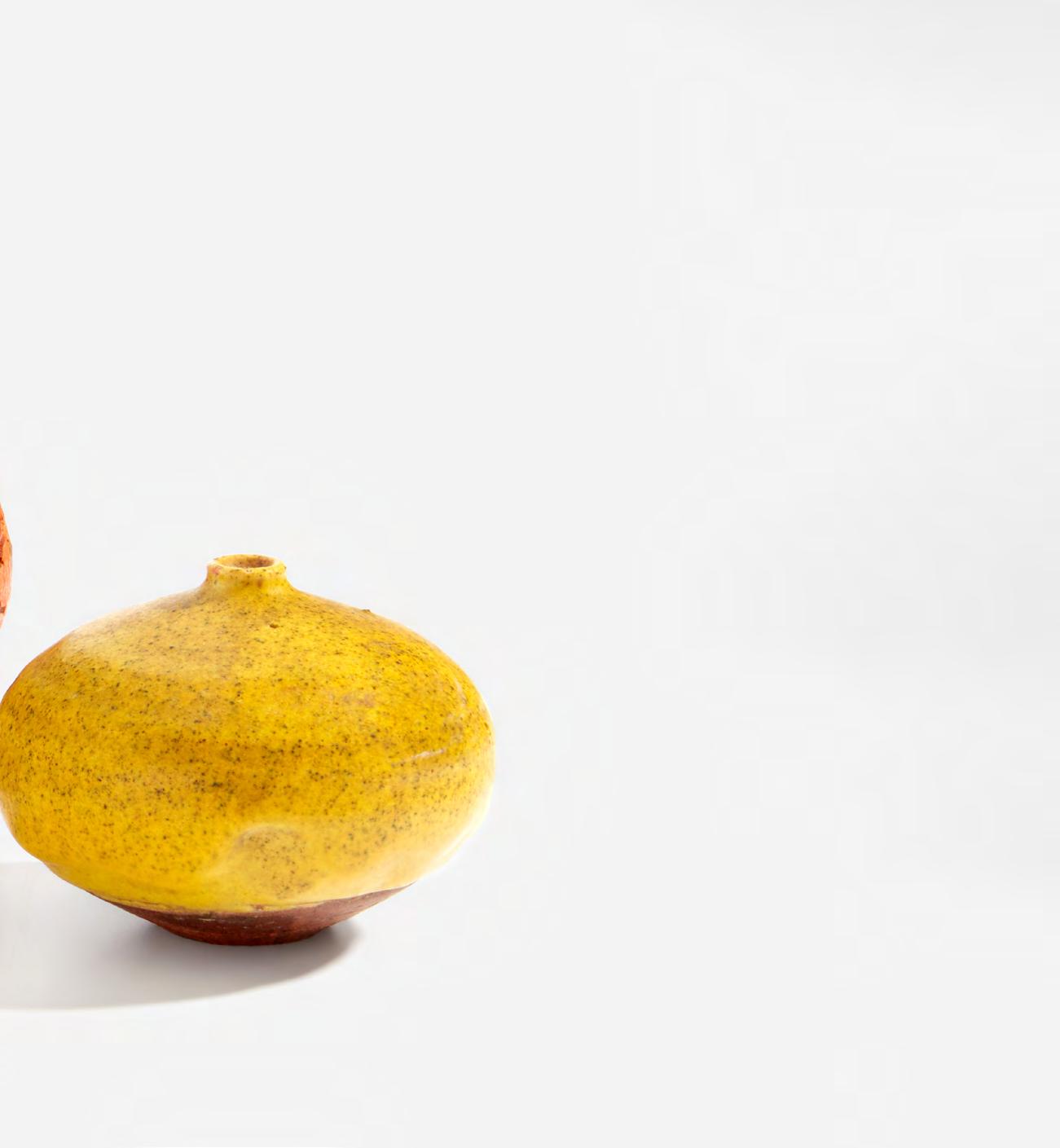
2 1/2 in. (6.4 cm) high Underside incised LANE
Estimate $5,000-7,000
Provenance
Private collection, California Acquired from the above, 2019
Literature
Ricky Swallow and Gerard O’Brien, Doyle Lane, Los Angeles, 2014, p. 6 for similar examples
1905-1976
“Mesa” coffee table, model no. 1760-6 designed 1952, produced 1953 Walnut-veneered wood. 16 x 73 1/2 x 50 in. (40.6 x 186.7 x 127 cm) Produced by Widdicomb Furniture Company, Grand Rapids, Michigan. Underside with manufacturer’s paper label printed WIDDICOMB/designed by/T.H. ROBSJOHN-GIBBINGS and ink stamped 2 / 53/1760-6
Estimate $200,000-300,000
Wright, Chicago, “Important Design,” June 8, 2010, lot 739
Acquired from the above by the present owner
Literature House Beautiful, May 1952, cover, pp. 145, 147
“L’Art Décoratif Américain et les Appels du Mexique, Robsjohn Gibbings,” Art et Industrie, June 1953, p. 25
Widdicomb, manufacturer’s catalog, Grand Rapids, 1954, n.p. Brooke Kamin Rapaport and Kevin Stayton, Vital Forms: American Art and Design in the Atomic Age, 1940-1960, New York, 2001, p. 31
John Stuart Gordon, A Modern World: American Design from the Yale University Art Gallery, 1920-1950, New Haven, 2011, p. 375
Property from a Distinguished Collection, Chicago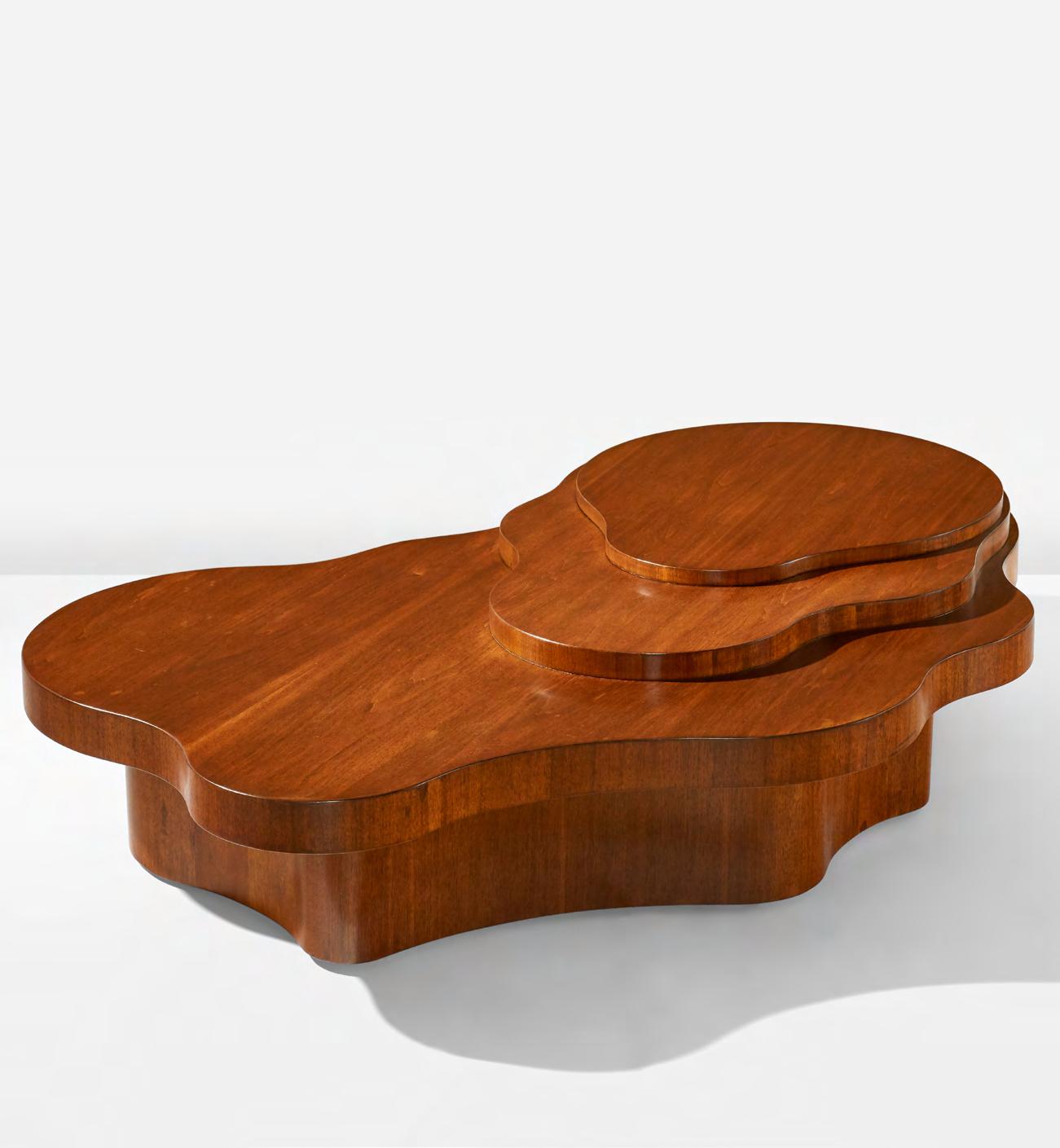
 by Luke Baker
T.H. Robsjohn-Gibbings
by Luke Baker
T.H. Robsjohn-Gibbings
The designer, decorator, and critic Terrence Harold RobsjohnGibbings arrived in the United States from England around 1930 to sell European antiques to wealthy Americans as the head of Charles of London’s New York flagship store. However, he would soon find himself soured on the fussy historic imports, brought in by the boatload from dusty dynastic estates across the Atlantic and acquired by a clientele eager to adopt the next trendy revival, from Tudor to tous les Louis
What began as an aversion to antiques would become RobsjohnGibbings’ reformist campaign to develop a true American design idiom for the postwar era, a mission he pursued for the next 30 years through his prolific writings and popular furniture collections for mass manufacturers. Nowhere is this impulse to create a timeless American style more apparent (or successful) than in the spectacular Mesa table from 1952, the most significant and rare of RobsjohnGibbings’ designs.
“America has wasted time, money and effort for the last fifty years wistfully recalling the architecture and furniture of Europe,” RobsjohnGibbings tartly opined in Goodbye Mr. Chippendale, a 1944 treatise against the devotion to antiques. But contemporary manifestations of European modernism offered no appealing alternative to such ‘brown furniture,’ either. In Homes of the Brave from 1954, he disdained the “spidery metallic seating,” and austere interiors that seemed to prize a progressivist ideology over the comfort of the human bodies that would dare to inhabit them.
Rather, Robsjohn-Gibbings saw the end of wartime austerity as an auspicious moment resurrect the country’s design and manufacturing industries by defining a new domestic aesthetic—one shaped not by past styles or prescriptive philosophies, but how people actually wanted to live. “In the post-war years that lie ahead, America will be called upon to rehouse and provide furniture for millions of its people,” he wrote in 1944. “So let’s think over the depressing saga that made us into antique collectors and …examine our own good architecture and the possibilities for good contemporary American furniture.”
Robsjohn-Gibbings did just that, shuttering his successful high-end furniture and decorating business to become the creative director of Grand Rapids-based manufacturer Widdicomb Furniture Company in the early 1940s. For the next decade, he focused on producing collections of well-designed objects intended for middle-class Americans—furniture that celebrated the American values our GIs had fought to defend: democracy, perpetual self-invention, and the freedom to live however we damn well please.
Even among Robsjohn-Gibbings’ 1952 collection for Widdicomb, the Mesa table marks a departure from the norm with its strikingly sculptural form and scale. Many of his furniture designs drew upon the proportions and ancient forms of Antiquity, but Mesa’s novel organic shape was said by the designer to be inspired by the distinctive landforms of the American Southwest, as seen from above. Combined with the topographic effect of its graduated stacked slabs, Mesa is less a table than a geological formation domesticated for the living room. True to Robsjohn-Gibbings’ trademark subtlety, its surface is smooth and unembellished, deliberately free of reference to style or era, with the figure of its native American walnut veneer as its only decoration. As if to further dismiss any association with its predecessors, the table’s stepped horizontal surface sits on a broad and asymmetrical pedestal foot, foregoing the four slender legs of its platonic archetype.
Shortly after its debut, the Mesa table was featured on the front of House Beautiful magazine, the exemplification of the cover story on “The luxury of informality.” In the ensuing spreads, audiences
were introduced to numerous Southwest-inflected interior settings Robsjohn-Gibbings designed for the Widdicomb showroom and appointed with a range of pieces from his most recent collection for the company. Each embodied his conception for a new mode of domesticity that eschewed the stuffiness of tradition and embraced casual comfort, ease, and flexibility. As the centerpiece of the living room, the Mesa table was styled to display the stuff of life—albeit an aspirational one—from pre-Columbian vessels (a nod to indigenous North American aesthetics), to perfume bottles and abstract objets d’art. “We are discovering the simple but forgotten fact that people are most themselves and most interesting when they are comfortable,” the article’s author observed. The Mesa table’s convenience and versatility were key to the American approach to leisure and entertaining. It was a piece designed for serving highballs, poured promptly at five; for displaying full-color magazines, from LIFE to Art and Architecture; for conversationalists to gather around, smoking in low-slung chairs; for after-dinner knitting projects or trays of finger sandwiches.
Monumental in scale, assertively horizontal, and exuding a rich and natural warmth, the Mesa table is borne of Robsjohn-Gibbings’ humanist ideal for the post-war American home. This wasn’t an object designed for the taught and formal boxes of the Victorian, or the equally constraining and severe ‘machines for living’ espoused by the early 20th century modernists. “Contemporary houses are the natural development of architecture to meet the changing forms in our social habits and customs,” he noted in Goodbye Mr. Chippendale. As such, Mesa was conceived for a home that invited relaxation and leisure with sweeping, open living spaces. Our houses should be “projections of human personalities and universal human needs, rather than essays in architectural style or theory,” Robsjohn-Gibbings asserted in Homes of the Brave. He went on to praise the “familiarity and architectural unpretentiousness” of the new ranch house typology, that uniquely American vernacular that dominated new home construction after the war, but which traces its lineage to the organic architecture of Frank Lloyd Wright, a designer whom Robsjohn-Gibbings found deeply influential.
The Mesa table is Robsjohn-Gibbings’ crowning achievement in his ambition to develop a design vocabulary authentic to the culture, landscapes, and distinctly individual spirit of his adopted homeland. “The new house and their interiors are the new way of life of a new generation,” he pronounced in 1944. By shaking free the yokes of stylistic pedigree, Mesa was molded instead by the enduring values of comfort, nature, and craftsmanship, boldly signaling a new era with an appropriately timeless form.
Property of a GentlemanPlate 1973
Glazed stoneware with porcelain passthroughs.
18 1/2 in. (47 cm) diameter Reverse painted in glaze VOULKOS 73

Estimate $5,000-7,000
Private collection, California, acquired directly from the artist
Thence by descent
Acquired from the above by the present owner
Literature
Rose Slivka, “The New Clay Drawings of Peter Voulkos,” Crafts Horizons, October 1974, back cover for a similar example
Rose Slivka, Peter Voulkos: A Dialogue With Clay, New York, 1978, pp. 97, 116, 118 for similar examples
Vase
circa 1957
Glazed stoneware. 11 1/2 in. (29.2 cm) high Underside painted in glaze VOULKOS
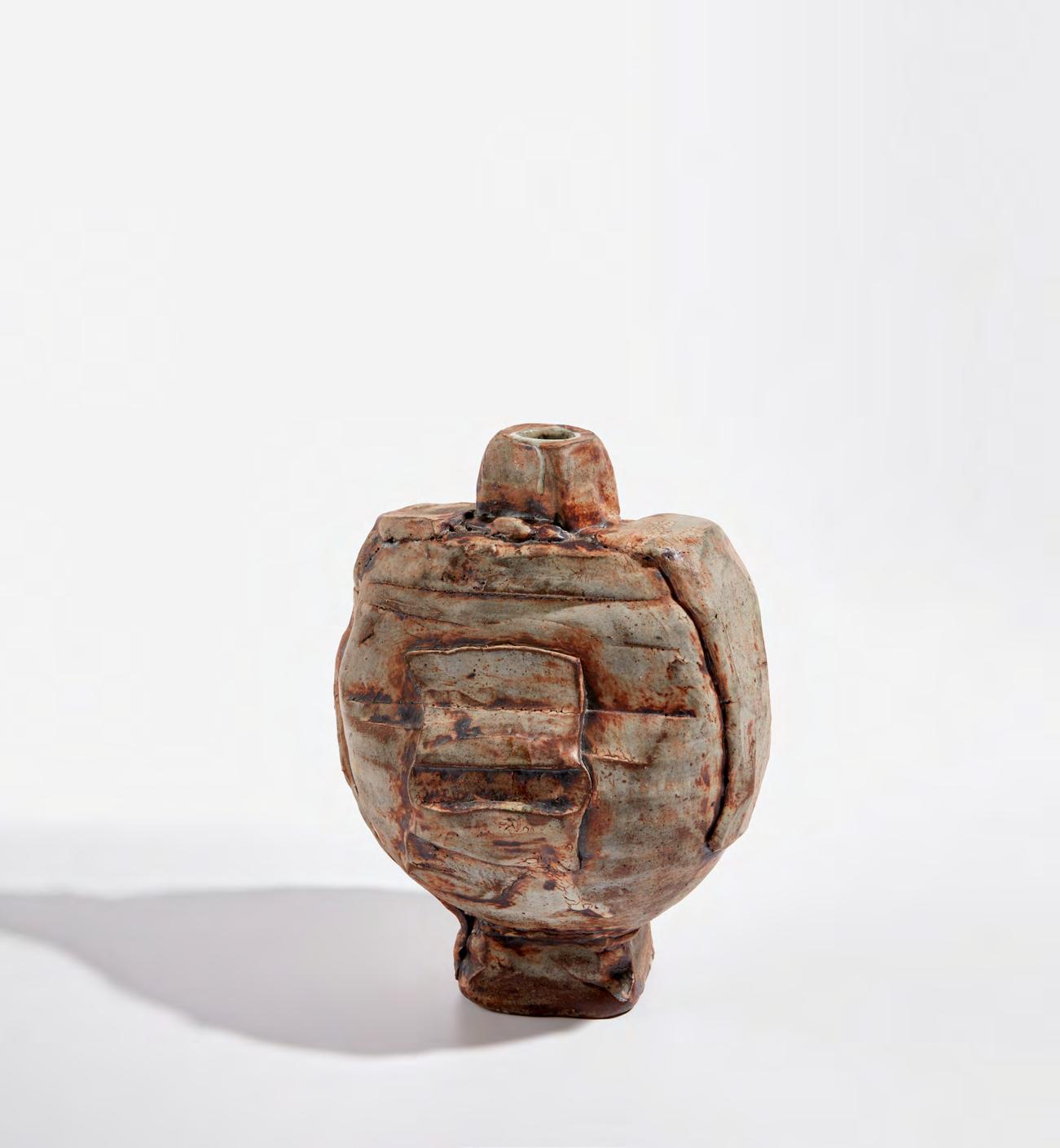
Estimate
$12,000-18,000
Private collection, California Acquired from the above by the present owner
“Peter Voulkos: Echoes of the Japanese Aesthetic,” American Museum of Ceramic Art, Pomona, California, November 12, 2005-February 4, 2006
Peter Frank, Image to Gesture, 1945-1969: California Postwar Abstraction, New York, 2013, illustrated n.p.
“Closed
1990s
Glazed porcelain. 6 7/8 in. (17.5 cm) high Estimate $4,000-6,000
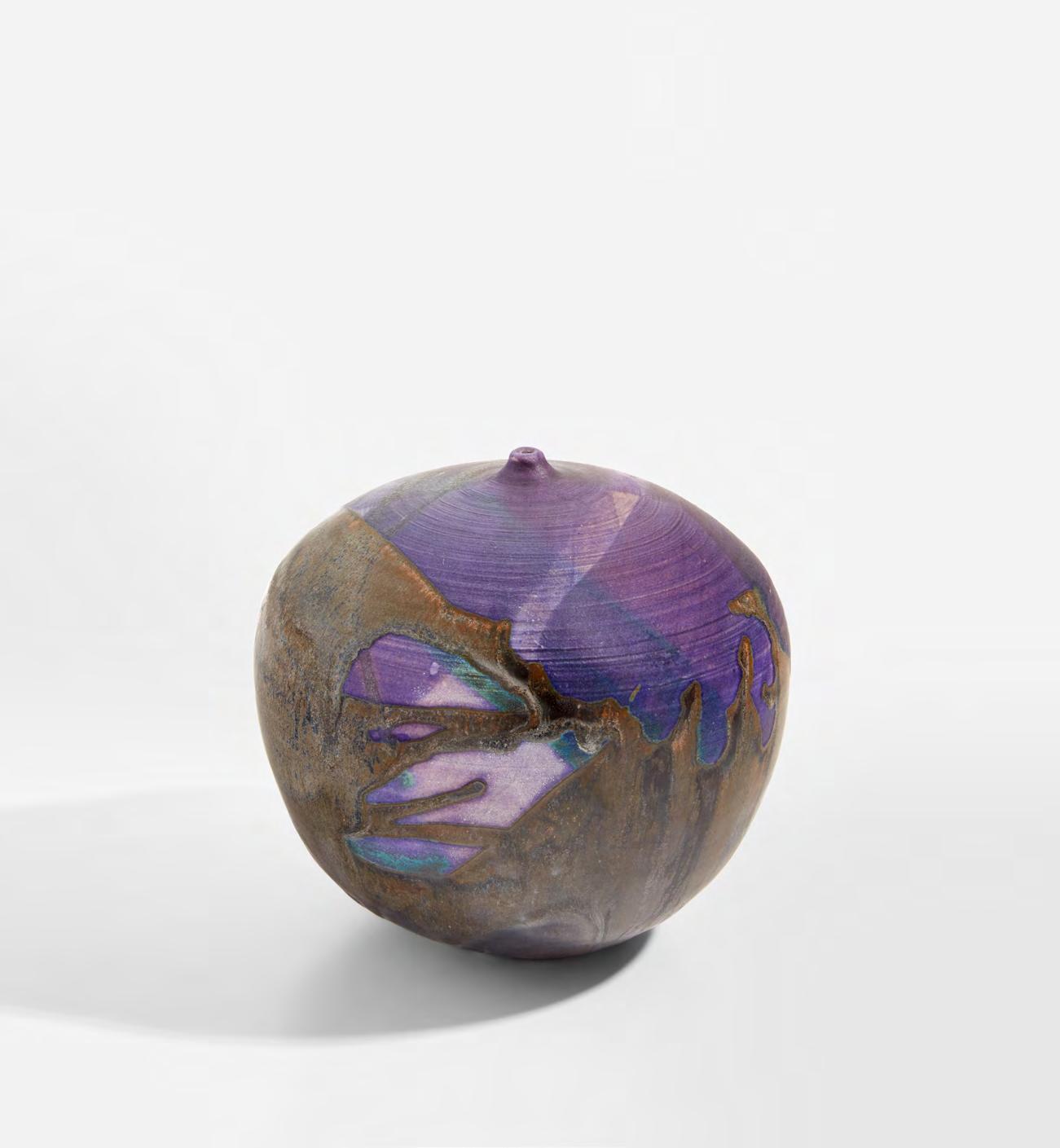
Acquired directly from the artist by the present owner, 1990s
J. Stanley Yake, Toshiko Takaezu: The Earth in Bloom, New York, 2005, p. 22 for a similar example
Property from a Private Collection, PhiladelphiaProperty from a Private Collection, Philadelphia
“Closed Form” 1990s
Glazed porcelain. 5 3/4 in. (14.6 cm) high Underside incised with artist’s mark.
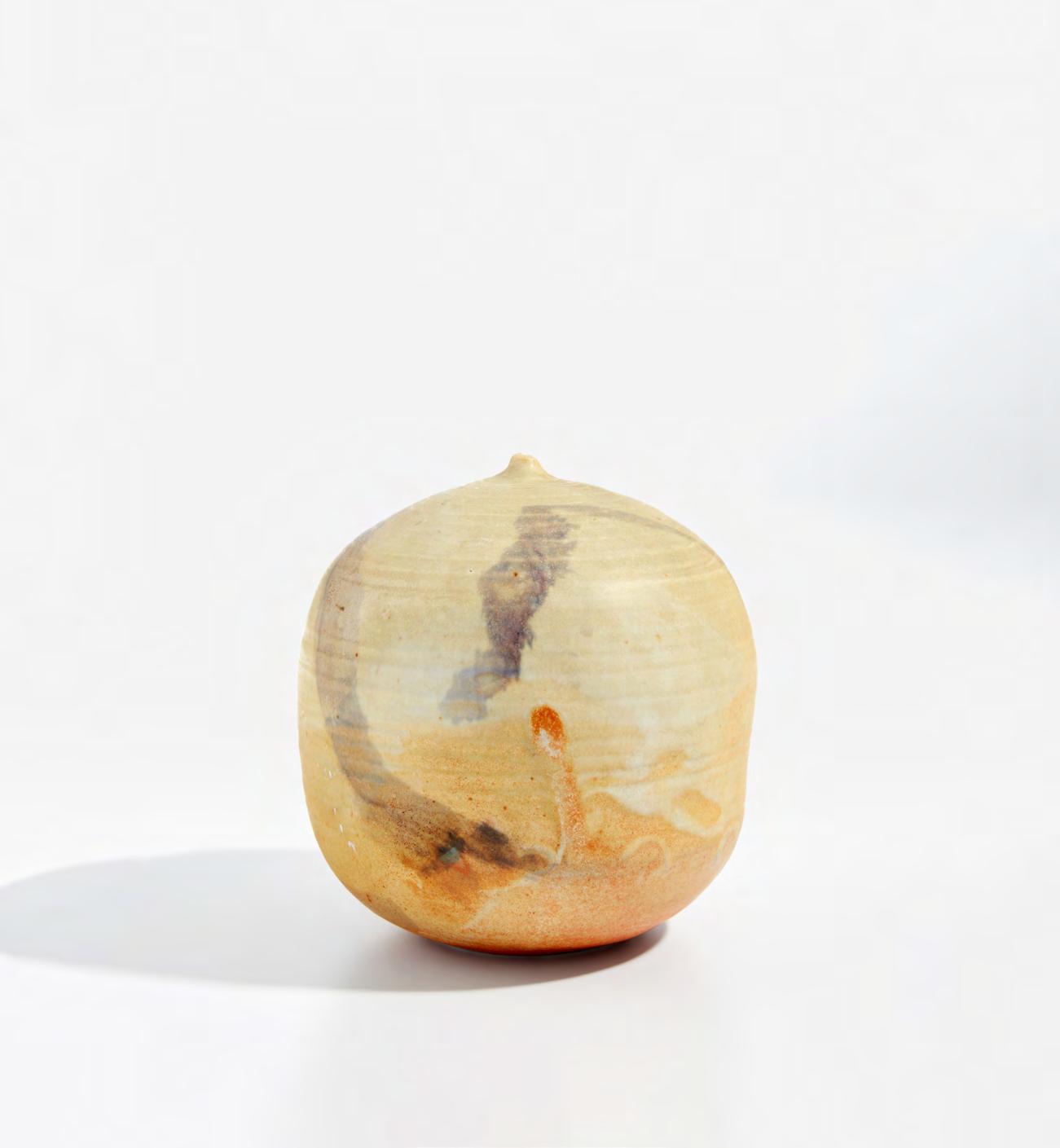
Estimate $2,500-3,500
Acquired directly from the artist by the present owner, 1990s
Felice Fischer, Kathleen A. Foster, and Darrel Sewell, The Poetry of Clay: The Art of Toshiko Takaezu, Philadelphia, 2005, p. 13 for a similar example
J. Stanley Yake, Toshiko Takaezu: The Earth in Bloom, New York, 2005, p. 133 for a similar example
“Closed
1980s
Glazed porcelain. 7 in. (17.8 cm) high Underside incised with artist’s mark.

Estimate $3,000-5,000
Acquired directly from the artist by the present owner, 1980s
J. Stanley Yake, Toshiko Takaezu: The Earth in Bloom, New York, 2005, pp. 13237 for similar examples
Property from a Private Collection, PhiladelphiaProperty from a Private Collection, Philadelphia
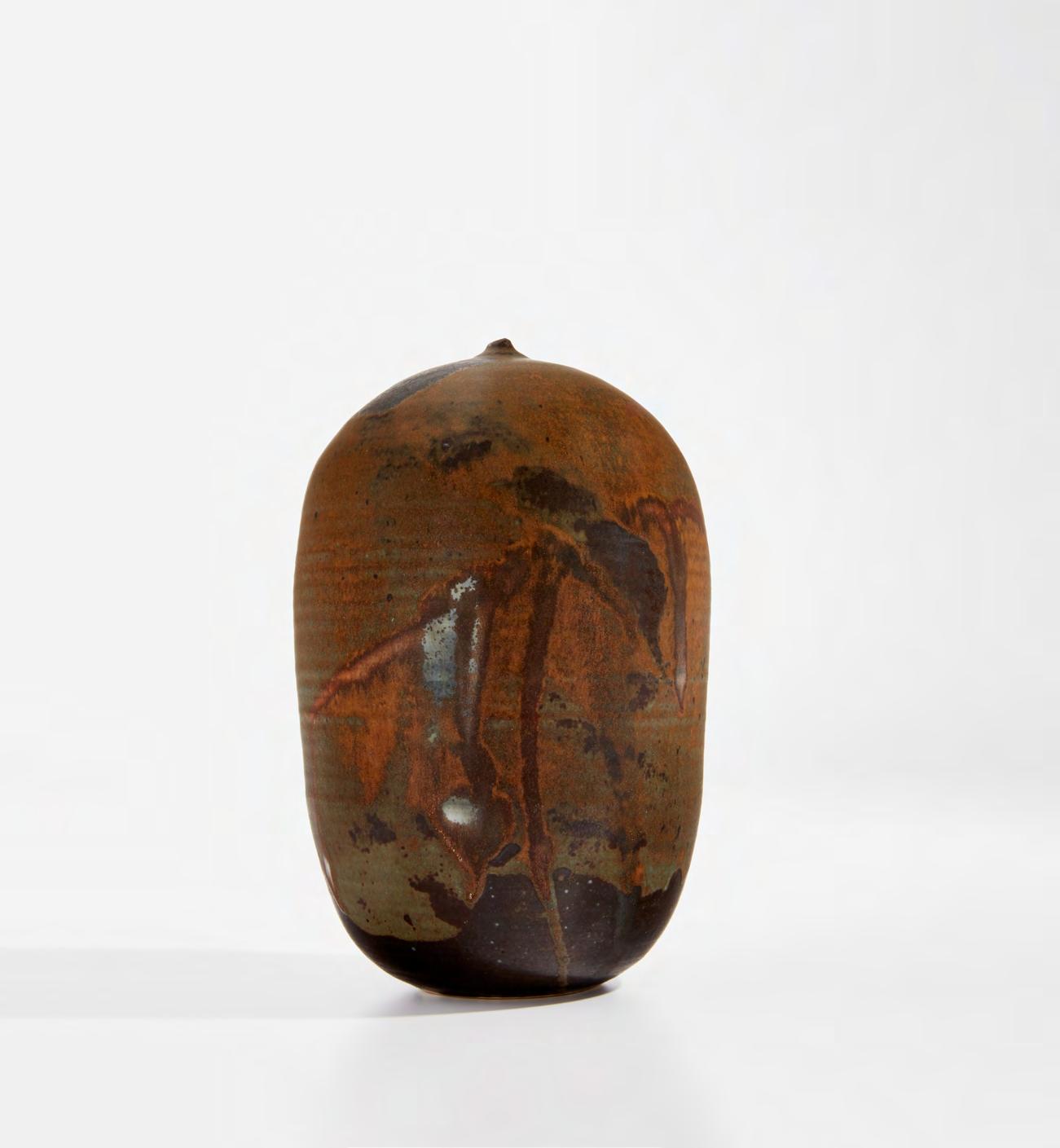
Glazed porcelain. 8 5/8 in. (21.9 cm) high Underside incised with artist’s mark.
Estimate $3,000-5,000
Provenance
Acquired directly from the artist by the present owner, 1990s
Literature
J. Stanley Yake, Toshiko Takaezu: The Earth in Bloom, New York, 2005, p. 137 for a similar example
1990s
Glazed porcelain. 14 1/4 in. (36.2 cm) high Underside incised with artist’s mark.
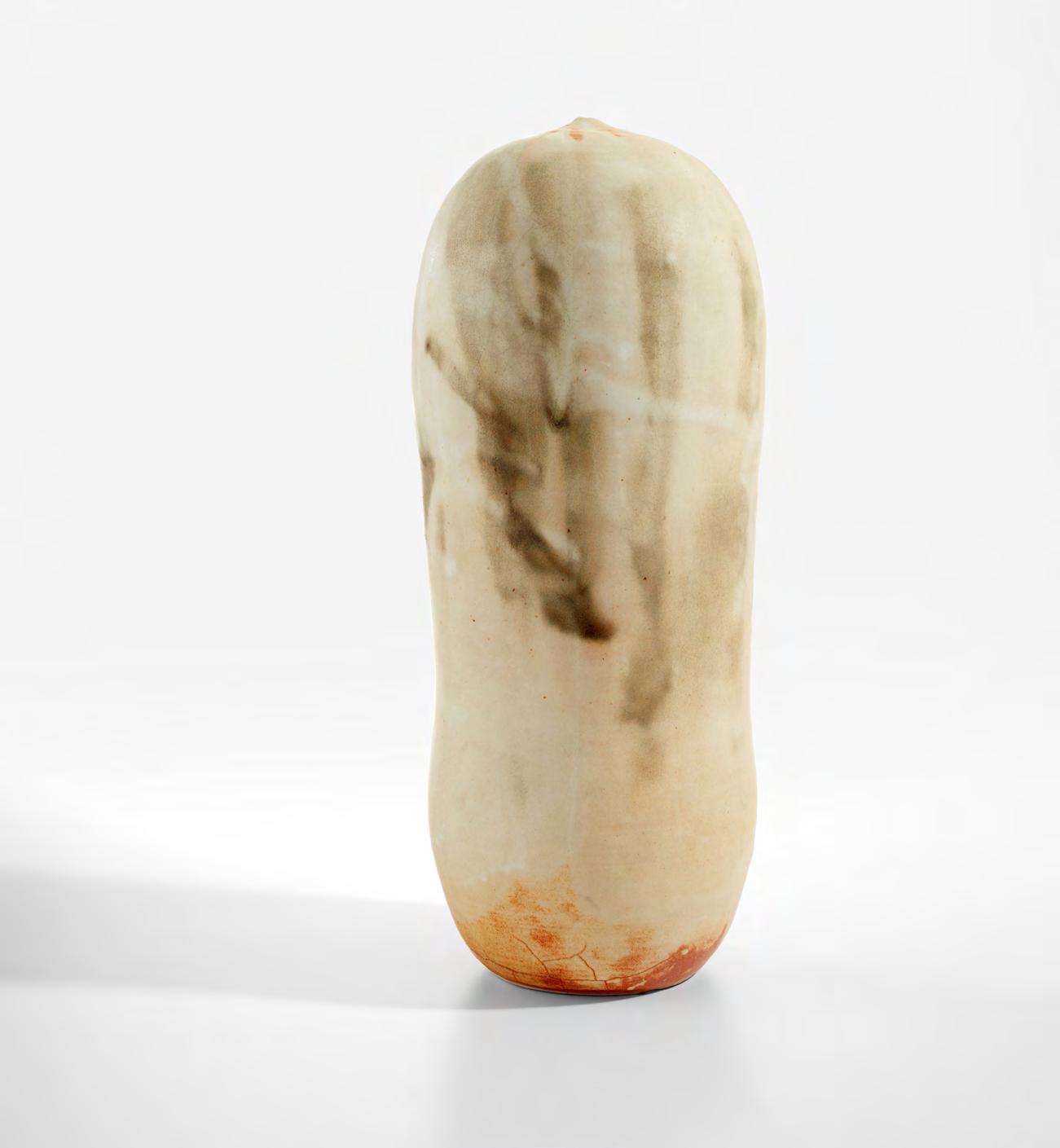
Estimate $6,000-8,000
Provenance
Acquired directly from the artist by the present owner, 1990s
Felice Fischer, Kathleen A. Foster, and Darrel Sewell, The Poetry of Clay: The Art of Toshiko Takaezu, Philadelphia, 2005, p. 20 for a similar example
Property from a Private Collection, PhiladelphiaProperty from a Private Collection, Philadelphia
“Closed Form” with rattle 1990s
Glazed salt fired stoneware. 8 in. (20.3 cm) high Underside incised with artist’s mark.

Estimate $3,000-5,000
Acquired directly from the artist by the present owner, 1990s
J. Stanley Yake, Toshiko Takaezu: The Earth in Bloom, New York, 2005, pp. 13237 for similar examples
Set of three “Amoeba” nesting tables
1962
Oak burl, oak.
Largest: 21 x 21 1/4 x 21 in. (53.3 x 54 x 53.3 cm)
Executed by George Nakashima Woodworker, New Hope, Pennsylvania. Underside of each inscribed in marker BERCK. Together with a copy of the original order card.
Estimate $12,000-18,000
Sylvia and Leo Berck, Roslyn, New York, acquired directly from Nakashima Studio, 1962
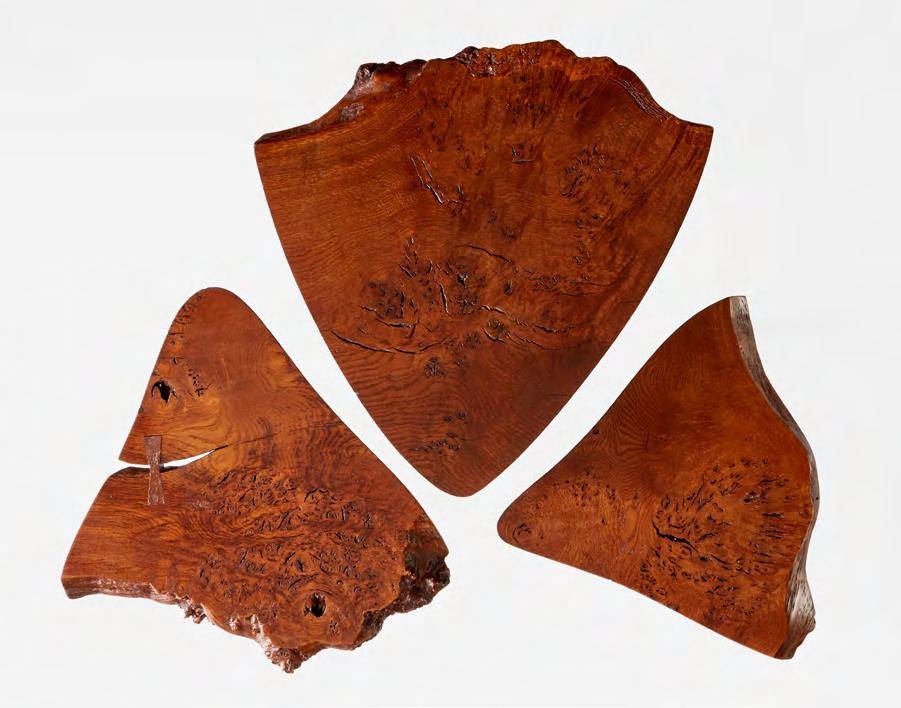
Thence by descent to the present owners
Derek E. Ostergard, George Nakashima: Full Circle, exh. cat., American Craft Museum, New York, 1989, p. 120 for a similar example
Mira Nakashima, Nature, Form & Spirit: The Life and Legacy of George Nakashima, New York, 2003, p. 93 for a similar example
Property from a Long Island Estate



1961
Laurel, pandanus cloth.
36 x 126 x 22 3/4 in. (91.4 x 320 x 57.8 cm)
Executed by George Nakashima Woodworker, New Hope, Pennsylvania. Together with a copy of the original order card.
Estimate $40,000-60,000
Sylvia and Leo Berck, Roslyn, New York, acquired directly from Nakashima Studio, 1961
Thence by descent to the present owners
George Nakashima, The Soul of a Tree, A Woodworker’s Reflections, Tokyo, 1981, pp. 39, 170-72 for similar examples
Derek E. Ostergard, George Nakashima: Full Circle, exh. cat., American Craft Museum, New York, 1989, p. 166 for a similar example
Mira Nakashima, Nature, Form & Spirit: The Life and Legacy of George Nakashima, New York, 2003, p. 181 for a similar example
Property from a Long Island Estate“Slab” coffee table 1962
Oak burl, oak.
13 1/8 x 50 x 27 1/2 in. (33.3 x 127 x 69.9 cm) Executed by George Nakashima Woodworker, New Hope, Pennsylvania. Underside inscribed in marker BERCK. Together with a copy of the original order card.
Estimate $20,000-30,000
Sylvia and Leo Berck, Roslyn, New York, acquired directly from Nakashima Studio, 1962
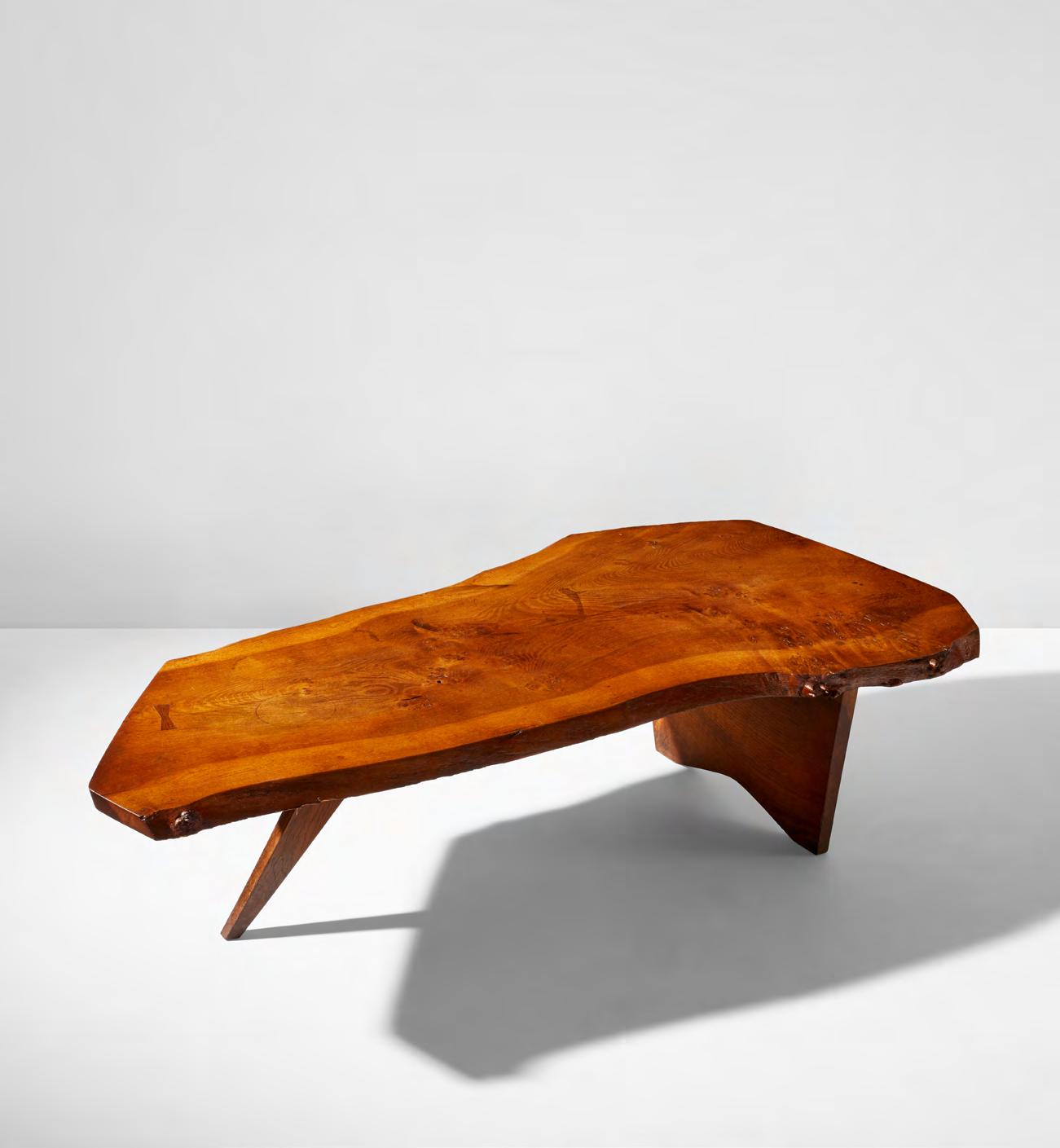
Thence by descent to the present owners
George Nakashima, The Soul of a Tree, A Woodworker’s Reflections, Tokyo, 1981, p. 188 for a drawing of a similar example Mira Nakashima, Nature, Form & Spirit: The Life and Legacy of George Nakashima, New York, 2003, pp. 83, 106, 151 for similar examples
Wall light, designed for the Hotel Parco dei Principi, Rome circa 1963 Copper-plated metal. 19 3/8 x 33 1/4 x 5 1/2 in. (49.2 x 84.5 x 14 cm) Manufactured by Candle, Milan, Italy. Together with a certificate of expertise from the Gio Ponti Archives. Estimate $8,000-12,000

“Cushion” chair and ottoman 1954
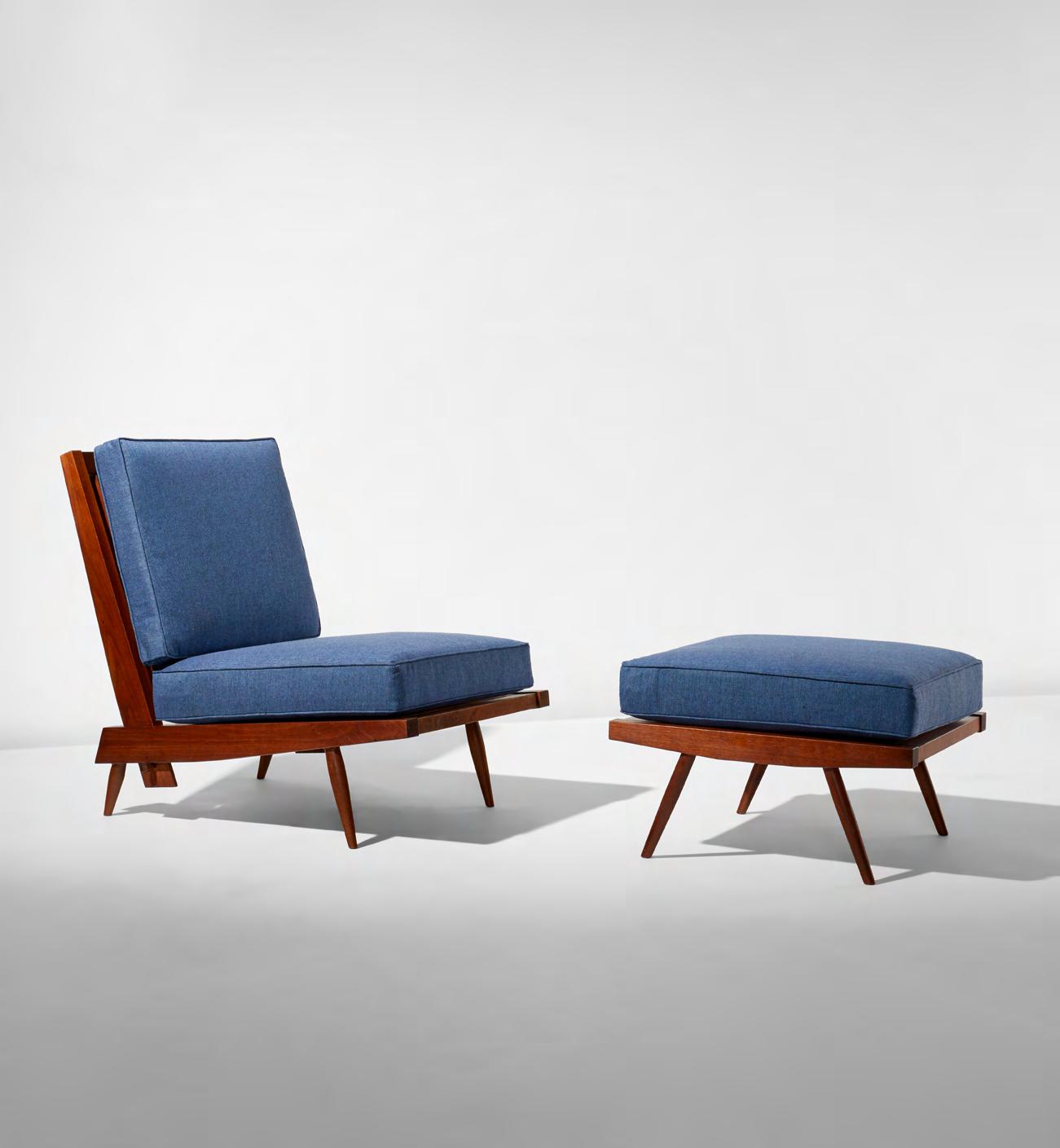
Walnut, fabric upholstery.
Chair: 30 1/2 x 24 x 30 5/8 in. (77.5 x 61 x 77.8 cm)
Ottoman: 10 1/2 x 24 1/4 x 24 in. (26.7 x 61.6 x 61 cm)
Executed by George Nakashima Woodworker, New Hope, Pennsylvania. Together with a copy of the original invoice.
Private collection, Pennsylvania, acquired directly from Nakashima Studio, 1954 Thence by descent to the present owner
Derek E. Ostergard, George Nakashima: Full Circle, exh. cat., American Craft Museum, New York, 1989, pp. 49, 53, 158 for similar examples
Mira Nakashima, Nature, Form & Spirit: The Life and Legacy of George Nakashima, New York, 2003, cover, p. 82 for similar examples
Pair of mirrors, model no. 2359
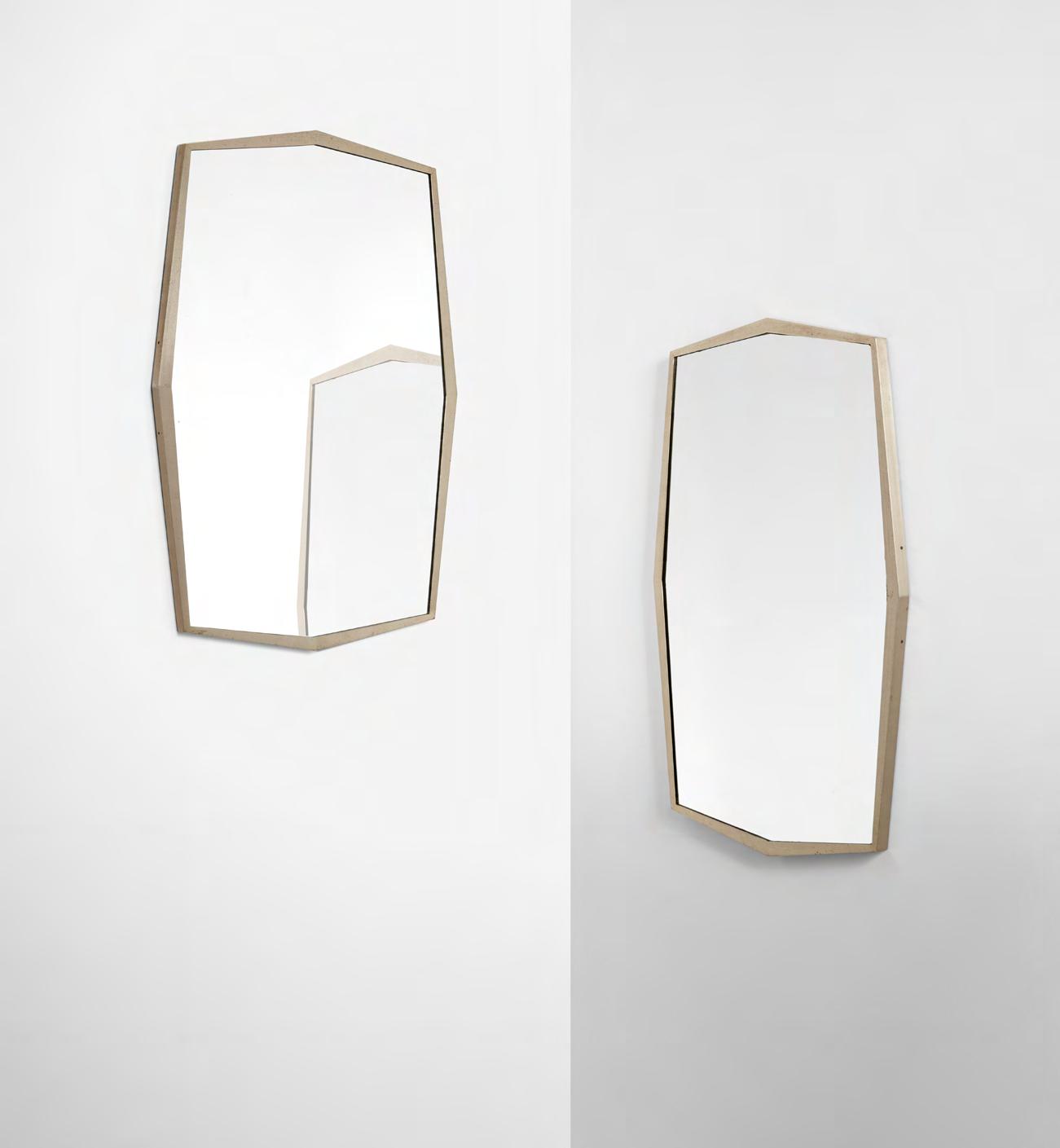
circa 1965
Nickel-plated metal, mirrored glass. Each: 35 1/2 x 23 5/8 x 1 in. (90.2 x 60 x 2.5 cm)
Manufactured by Fontana Arte, Milan, Italy.
Estimate $7,000-9,000
Provenance Private collection, Milan
Literature
Fontana Arte: Bagno, sales catalogue, Milan, 1965, p. 21
Domus, no. 433, December 1965, n.p. for an advertisement
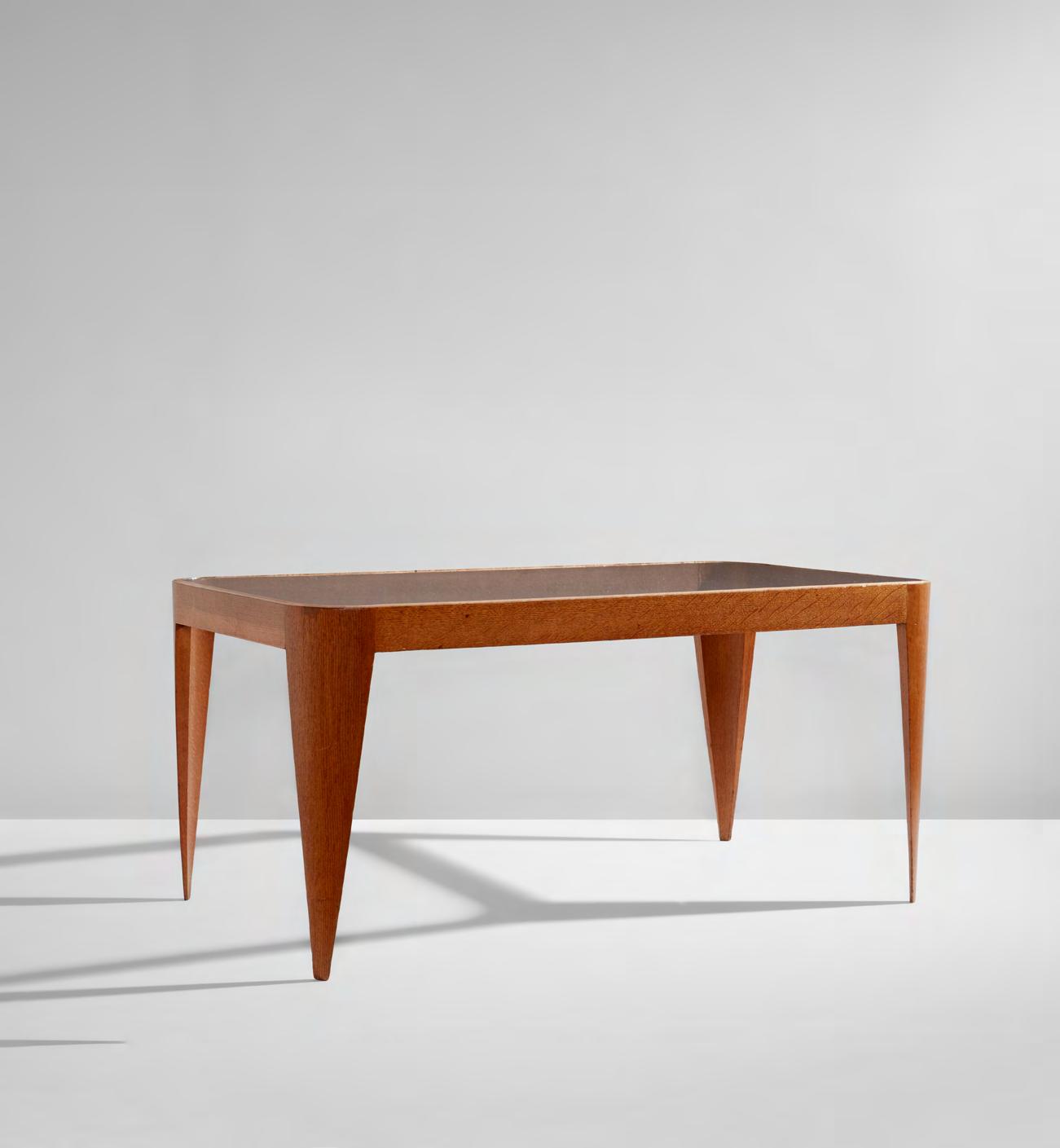
Coffee table circa 1937 Oak, glass.
17 3/8 x 37 3/8 x 21 5/8 in. (44.1 x 94.9 x 54.9 cm)
Produced by Casa e Giardino, Milan, Italy. Together with a certificate of expertise from the Gio Ponti Archives.
Estimate $3,000-5,000
Phillips, New York, “Saturday @ Phillips,” April 25, 2009, lot 74
Acquired from the above by the present owner
“La canapa tessuto per arredamento,” Domus, no. 113, May 1937, p. 51
Floor lamp, model no. 12829 circa 1960
Painted metal, brass, glass, black marble. 74 in. (188 cm) high Manufactured by Arredoluce, Monza, Italy.
Estimate $6,000-8,000
Provenance Private collection, Milan
Alessandro Padoan, Alessandro Palmaghini and Anty Pansera, Arredoluce: Catalogo Ragionato 1943-1987, Milan, 2018, pp. 224, 334
The present lot has been registered in the Arredoluce Archives, Italy as number 2988578.


“Chieftain” chair, model no. FJ 49 A designed 1949, executed 1960s Teak, original leather upholstery. 36 3/4 x 40 x 29 1/2 in. (93.3 x 101.6 x 74.9 cm) Executed by master cabinetmaker Niels Vodder, Copenhagen, Denmark. Underside impressed NIELS VODDER CABINETMAKER/COPENHAGEN DENMARK/DESIGN: FINN JUHL and with retailer’s paper label.
Estimate $30,000-50,000
Georg Jensen, New York
Sylvia and Leo Berck, Roslyn, New York, circa 1960
Thence by descent to the present owners
Viggo Sten Møller and Svend Erik Møller, Dansk Møbelkunst: Københavns Snedkerlaugs Møbeludstilling, 1927-1951, Copenhagen, 1951, p. 82
Esbjørn Hiort, Modern Danish Furniture, New York, 1956, pp. 54-55
Grete Jalk, ed., Dansk Møbelkunst gennem 40 aar, Volume 3: 1947-1956, Copenhagen, 1987, pp. 124-25, 233, 311
Esbjørn Hiort, Finn Juhl: Furniture, Architecture, Applied Art, Copenhagen, 1990, front cover, pp. 23, 40-41
Noritsugu Oda, Danish Chairs, San Francisco, 1999, pp. 92-93
Pair of wall lights, model no. 1568 circa 1956
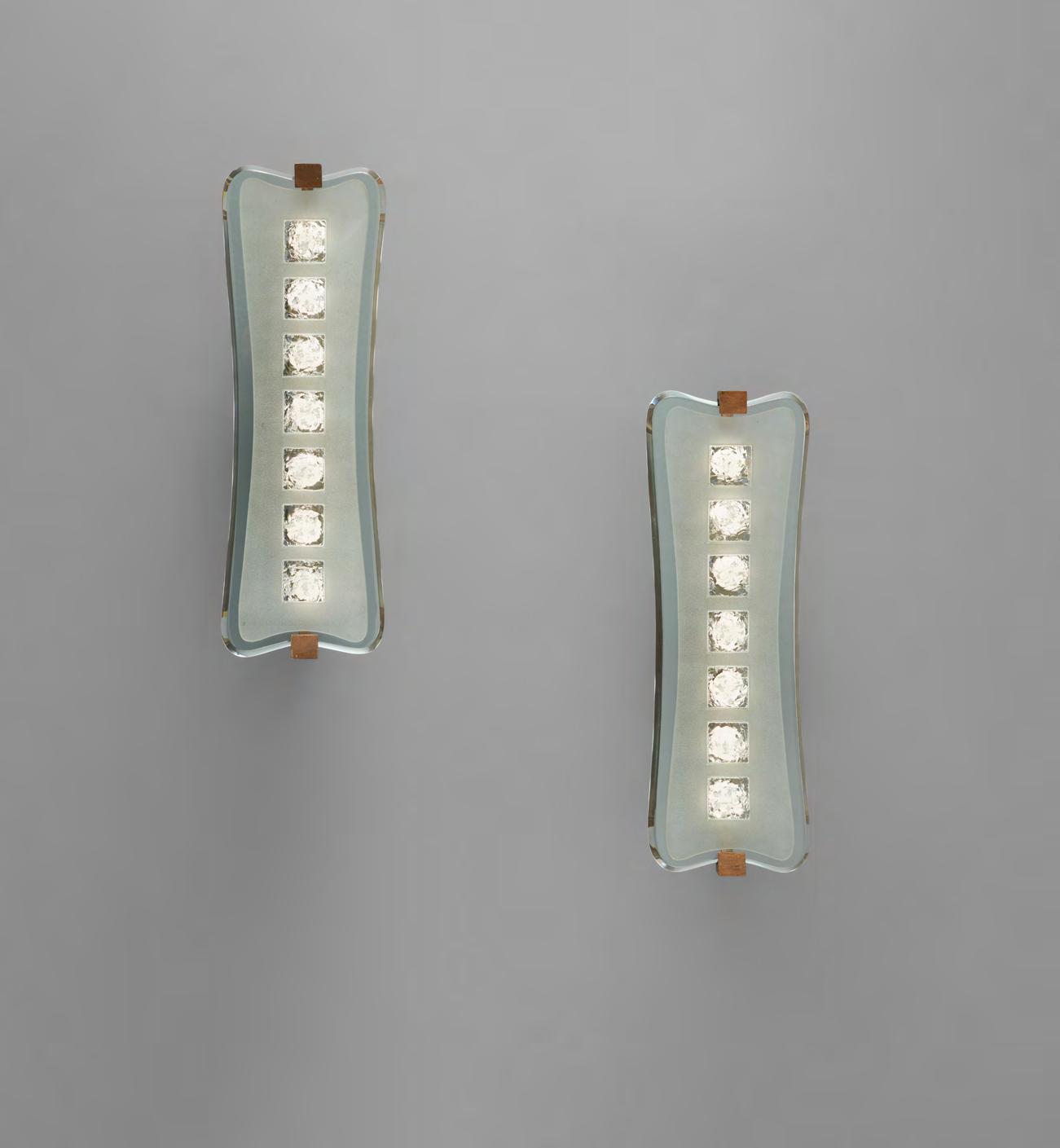
Glass, brass, nickel-plated brass. Each: 24 1/4 x 8 1/4 x 7 1/4 in. (61.6 x 21 x 18.4 cm)
Manufactured by Fontana Arte, Milan, Italy.
Estimate $8,000-12,000
Private collection, Milan
Fontana Arte: Illuminazione, sales catalogue, Italy, 1960s, p. 55
Pierre-Emmanuel Martin-Vivier, Max Ingrand: Du Verre à la Lumière, Paris, 2009, p. 188
Franco Deboni, Fontana Arte: Gio Ponti, Pietro Chiesa, Max Ingrand, Turin, 2012, fig. 340
Side table circa 1934
Burl walnut-veneered wood, painted wood. 23 3/4 in. (60.3 cm) high, 23 3/8 in. (59.4 cm) diameter Together with a certificate of expertise from the Gio Ponti Archives.

Estimate $5,000-7,000
Private collection, Milan
“Applicazioni del cristallo nell’arredamento moderno,” Domus, no. 58, October 1932, p. 603 for a similar example
Roberto Aloi, L’Arredamento Moderno, Milan, 1934, fig. 324 for a similar example
Sergio Montefusco, Fontana Arte: repertorio 1933-1943 dalle immagini dell’epoca, Genoa, 2012, p. 188 for a similar example

Ceiling light
circa 1960
Brass, painted metal, glass. 34 1/2 in. (87.6 cm) drop, 45 1/2 in. (115.6 cm) diameter Manufactured by Arredoluce, Monza, Italy.
Estimate $15,000-20,000
Provenance Private collection, Milan
Alessandro Padoan, Alessandro Palmaghini and Anty Pansera, Arredoluce: Catalogo Ragionato 1943-1987, Milan, 2018, p. 336
The present lot has been registered in the Arredoluce Archives, Italy as number 8043260.

“Brotkorb,” model no. S 4453 circa 1920 Silver.
4 3/4 in. (12.1 cm) high, 10 1/4 in. (26 cm) diameter
Executed by the Wiener Werkstätte, Vienna, Austria. Underside impressed with artist’s monogram, WIENER WERKSTÄTTE, WW, 900, flower mark and Austrian assay mark.
Estimate $8,000-12,000
Private collection, Austria
Acquired from the above by the present owner, circa 2003
Phillips would like to thank Dr. Christian Witt-Dörring for his assistance cataloguing the present lot. The present model is recorded in the Wiener Werkstätte Archive of the MAK Vienna, under inventory number K.I. 12004-18.
Four wall lights circa 1948
Glass with gold leaf inclusions, brass. Each: 10 1/4 x 3 1/2 x 7 1/2 in. (26 x 8.9 x 19.1 cm)
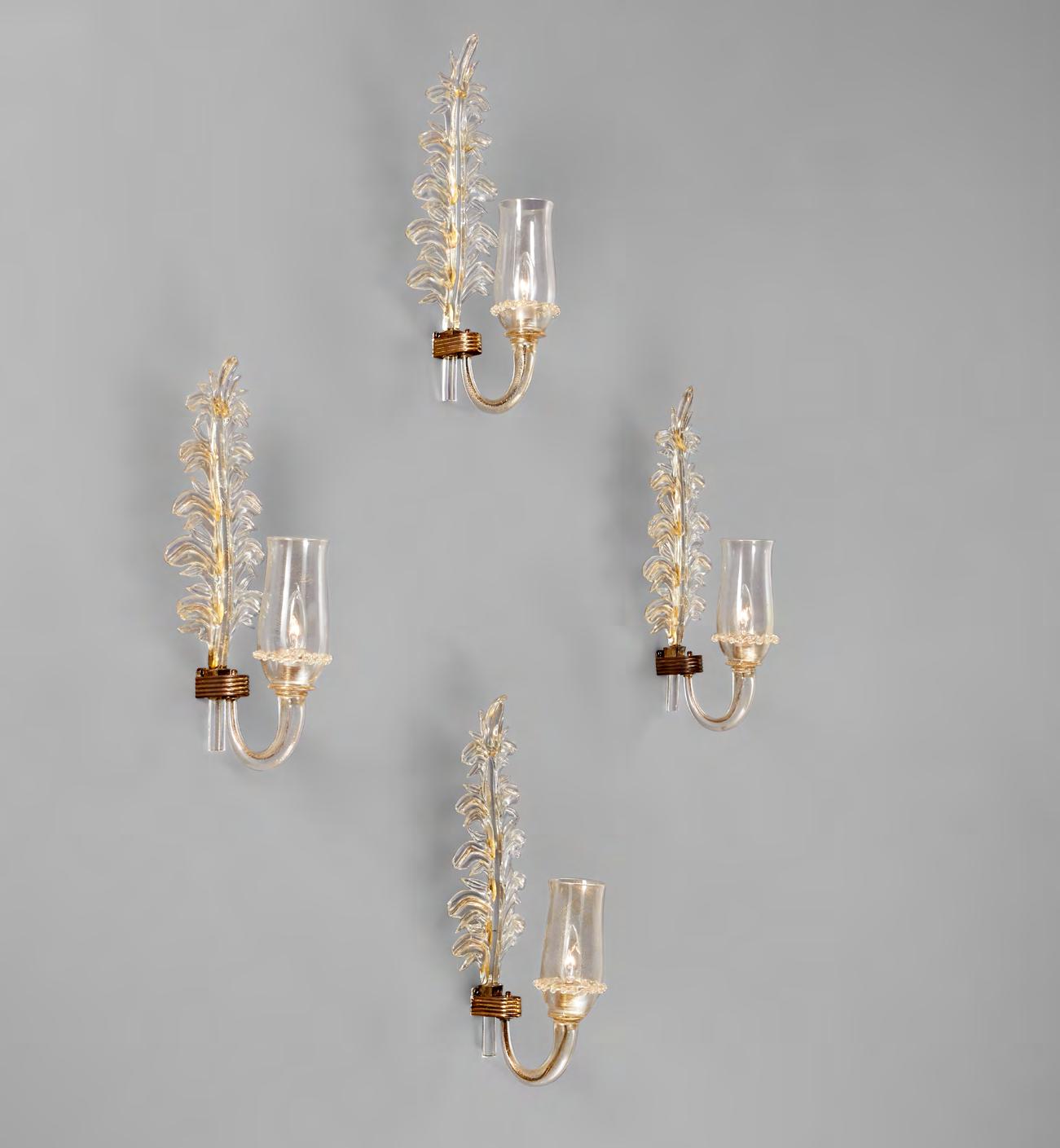
Produced by Seguso Vetri d’Arte, Murano, Italy.
Estimate $7,000-9,000 Provenance Private collection, Milan

Vase, model no. M 3067/M va 6 circa 1923 Brass.
7 3/4 in. (19.7 cm) high Executed by the Wiener Werkstätte, Vienna, Austria. Underside impressed with artist’s monogram, WIENER/WERK/ STÄTTE, and MADE/IN/AUSTRIA
Estimate $4,000-6,000
Private collection, New York Acquired from the above by the present owner, circa 2005
Phillips would like to thank Dr. Christian WittDörring for his assistance cataloguing the present lot. The present model is recorded in the Wiener Werkstätte Archive of the MAK Vienna, under inventory number K.I. 11973-7.
1891-1979, 1890-1973
Pair of armchairs, from Casa Bonomi, Milan circa 1928
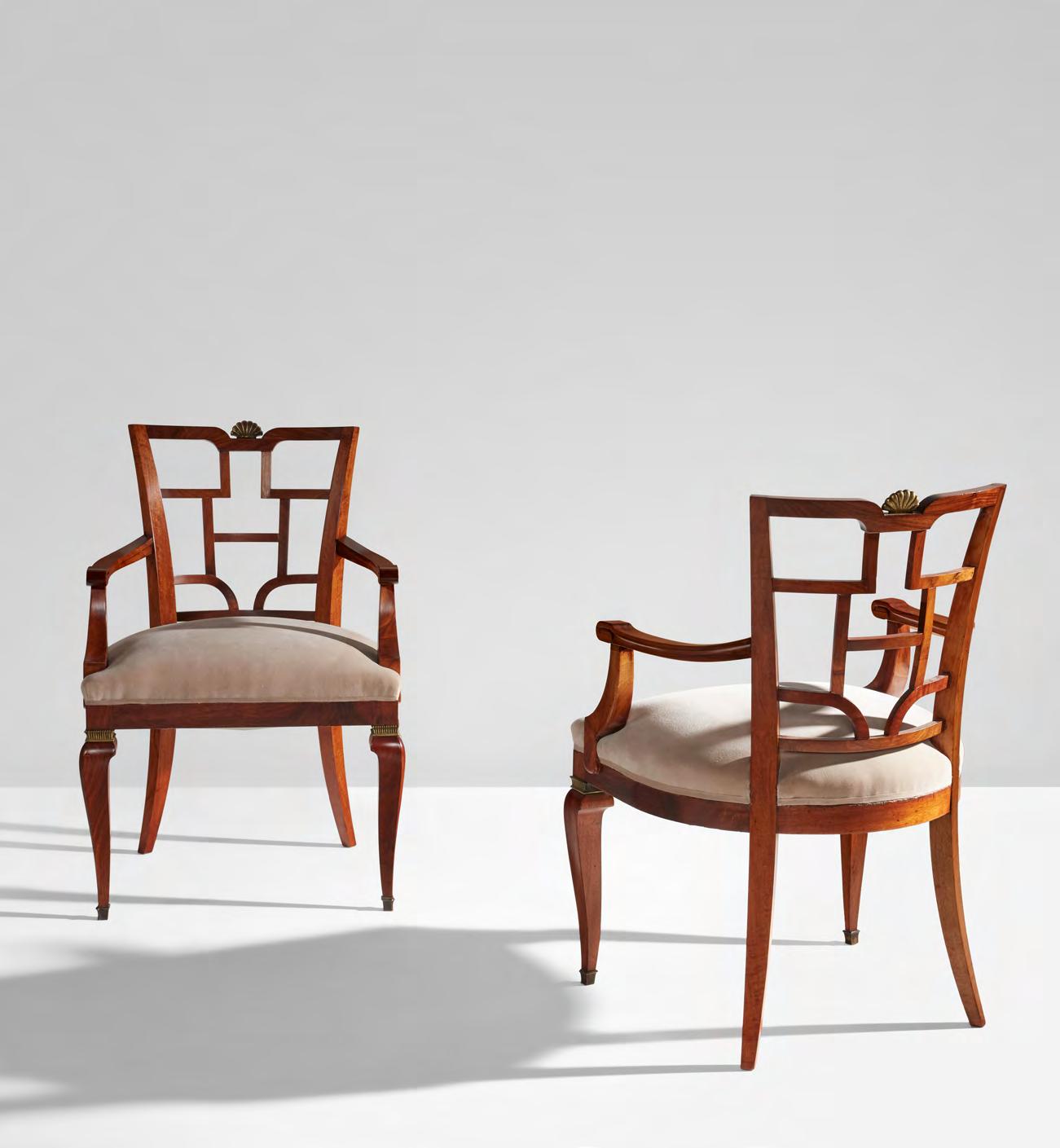
Walnut, brass, fabric upholstery. Each: 35 1/2 x 24 x 20 in. (90.2 x 61 x 50.8 cm)
Produced by Paolo Lietti for Il Labirinto, Milan, Italy. Together with a certificate of expertise from the Gio Ponti Archives.
Estimate $6,000-8,000
“Psiche,” Domus, no. 8, August 1928, p. 35 for a similar example
In 1930, just two years before the dissolution of the Wiener Werkstätte, the German design magazine Deutsche Kunst und Dekoration published an article titled “New Metalwork by Josef Hoffmann” which included illustrations of works with a similar visual vocabulary to the present selection. Praising Hoffmann’s work, the author said, “[The works] are clear and regular in structure—but without lacking that highly personal grace that was Hoffmann’s touch. This grace is achieved with subtle means: it lies in the proportion, in the slight deviations from symmetry, and the mathematical regularity, as well as in the occasional use of curved profiles.” The present selection of works by Josef Hoffmann illustrate the designer’s expert manipulation of brass and silver as well as his tempered yet expressive style.
Hoffmann designed metalworks for the Wiener Werkstätte since its founding in 1903 and, in fact, the metal workshop was the first division of the workshop to operate. Over the course of nearly three decades, Hoffmann created works in metal including flatware, holloware, and functional pieces with perforated, square-patterned decorations called gitterwerk (latticework).
Whereas Hoffmann’s earlier works are often rigorously geometric in form and decoration, his works became more expressive and opulent during the 1920s, perhaps due to the influence of designer Dagobert Peche who joined the firm in 1915 and introduced a certain baroque extravagance to the workshop’s aesthetic. During this period, the designs of the workshop were being sold across Europe and the United States, with a showroom on Fifth Avenue in New York that opened in 1921. The aufsatz (centerpiece in German) exemplifies this tendency through the two scroll-shaped handles. These pieces express the glamour and opulence of the period while remaining true to Hoffman’s rational control of proportion and form.
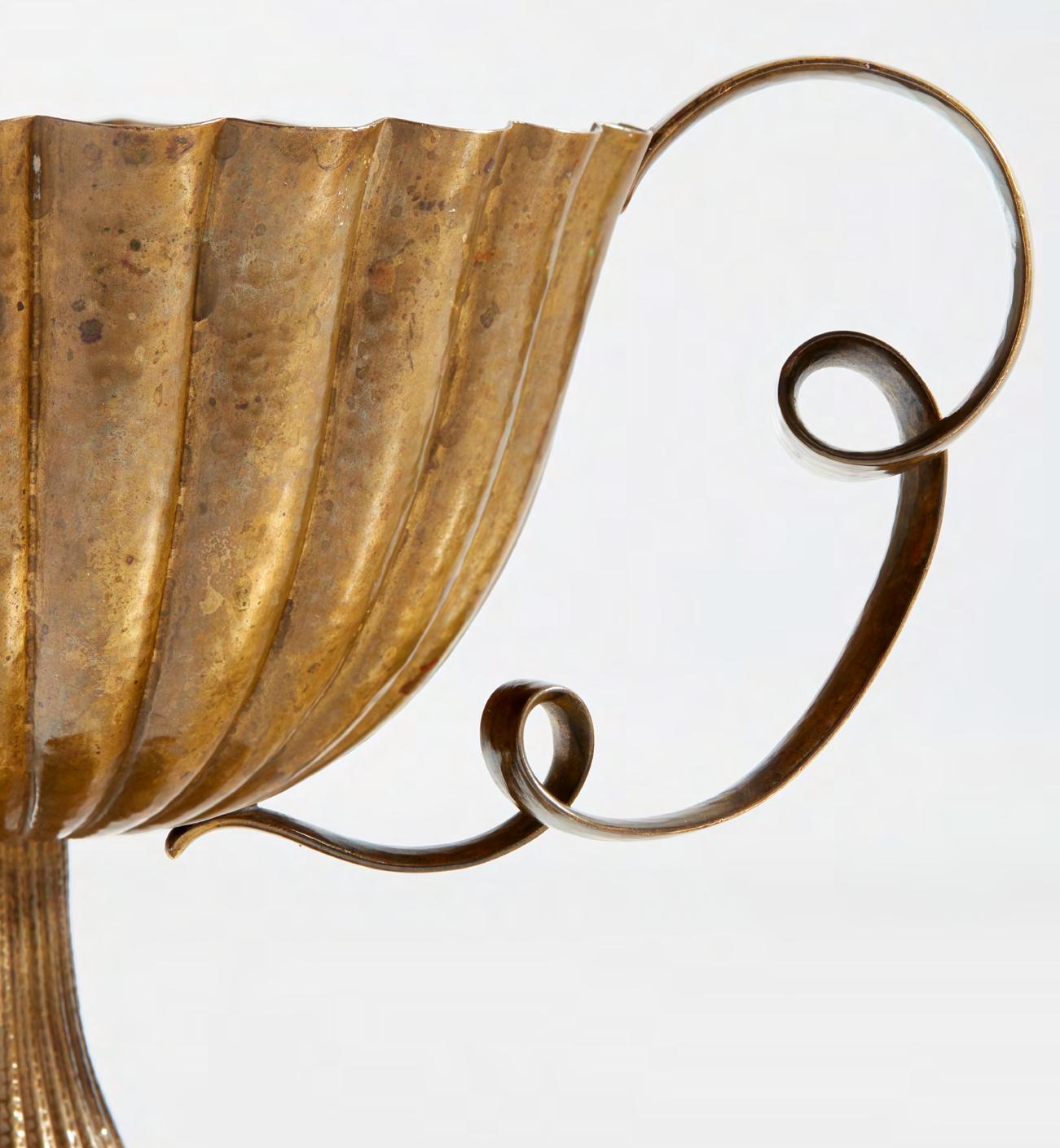
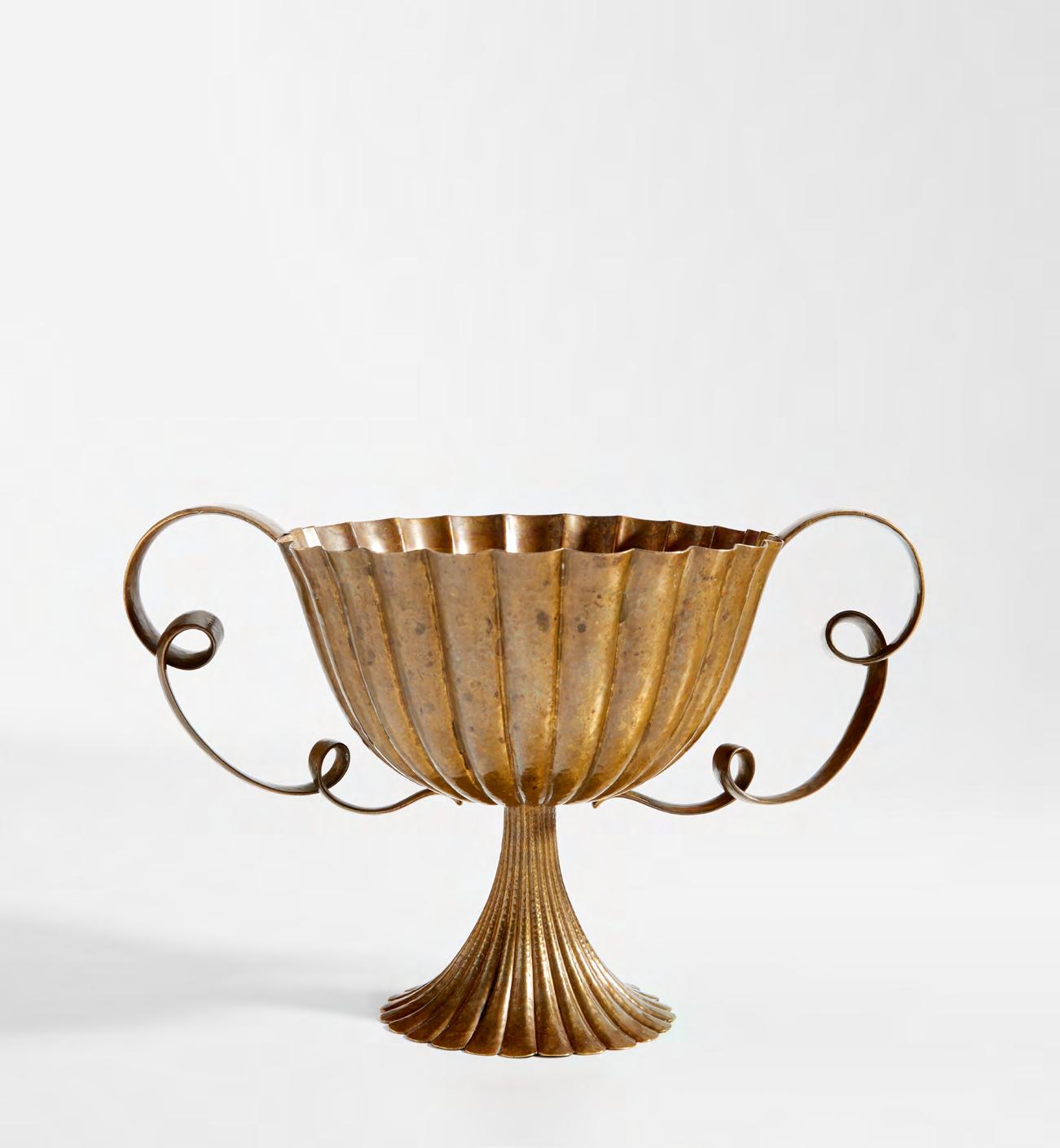
“Aufsatz” centerpiece, model no. M sh 17 designed 1924, executed 1925-1931 Brass.
7 1/2 in. (19.1 cm) high Executed by the Wiener Werkstätte, Vienna, Austria. Lip impressed with artist’s monogram, WIENER/WERK/STÄTTE, and MADE/IN/ AUSTRIA
Estimate
$10,000-15,000
Sotheby’s, New York, “Important 20th Century Design,” December 18, 2004, lot 615
Acquired from the above by the present owner
Werner J. Schweiger, Wiener Werkstätte: Design in Vienna, 1903-1932, New York, 1984, p. 70
Peter Noever ed., Josef Hoffmann Designs, exh. cat., Austrian Museum of Applied Arts, Vienna, 1992, pp. 110, 172 Gabriele Fahr-Becker, Wiener Werkstätte 1903-1932, Cologne, 2003, p. 165
Peter Noever, ed., Yearning for Beauty: The Wiener Werkstätte and the Stoclet House, Ostfildern, 2006, p. 330
Phillips would like to thank Dr. Christian WittDörring for his assistance cataloguing the present lot. The present model is recorded in the Wiener Werkstätte Archive of the MAK Vienna, under inventory number K.I. 12059-9.
Property from a Private South Carolina Collection1891-1979, 1890-1973
Pair of stools, from Casa Bonomi, Milan circa 1928

Walnut, brass, fabric upholstery. Each: 20 1/4 x 20 1/4 x 16 1/2 in. (51.4 x 51.4 x 41.9 cm)
Produced by Paolo Lietti for Il Labirinto, Milan, Italy. Together with a certificate of expertise from the Gio Ponti Archives.
Estimate $4,000-6,000
Provenance
Private collection, Milan
Property of a Lady
82. Albert Cheuret 1884-1966
Ceiling light
circa 1925
Silver-plated brass, alabaster. 22 in. (55.9 cm) drop, 15 in. (38.1 cm) diameter
Lower mount impressed Albert Cheuret.
Estimate $8,000-12,000
Robert Zehil Gallery, Beverly Hills
Acquired from the above by the present owner, 1987
Guillaume Janneau, Le Luminaire et les Moyens d’éclairages Nouveaux, Paris, 1926, pl. 45 for a similar example
The present model ceiling light is documented in archival photographs originally belonging to the Albert Cheuret Estate.
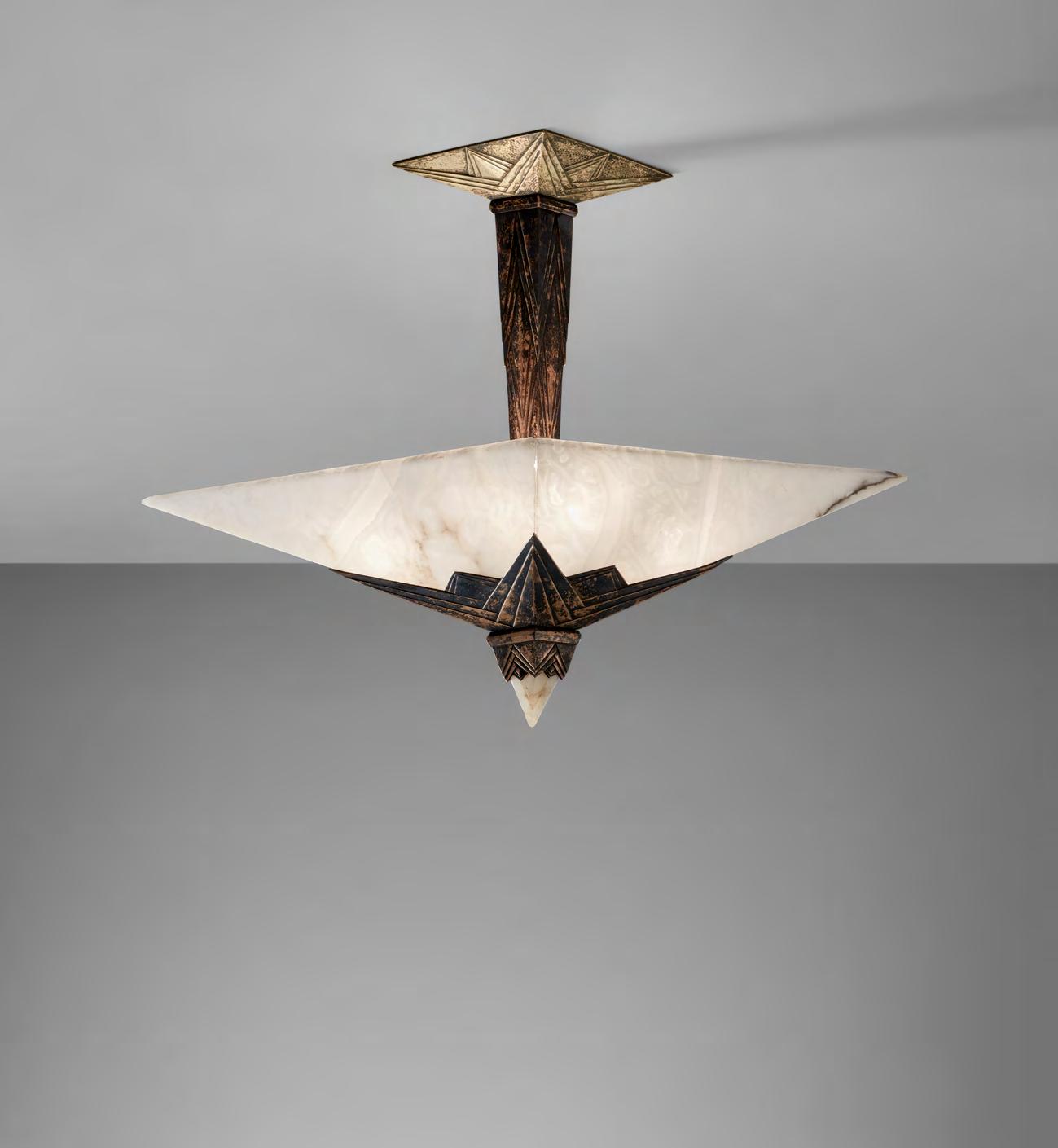
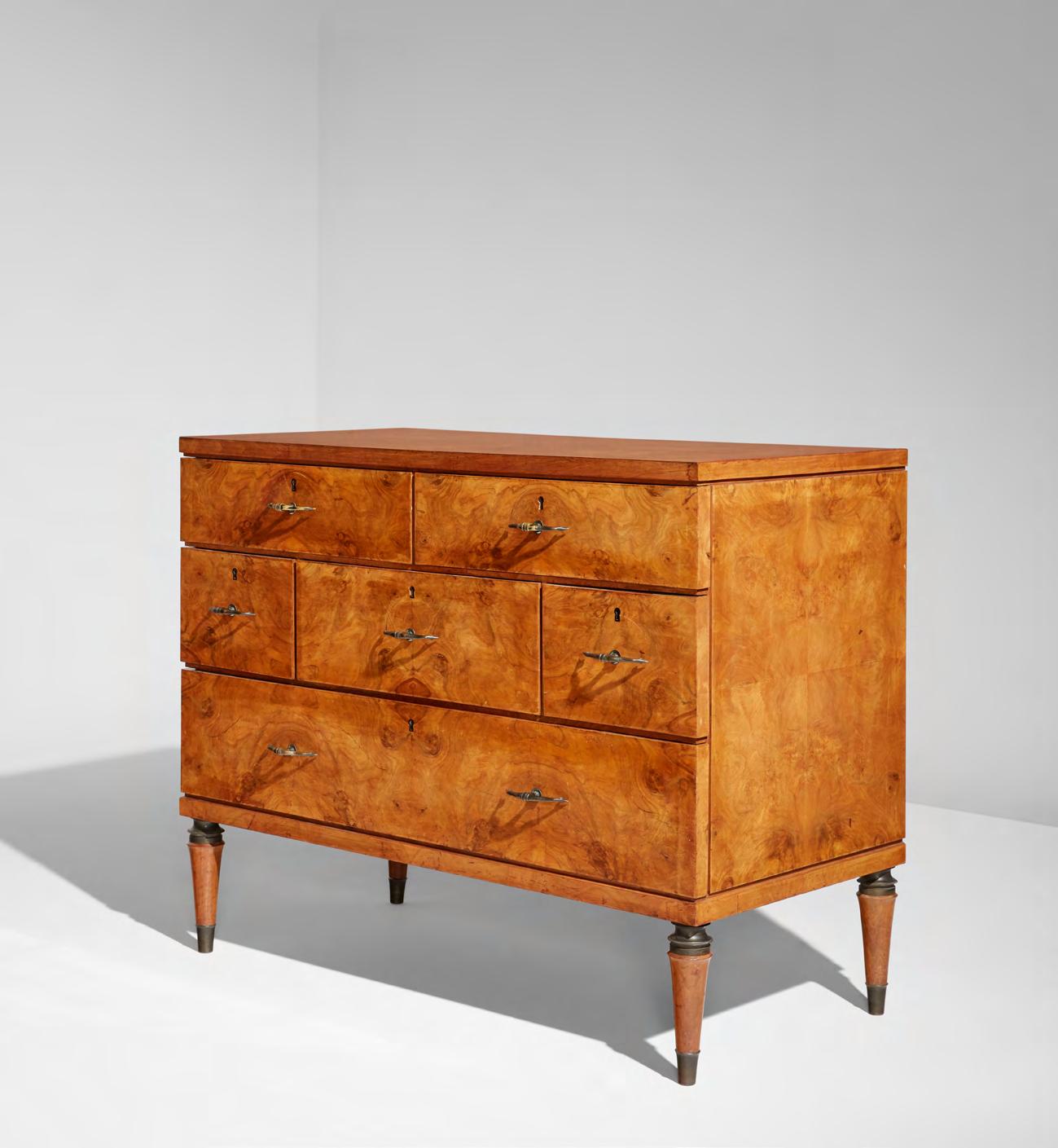
Burl walnut, burl walnut-veneered wood, brass.
36 1/8 x 45 3/8 x 21 3/4 in. (91.8 x 115.3 x 55.2 cm)
Together with a certificate of expertise from the Gio Ponti Archives.
Estimate $10,000-15,000
Jacksons, Stockholm
Acquired from the above by the present owner, 2000
“Psiche,” Domus, no. 8, August 1928, p. 35 for a similar example
Property from a Private Collection, New YorkPair of “Bougeoirs Ekorce Rondelles 03”
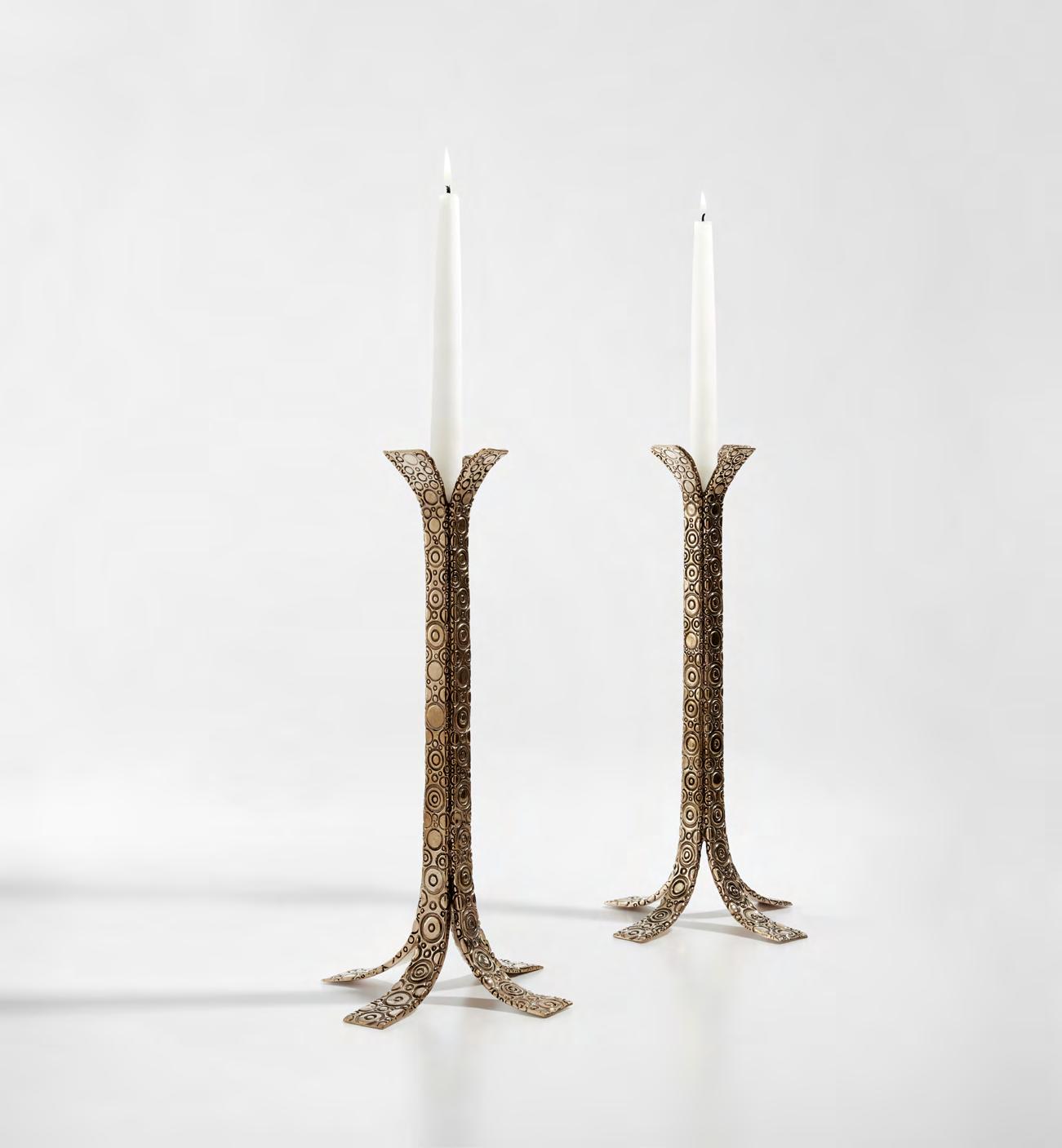
designed 2018, produced 2021 Polished bronze.
Each: 14 3/4 in. (37.5 cm) high Cast by Artist Proof, Mitry-Mory, France. Numbers 3 and 4 from the edition of 500 plus 4 artist’s proofs. Underside of one impressed with artist’s cipher and 3 / 500/AP 2021 and underside of other impressed with artist’s cipher and 4 / 500/AP 2021
$4,000-6,000
Carpenters Workshop Gallery, Paris Acquired from the above by the present owner, 2021
Σ
Unique wall-mounted console table circa 1952
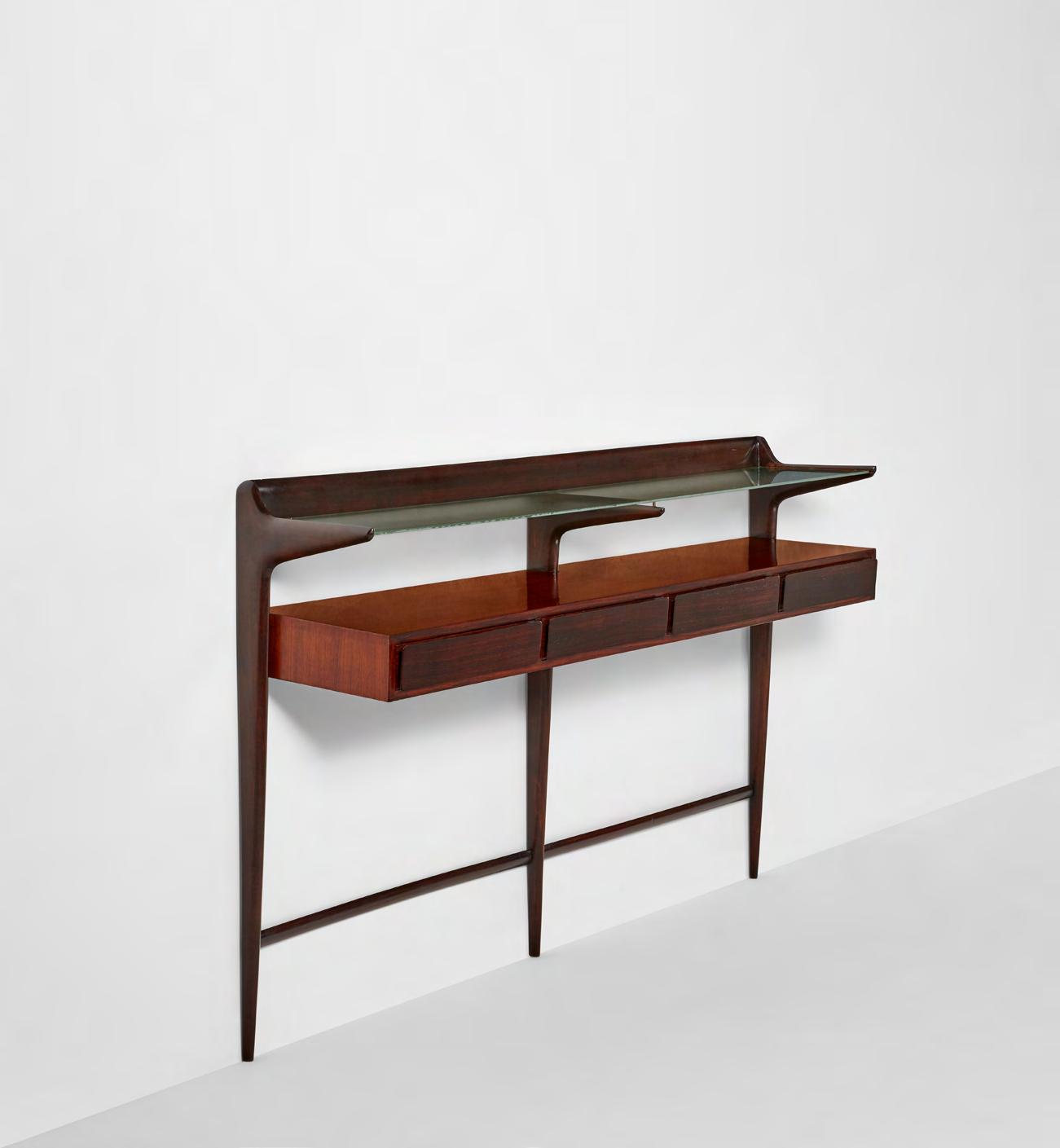
Brazilian rosewood-veneered wood, rosewood, glass.
37 3/4 x 58 1/2 x 13 in. (95.9 x 148.6 x 33 cm) Executed by Ariberto Colombo, Cantù, Italy. Together with a certificate of authenticity from the Archivio del Design di Ico Parisi.
Estimate $15,000-20,000
Ariberto Colombo, Cantù
Roberta Lietti, Ico Parisi Catalogue Raisonné, 1936-1960, Milan, 2017, illustrated p. 320
Phillips would like to thank Roberta Lietti of the Archivio del Design di Ico Parisi for her assistance cataloguing the present lot.
Pair of wall lights circa 1958 Glass, brass.

Each: 18 1/4 x 7 1/2 x 3 1/4 in. (46.4 x 19.1 x 8.3 cm)
Manufactured by Fontana Arte, Milan, Italy.
Estimate $5,000-7,000
Esempi del 900, Milan
Acquired from the above, 1994 Acquired from the above by the present owner, 2000
Vitrum: Lastre di vetro e cristallo, no. 100, February 1958, p. 41
Laura Falconi, ed., Luci e Trasparenze: Fontana Arte Millenovecentotrentamillenovecentocinquanta, exh. cat., Galleria Babuino Novecento, Rome, 2006, pp. 57, 91
Side table
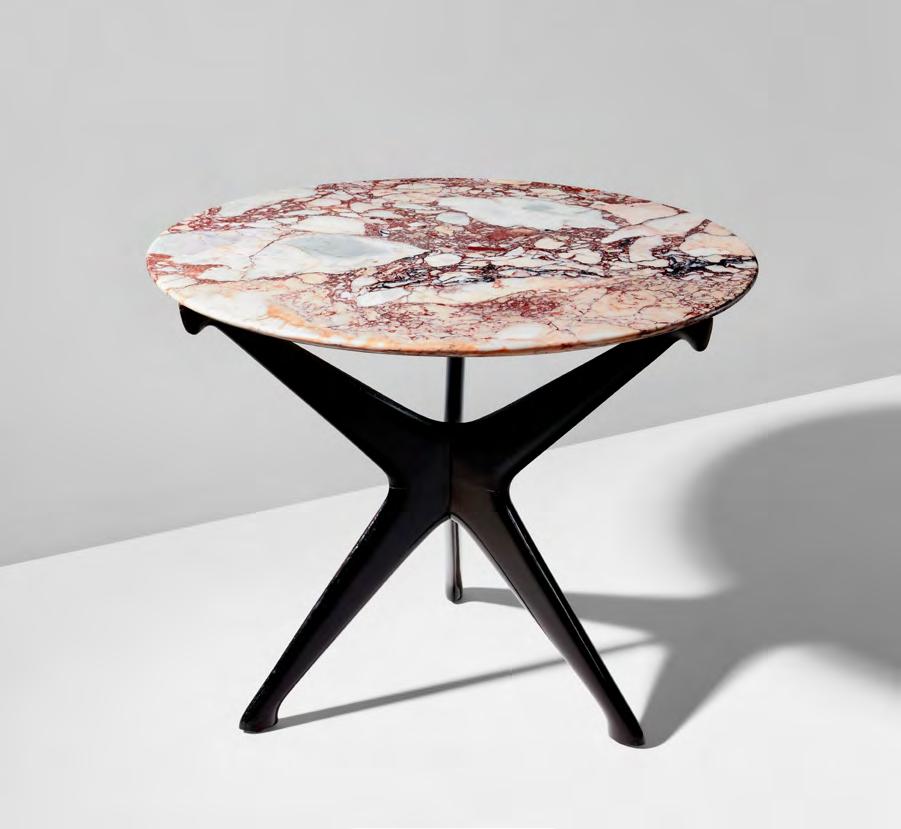
circa 1950
Marble, painted wood.
21 1/4 in. (54 cm) high, 26 in. (66 cm) diameter
Manufactured by Fratelli Rizzi, Capiago Intimiano, Italy.
Estimate $4,000-6,000
Provenance Private collection, Milan
Roberta Lietti, Ico Parisi Catalogue Raisonné, 1936-1960, Milan, 2017, p. 356
Phillips would like to thank Roberta Lietti of the Archivio del Design di Ico Parisi for her assistance cataloguing the present lot.
“Caleidoscopio” floor lamp circa 1970
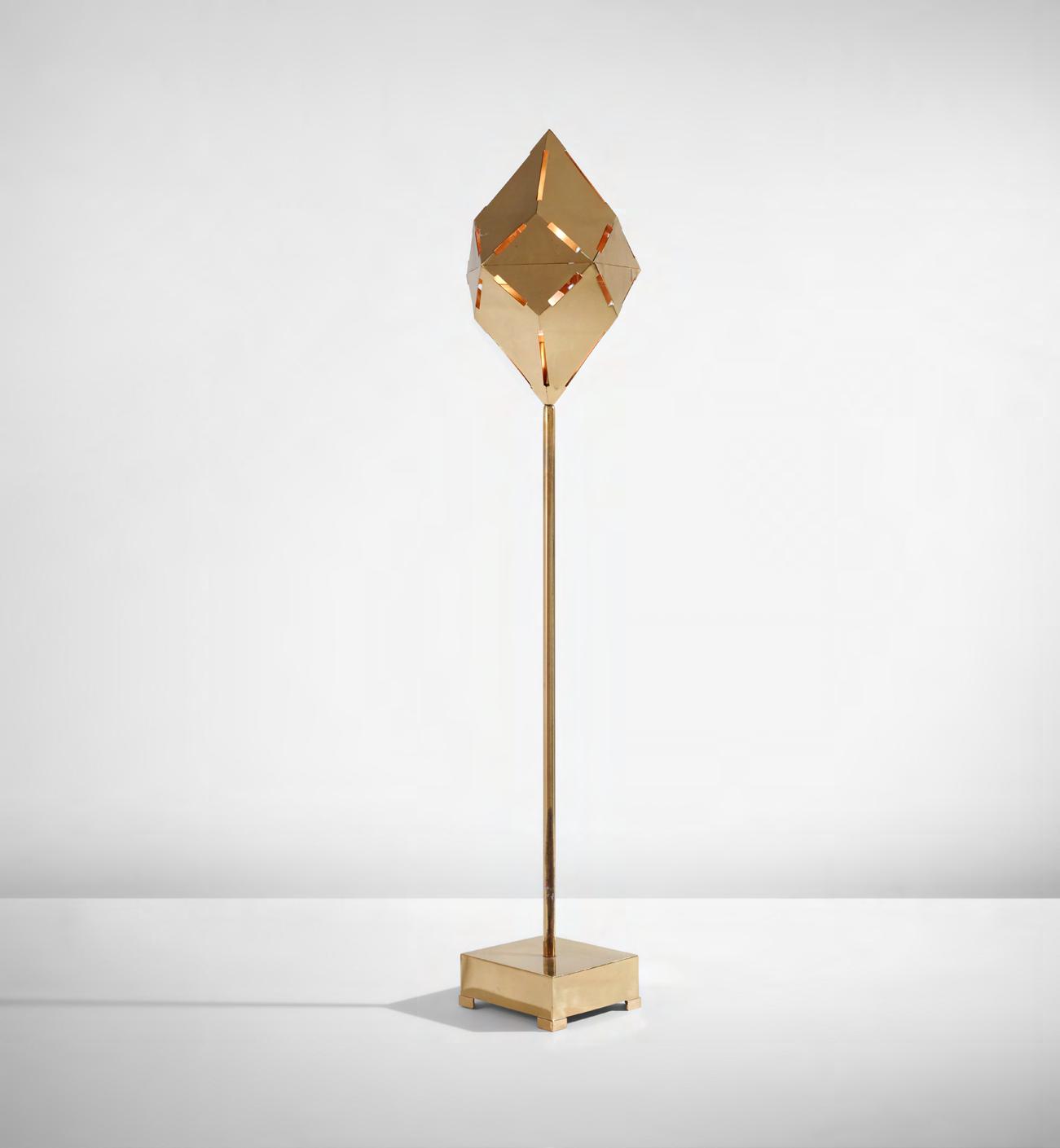
Brass.
50 in. (127 cm) high Edge of base impressed with facsimile signature Gabriella Crespi and BREV Together with a certificate of authenticity from the Archivio Gabriella Crespi.
Estimate $4,000-6,000
Provenance Private collection, Milan
Literature
Gabriella Crespi: The Sign and the Spirit, Multiple Furniture, Sculptures and Jewelry, exh. cat., Palazzo Reale di Milano, Milan, 2011, pp. 14, 39, 94
The present lot has been authenticated by the Archivio Gabriella Crespi and is recorded under archive number 040449075G.

Table
circa 1931
Walnut, walnut-veneered wood, glass. 29 x 47 1/8 x 27 1/2 in. (73.7 x 119.7 x 69.9 cm) Manufactured by Luigi Fontana & C., Milan, Italy. Underside of glass top twice ink stamped L. FONTANA & C./1931 Together with a certificate of expertise from the Gio Ponti Archives.
Three “3 Lune” ceiling lights circa 1961 Brass, glass.
Each: 9 x 51 x 24 in. (22.9 x 129.5 x 61 cm) Manufactured by Arredoluce, Monza, Italy.
Estimate $15,000-20,000
Provenance Private collection, Milan
Alessandro Padoan, Alessandro Palmaghini and Anty Pansera, Arredoluce: Catalogo Ragionato 1943-1987, Milan, 2018, p. 342
The present lot has been registered in the Arredoluce Archives, Italy as numbers 2306977, 2517025, and 4770706.

Ceiling light, model no. 5294 circa 1936
Cordonato glass, chromium-plated metal. 39 in. (99.1 cm) drop, 21 in. (53.3 cm) diameter
Produced by Venini & C., Murano, Italy.
Estimate $10,000-15,000
Private collection, Sorrento
Anna Venini Diaz de Santillana, Venini: Catalogue Raisonne 1921-1986, Milan, 2000, p. 260
Franco Deboni, Venini Glass: Its history, artists and techniques, Catalogue 1921-2007, Vol. 1, Turin, 2007, The Blue Catalogue (appendix), n.p.
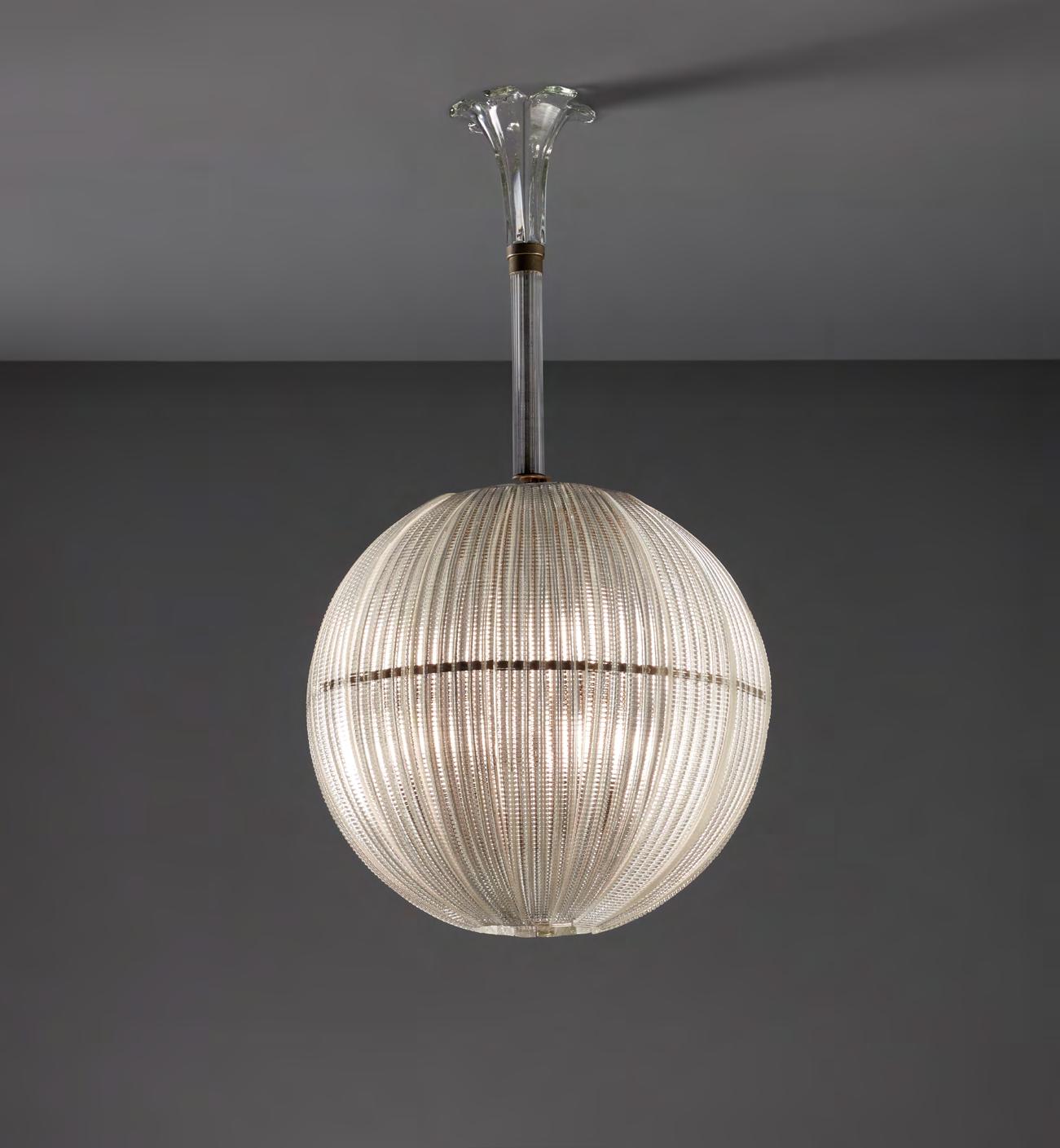
Auction & Viewing Location
432 Park Avenue, New York, NY 10022
Wednesday, 7 December at 2pm
Viewing
1–7 December 2022
Monday–Saturday 10am–6pm Sunday 12pm–6pm
When sending in written bids or making enquiries please refer to this sale as NY050522 or Design.
Absentee and Telephone Bids
Tel +1 212 940 1228 Fax +1 212 940 1749 bidsnewyork@phillips.com
Auction License 2013224
Hugues Joffre - 2028495 Sarah Krueger - 1460468 Henry Highley - 2008889 Jonathan Crockett - 2056239 Rebecca Tooby-Desmond - 2058901 Aurel Bacs – 2047217 Blake Koh – 2066237 Susanna Brockman – 2058779 Rebekah Bowling - 2078967
Catalogues
catalogues@phillips.com New York +1 212 940 1240 London +44 20 7318 4024 Hong Kong +852 2318 2000 $35/€25/£22 at the gallery
Client Accounting
Sylvia Leitao +1 212 940 1231
Client Services 432 Park Avenue +1 212 940 1200
Steve Orridge +1 212 940 1370 Anaar Desai +1 212 940 1320
Photography
Kent Pell
Head of Department, New York Cordelia Lembo clembo@phillips.com
Head of Design, West Coast, Senior International Specialist Meaghan Roddy mroddy@phillips.com
Senior International Specialist Beth Vilinsky bvilinsky@phillips.com
Specialist Kimberly Sørensen ksorensen@phillips.com
Associate Specialist, Associate Head of Sale Benjamin Green bgreen@phillips.com
Administrator Cecilia Moure cmoure@phillips.com
Anastassiades, M. 50 Arad, R. 45
Bertoia, H. 51 Bloc, A. 3 Burton, S. 43
Campana, F. 32 Campana, H. 32 Castle, W. 44 Cheuret, A. 82 Crespi, G. 88
Donat, I. 26 Dunand, J. 24
Fontana Arte 69, 86 Frey, V. 40 Giacometti, A. 23
Hadid, Z. 37 Hansen, F. 4 Hoffmann, J. 76, 78, 80
Ingrand, M. 1, 73
Joan, M. 10 Juhl, F. 72
Kagan, V. 41, 42
Lalanne, C. 13 Lalanne, F.-X. 14 Lalique, M. 15 Lancia, E. 79, 81, 83 Lane, D. 52, 53, 54 Lassen, F. 28, 29 Lelii, A. 71, 75, 90
Martinuzzi, N. 7
Nagle, R. 34, 35, 36 Nakashima, G. 64, 65, 66, 68
Parisi, I 5, 85, 87
Ponti, G. 67, 70, 74, 79, 81, 83, 89 Price, K. 38
Rava, C. E. 12 Rie, L. 25 Rietveld, G. 46, 47 Robsjohn-Gibbings, T. H. 55 Royère, J. 8, 9, 11 Ruhlmann, E.-J. 17
Salto, A. 30 Sarfatti, G 2 Scarpa, C 91 Seguso 77 Sottsass, Jr., E. 39
Takaezu, T. 58, 59, 60, 61, 62, 63 Takahama, K. 14 Tiffany Studios 16
van der Straeten, H. 27 Venini 6 Vodder, A. 31 Voulkos, P. 56, 57
de Waal, E. 20, 21 Wegner, H. J. 22 Wright, F. L. 48
de Zanine Caldas, Z. 33 Zimmerman, J. 18
Each Phillips auction is governed by the applicable Conditions of Sale and Authorship Warranty.
All prospective bidders should read these sections carefully. They govern the purchasing agreement under which you buy at auction from Phillips. They may be also amended by saleroom addendum or auctioneer’s announcement during the auction. The complete Conditions of Sale and Authorship Warranty applicable to this auction (Version October 15, 2020) are found online at phillips.com, along with detailed information on each lot.
Pre-sale estimates are intended as a guide for prospective Buyers and are based upon the condition, rearity, quality, provenance of the lot, and on prices recently paid at auction for similar property. Any bid within the high and low estimate range should, in our opinion, o er a chance of success. However, many lots achieve prices below or above the pre-sale estimates. Where “Estimate on Request” appears, please contact the specialist department for further information. It is advisable to contact us closer to the time of the auction as estimates can be subject to revision. Pre-sale estimates do not include the buyer’s premium or any applicable taxes.
Phillips charges the successful bidder a commission, or buyer’s premium, on the hammer price of each lot sold. The buyer’s premium is payable by the buyer as part of the total purchase price at the following rates: 26% of the hammer price up to and including $600,000, 21% of the portion of the hammer price above $600,000 up to and including $6,000,000 and 14.5% of the portion of the hammer price above $6,000,000.
Phillips does not warrant or guarantee condition on any lot. Solely as a convenience to clients, Phillips may provide condition reports on many lots, which are also available online on the lot detail pages. If there is not a condition report available, that is not a representation that a lot is in perfect condition. While condition reports are prepared honestly and carefully, our staff are not professional restorers or trained conservators. We therefore encourage all prospective buyers to inspect all lots at our pre-sale exhibitions, and contact our staff with any questions.
The auctioneer may, at his or her own option, bid on behalf of the seller up to, but not including the lot’s reserve or above the reserve, either by making consecutive bids or by making bids in response to other bidders. The auctioneer will not identify these bids made on behalf of the seller. You may bid in the auction in person, online, on the phone, or by placing an absentee bid. The easiest way to arrange or register to bid at auction is to set up a client account online. Go to our homepage, phillips.com and fill out the account form. When you want to register for an auction, click Register on sale pages or lot detail pages, and you’ll confirm your account details, be asked for a credit card number for identification purposes and our Bids Department will process your request. We recommend
registering at least 24 hours prior to sale to ensure that you can bid. Good luck!
As a free service for buyers, Phillips will wrap purchased lots for hand carry only. Alternatively, we will either provide packing, handling and shipping services or coordinate with shipping agents in order to facilitate such services for property purchased at Phillips. In the event that the property is collected in New York by the buyer or the buyer’s designee (including any private carrier) for subsequent transport out of state, Phillips may be required by law to collect New York sales tax, regardless of the lot’s ultimate destination. Please refer to Paragraph 17 of the Conditions of Sale for more information.
Some lots are sold under special conditions. Phillips uses the following symbols to designate these lots:
Lots designated with the symbol [O] are the subject of a minimum price guarantee. In such cases Phillips has guaranteed to the seller of the lot that regardless of the outcome of the sale the seller shall receive no less than a minimum sum. This guarantee may be provided solely by Phillips or jointly with a third party.
Where Phillips has agreed to a minimum price guarantee it assumes the nancial risk of a lot failing to sell or selling for less than the minimum price guarantee. Because the sums involved can be signi cant Phillips may choose to share the burden of that nancial risk with a third party. The third party shares the risk by committing in advance of the sale, usually by way of a written bid, to buy the lot for an agreed amount whether or not there are competing bidders for the lot. If there are competing bidders third party guarantors may also bid above any written bid. In this way the third party guarantor assumes the risk of the bidding not reaching the amount of the minimum price guarantee.
In return for underwriting or sharing this risk Phillips will usually compensate the third party. The compensation may be in the form of a xed fee or an amount calculated by reference to the hammer price of the lot. If the third party guarantor is the successful bidder they will be required to pay the full hammer price and buyer’s premium and will not be otherwise compensated.
Phillips requires third party guarantors to disclose their nancial interest in the lot to anyone whom they are advising. If you are contemplating bidding on a lot which is the subject of a third party guarantee and you are being advised by someone or if you have asked someone to bid on your behalf you should always ask them to con rm whether or not they have a nancial interest in the lot.
∆ Property in Which Phillips Has an Ownership Interest Lots with this symbol indicate that Phillips owns the lot in whole or in part or has an economic interest in the lot equivalent to an ownership interest.
Unless indicated by a •, all lots in this catalogue are offered subject to a reserve. A reserve is the confidential value established between Phillips and the seller and below which a lot may not be sold. The reserve for each lot will not exceed the low pre-sale estimate.
Items made of or incorporating certain designated plant or animal material, including but not limited to coral, crocodile, ivory, whalebone, Brazilian rosewood, rhinoceros horn or tortoiseshell, (irrespective of age, percentage, or value), may require a license or certificate prior to exportation and additional licenses or certificates upon importation to any foreign country. Please note that the ability to obtain an export license or certificate does not ensure the ability to obtain an import license or certificate in another country, and vice versa. We recommend that prospective bidders check with their own local restrictions regarding such requirements prior to placing a bid. It is the buyer’s sole responsibility to obtain any necessary export or import licenses or certificates as well as any other required documentation. Please note that lots containing potentially regulated plant or animal material are marked as a convenience to our clients, but Phillips does not accept liability for errors or for failing to mark lots containing protected or regulated species.
Our Privacy Policy is available at www.phillips.com or by emailing dataprotection@phillips.com and sets out: (i) the types of personal data we will or may collect and process; (ii) the purposes for which we will or may process your personal data; (iii) the lawful bases we rely on when processing your personal data; (iv) your rights in respect of our processing of your personal data; and (v) various other information as required by applicable laws.
Phillips premises, sale, and exhibition venues are subject to CCTV video surveillance and recording for security, client service and bid monitoring purposes. Phillips’ auctions will be filmed for simultaneous live broadcast on Phillips’ and third party websites and applications.
Your communications with Phillips, including by phone and online (e.g. phone and on-line bidding) may be recorded for security, client service and bid monitoring purposes. Where we record such information we will process it in accordance with our Privacy Policy.
10022
+1 212 940 1200
• Private purchases: Proof of identity in the form of government-issued identification and proof of address will be required.
By submitting this form, you con rm your registration/bid(s) as above and accept the Conditions of Sale of Phillips for the auction, available on www.phillips.com.
• Company purchases: If you are buying under a business entity, we require a copy of government-issued identification (such as the certificate of incorporation) as well as proof of owners and directors to verify the status of the company.
• Conditions of Sale: All bids are placed and executed, and all lots are sold and purchased, subject to the Conditions of Sale published online at www.phillips.com. Please read them carefully before placing a bid. Your attention is drawn to Paragraph 4 in the Conditions of Sale.
• If you cannot attend the sale, we can execute bids confidentially on your behalf.
• Phillips charges the successful bidder a commission, or buyer’s premium, on the hammer price of each lot sold. The buyer’s premium is payable by the buyer as part of the total purchase price at the following rates: 26% of the hammer price up to and including $600,000, 21% of the portion of the hammer price above $600,000 up to and including $6,000,000 and 14.5% of the portion of the hammer price above $6,000,000.
• “Buy” or unlimited bids will not be accepted. Alternative bids can be placed by using the word “OR” between lot numbers.
• For absentee bids, indicate your maximum limit for each lot, excluding the buyer’s premium and any applicable sales or use tax. Your bid will be executed at the lowest price taking into account the reserve and other bidders. On no reserve lots, in the absence of other bids, your bid will be executed at approximately 50% of the low pre-sale estimate or at the amount specified, if less than 50% of the low estimate.
• Your bid must be submitted in the currency of the sale and may be rounded down to the nearest amount consistent with the auctioneer’s bidding increments.
• If we receive identical bids, the first bid received will take precedence.
• Arranging absentee and telephone bids is a free service provided by us to prospective buyers. While we will exercise reasonable care in undertaking such activity, we cannot accept liability for errors relating to execution of your bids except in cases of willful misconduct. Agreement to bid by telephone must be confirmed by you promptly in writing or by fax. Telephone bid lines may be recorded.
• Please submit your bids to the Bid Department by email to bidsnewyork@phillips.com or by fax at +1 212 924 1749 at least 24 hours before the sale. You will receive confirmation by email within one business day. To reach the Bid Department by phone please call +1 212 940 1228.
• Absent prior payment arrangements, please provide a bank reference. Payment can be made by cash (up to $2,000, per calendar year), credit card (up to $30,000), money order, wire transfer, bank check or personal check with identification, drawn on US banks.
• Lots cannot be collected until payment has cleared and all charges have been paid.
• By signing this Bid Form, you acknowledge and understand that we may process your personal data (including potentially special category data) in accordance with Phillips’s Privacy Policy as published at www.phillips. com or available by emailing dataprotection@phillips.com.
• Phillips’s premises may be subject to video surveillance and recording. Telephone calls (e.g., telephone bidding) may also be recorded. We may process that information in accordance with our Privacy Policy.
Please check this box to receive emails about upcoming sales, exhibitions, and special events o ered by members of the Phillips group, as referenced in our Privacy Policy available on our website at www.phillips.com, where you may also update your email preferences or unsubscribe at any time.
